HID Global X001800B Laminate (film) RFID 13.56MHz Radio Module User Manual Using the Photo option
HID Global Corporation Laminate (film) RFID 13.56MHz Radio Module Using the Photo option
user manual
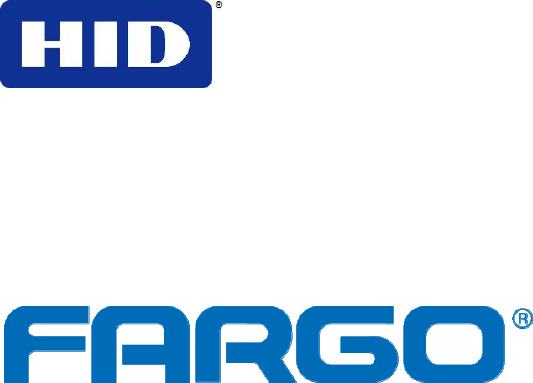
15370 Barranca Parkway
Irvine, CA 92618-2215
USA
DTC4500 User Guide
P/N: L001444
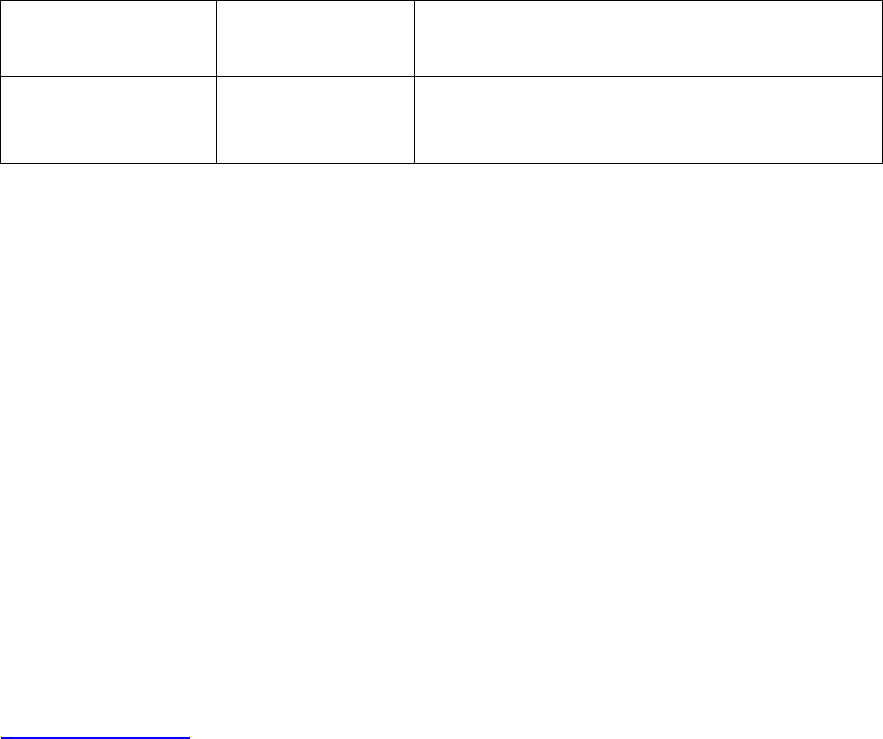
© 2010 HID Global Corporation All rights reserved
DTC4500 Card Printer/Encoder User Guide (Rev 1.0), © 2010 property of HID Global Corporation. All
rights reserved.
Exclusive permission is granted to authorized resellers of HID Global products to reproduce and
distribute this copyrighted document to authorized HID Global customers, who have signed a no
disclosure agreement regarding the restricted, proprietary use of said document.
The revision number for this document will be updated to reflect changes, corrections, updates and
enhancements to this document.
Revision Control
Number Date Document Title
Revision 1.0 March 2010 DTC4500
Card Printer/Encoder User Guide
Trademarks and Disclaimers
HID, HID Global, and Fargo are the trademarks or registered trademarks of HID Global Corporation in
the U.S. and other countries.
The information contained in this document is provided AS IS without any warranty.
HID Global hereby disclaims all warranties and conditions with regard to the information contained
herein, including all implied warranties of merchantability, fitness for a particular purpose, title and non-
infringement.
In no event shall HID Global be liable, whether in contract, tort or otherwise for any indirect, special or
consequential damages arising from the use of the information contained in this document.
Any questions regarding changes, corrections, updates or enhancements to this document should be
forwarded to:
Hid Global
Support Services
6533 Flying Cloud Drive
Eden Prairie, MN 55344 (USA)
(866)607-7339 Ext #6
FAX: (952) 946-8492
www.hidglobal.com
DTC4500 Card Printer/Encoder User Guide 2
© 2010 HID Global Corporation All rights reserved
Table of Contents
DTC4500 User Guide ______________________________________________________________________ 1
Section 1: Specifications ___________________________________________________________________ 5
Regulatory Compliances ___________________________________________________________________________ 5
Agency Listings__________________________________________________________________________________ 6
United States__________________________________________________________________________________ 6
Canada ______________________________________________________________________________________ 6
Safety Messages (review carefully)___________________________________________________________________ 7
Environmental Protection (China-RoHS) ______________________________________________________________ 8
Traditional Chinese RF Emissions and Safety Statements _______________________________________________ 8
Simplified Chinese _____________________________________________________________________________ 9
Technical Specifications __________________________________________________________________________ 10
Functional Specifications__________________________________________________________________________ 13
Printer Components: Print Ribbons _______________________________________________________________ 13
Ribbon Types/Count Table______________________________________________________________________ 14
Printer Components: Blank Cards ________________________________________________________________ 15
Section 2: Setup and Installation Procedures _________________________________________________ 16
Choosing a Good Location ________________________________________________________________________ 16
About Moisture Condensation ___________________________________________________________________ 16
Unpacking and Inspection_______________________________________________________________________ 16
Installing the Print Ribbon Cartridge (DTC4500) _______________________________________________________ 17
Installing the Ribbon___________________________________________________________________________ 17
Installing Blank Cards into the Card Hopper (DTC4500)_________________________________________________ 19
Using the Single and Dual Hopper ________________________________________________________________ 19
Setting the Card Size for CR79 and CR80_____________________________________________________________ 23
Connecting the Printer power ______________________________________________________________________ 27
Section 3: Print Driver Installation_________________________________________________________ 28
Driver Installation Instructions _____________________________________________________________________ 28
Section 4: Printer Preferences Tab Functions ________________________________________________ 29
|contextid=30 Using the Card tab __________________________________________________________________ 29
Using the Toolbox Options ________________________________________________________________________ 30
|contextid=150 Using the Configuration Tab __________________________________________________________ 31
|contextid=151 Selecting the Calibrate Laminator tab____________________________________________________ 32
Using the Event Monitoring Group Box ______________________________________________________________ 34
Reviewing the Ribbon Low message ______________________________________________________________ 34
|contextid=152 Selecting the Calibrate Ribbon tab ______________________________________________________ 35
|contextid=154 Selecting the Clean Printer tab _________________________________________________________ 37
|contextid=155 Selecting the Advanced Settings tab_____________________________________________________ 38
|contextid=40Using the Device Options tab ___________________________________________________________ 46
|contextid=50Using the Image Color tab ______________________________________________________________ 49
|contextid=51Using the Image Calibrate tab ___________________________________________________________ 52
|contextid=70Using the Magnetic Encoding Tab________________________________________________________ 53
Using the Magnetic Encoding Tab – ISO Standards___________________________________________________ 54
Using the Magnetic Encoding Tab – Custom Encoding or Raw Binary Encoding Mode ______________________ 56
Reviewing the ISO Track Locations_______________________________________________________________ 57
Reviewing the Sample String ____________________________________________________________________ 58
Sending the Track Information ___________________________________________________________________ 59
Reviewing the ASCII Code and Character Table _____________________________________________________ 60
|contextid=80Using the Lamination tab ______________________________________________________________ 62
|contextid=90 Using the Overlay / Print Area tab _______________________________________________________ 62
DTC4500 Card Printer/Encoder User Guide 3
© 2010 HID Global Corporation All rights reserved
|contextid=100Using the K Panel Resin tab ___________________________________________________________ 66
|contextid=120Using the Printer Info tab______________________________________________________________ 69
Section 5: Selecting the Fluorescent Panel Ribbon Type________________________________________ 70
Creating a Custom Fluorescent Image (using the YMCFKO Ribbon) _____________________________________ 70
Configuring Fluorescent Data (F-Panel for YMCFKO Ribbon) using the Application ________________________ 72
Section 6: System Overview- Troubleshooting ________________________________________________ 76
Reviewing the DTC4500 Sequence of Operations ______________________________________________________ 76
Reviewing the DTC4500 Sequence of Operations ____________________________________________________ 77
Section 7: Troubleshooting________________________________________________________________ 78
Printer Error Button and Display Message Table _______________________________________________________ 78
Using the Error Message Table _____________________________________________________________________ 80
Troubleshooting with the Error Message Table_________________________________________________________ 82
Printer Specific Tools (DTC4500)___________________________________________________________________ 92
Additional Printer Specific Tools (DTC4500) _______________________________________________________ 93
Section 8: Cleaning ______________________________________________________________________ 94
Safety Messages (review carefully) _______________________________________________________________ 94
DTC4500 Card Printer/Encoder Cleaning Kit _______________________________________________________ 95
Printhead Cleaning ____________________________________________________________________________ 96
Cleaning the Platen and the Card Feed Rollers_______________________________________________________ 97
Cleaning the Printer’s Interior____________________________________________________________________ 99
Cleaning the Printer’s Exterior ___________________________________________________________________ 99
Section 9: Firmware Upgrades____________________________________________________________ 100
Upgrade the Printer Firmware _____________________________________________________________________ 100
Section 10: HID Global Technical Support__________________________________________________ 103
Reading the Serial Numbers on a Fargo Printer _______________________________________________________ 104
Appendix A ____________________________________________________________________________ 105
Using the Defined Area Option ____________________________________________________________________ 105
Configuring Fluorescent Data (F-Panel for YMCFKO Ribbon) using the Workbench _________________________ 106
DTC4500 Card Printer/Encoder User Guide 4
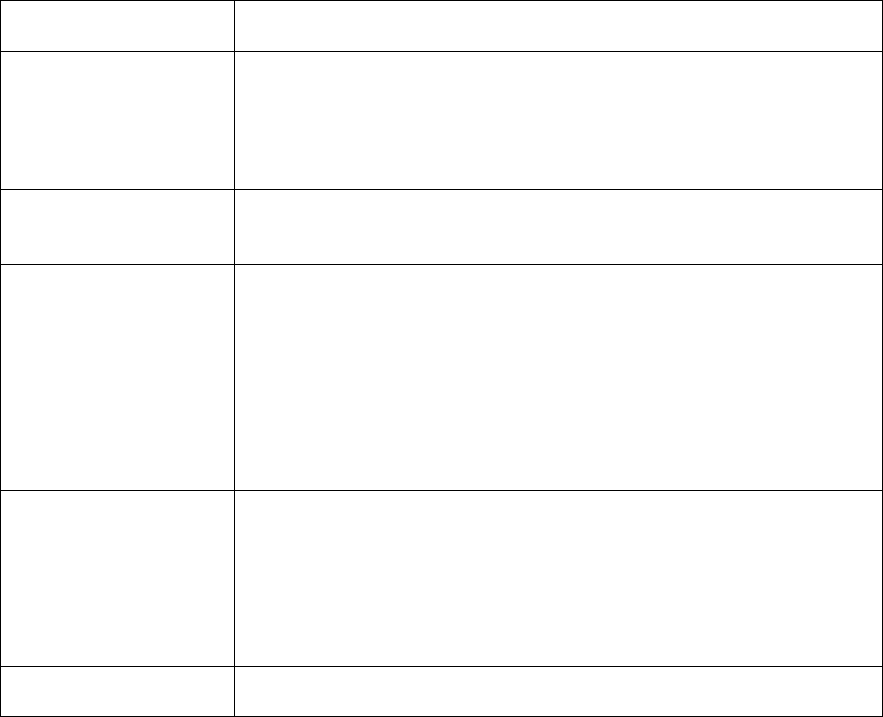
© 2010 HID Global Corporation All rights reserved
Section 1: Specifications
The purpose of this section is to provide you with specific information on the Regulatory Compliances,
Agency Listings, Technical Specifications and Functional Specifications for the DTC4500 Card Printer
User Guide.
Regulatory Compliances
Term Description
CSA
(cUL)
The Printer manufacturer has been authorized by UL to
represent the Card Printer as CSA Certified under CSA
Standard C22.2 No. 60950-1-03.
File Number: E145118
FCC The Card Printer complies with the requirements in Part 15 of
the FCC rules for a Class A digital device.
EMC The Card Printer has been tested and complies with EN55022 /
CISPR 22 Class A: and EN55024 standards.
(Note: Based on the above testing, the Printer manufacturer
certifies that the Card Printer complies with current EMC
directive 2004/108/EC of the European Community and has
placed the CE mark on the Card Printer.)
License Number: J99032510
UL The Card Printer is listed under UL IEC 60950-1 (2001)
INFORMATION TECHNOLOGY EQUIPMENT
(Note: This product is intended to be supplied by a Listed
Power Unit marked Class 2 and rated for 24 V dc, 3.7 to 5A.)
File Number: E145118
Environmental Power supply Efficiency level IV, RoHS, China RoHS
DTC4500 Card Printer/Encoder User Guide 5
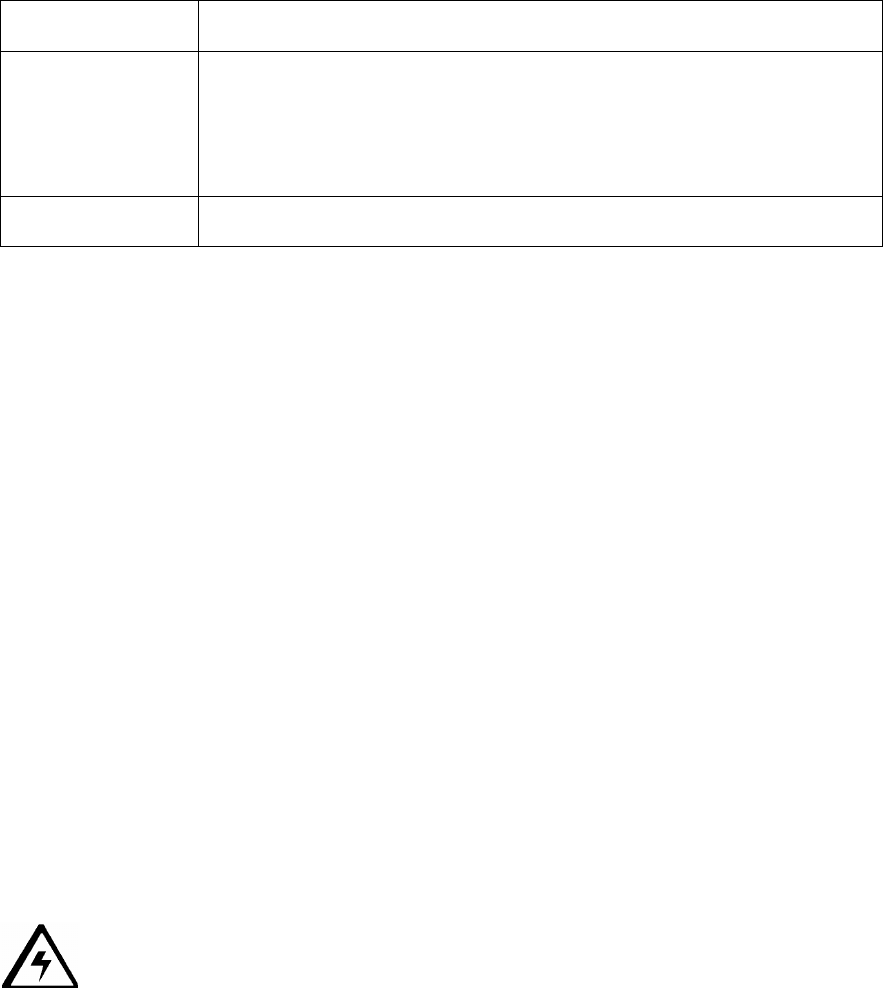
© 2010 HID Global Corporation All rights reserved
Agency Listings
Term Description
Emissions
Standards CE, FCCPart 15 Class A, CRC c1374, CISPR22 Class A,
EN55022, EN55024,
EN61000-3-2, EN61000-3-3,
Safety Standards UL IEC 60950-1 (2001), CSA C22.2 No. 60950-1-03.
United States
This device complies with Part 15 of the FCC rules. Operation is subject to the following two conditions:
(1) This device may not cause harmful interference.
(2) This device must accept any interference received, including interference that may cause undesired
operation.
Note: This equipment has been tested and found to comply with the limits for a Class A digital device,
pursuant to part 15 of the FCC Rules. These limits are designed to provide reasonable protection against
harmful interference when the equipment is operated in a commercial environment. This equipment
generates, uses, and can radiate radio frequency energy and, if not installed and used in accordance
with the instruction manual, may cause harmful interference to radio communications. Operation of this
equipment in a residential area is likely to cause harmful interference; in which case, you will be required
to correct the interference at his own expense.
Reference the Safety Messages in this document.
Canada
This Class A digital apparatus complies with Canadian ICES-003.
C’et appareil numerique de la classe A est comforme a la norme NMB-003 du Canada.
Caution: Changes or modifications not expressly approved by the party responsible for
compliance could void the user’s authority to operate the equipment.
DTC4500 Card Printer/Encoder User Guide 6
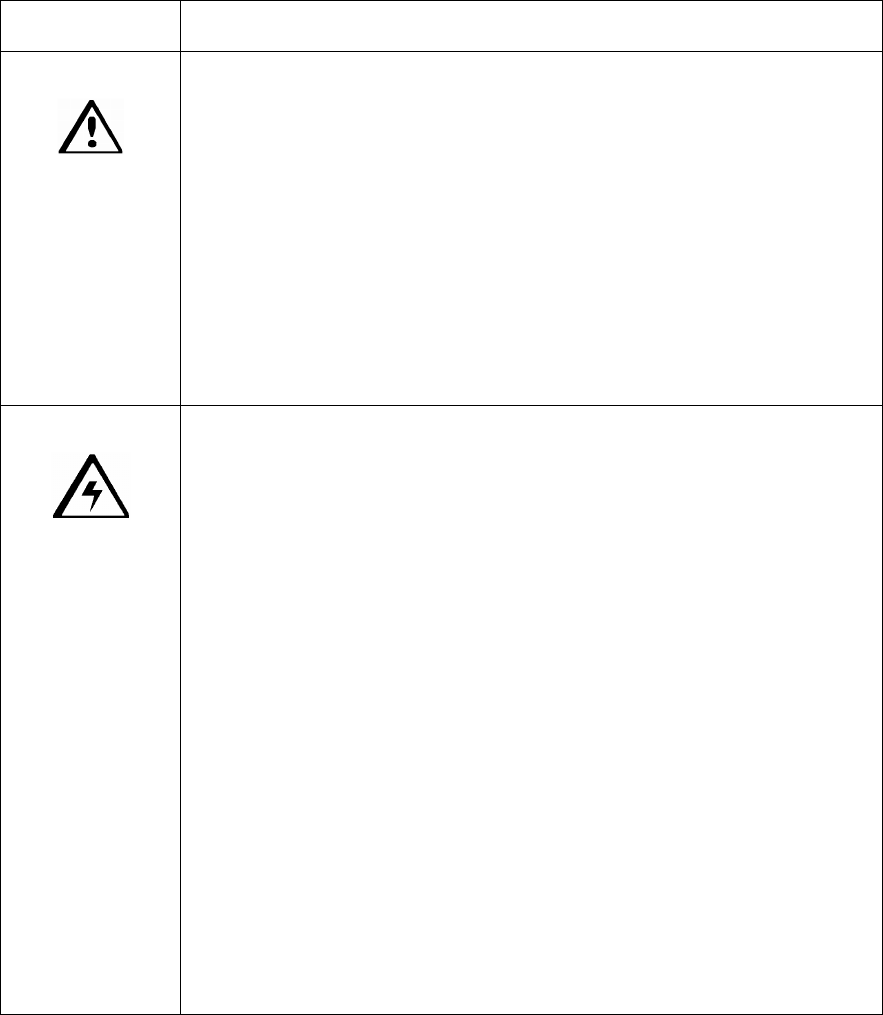
© 2010 HID Global Corporation All rights reserved
Safety Messages (review carefully)
Symbol Critical Instructions for Safety purposes
Danger:
Failure to follow these installation guidelines can result in death
or serious injury.
Information that raises potential safety issues is indicated by a
warning symbol (as shown to the left).
• To prevent personal injury, refer to the following safety
messages before performing an operation preceded by this
symbol.
• To prevent personal injury, always remove the power cord prior
to performing repair procedures, unless otherwise specified.
• To prevent personal injury, make sure only qualified personnel
perform these procedures.
Caution:
This device is electrostatically sensitive. It may be damaged if
exposed to static electricity discharges.
Information that raises potential electrostatic safety issues is indicated
by a warning symbol (as shown to the left).
• To prevent equipment or media damage, refer to the following
safety messages before performing an operation preceded by this
symbol.
• To prevent equipment or media damage, observe all
established Electrostatic Discharge (ESD) procedures while
handling cables in or near the Circuit Board and Printhead
Assemblies.
• To prevent equipment or media damage, always wear an
appropriate personal grounding device (e.g., a high quality wrist
strap grounded to avoid potential damage).
• To prevent equipment or media damage, always remove the
Ribbon and Cards from the Printer before making any repairs,
unless otherwise specified.
• To prevent equipment or media damage, take jewelry off of
fingers and hands, as well as thoroughly clean hands to remove
oil and debris before working on the Printer.
DTC4500 Card Printer/Encoder User Guide 7
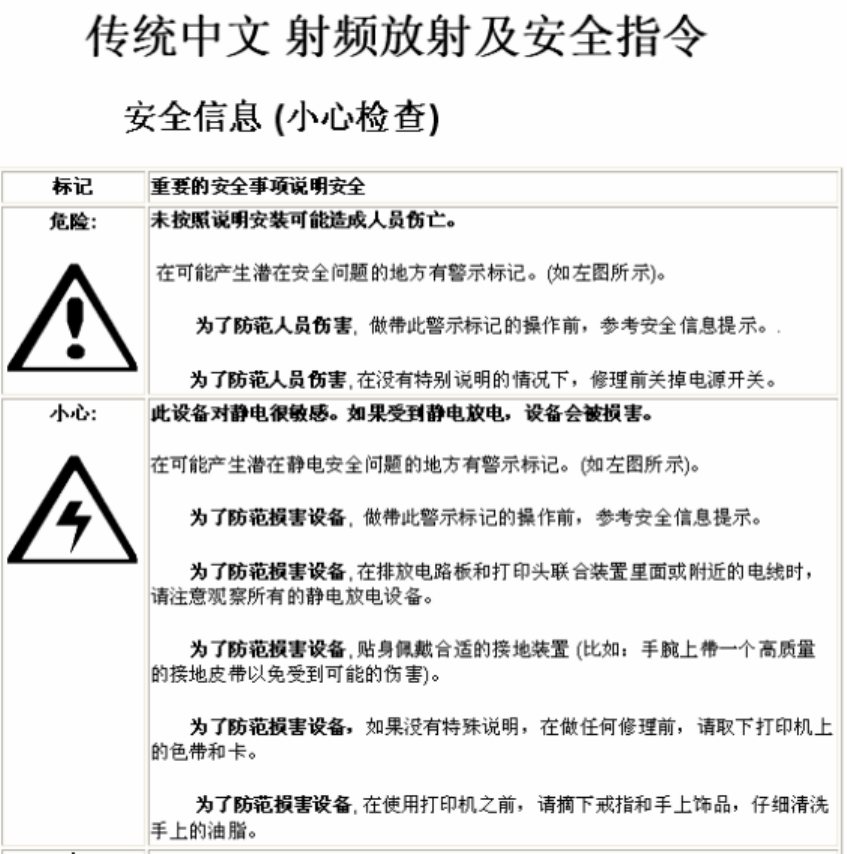
© 2010 HID Global Corporation All rights reserved
Environmental Protection (China-RoHS)
Environmental Protection Use Period is based on the product being used in an office environment.
Traditional Chinese RF Emissions and Safety Statements
經型式認證合格之低功率射頻電機,非經許可,公司、商號或使用者均不得擅自變更頻率、加大功率或變更原設計之特
性及功能。低功率射頻電機之使用不得影響飛航安全及干擾合法通信;經發現有干擾現象時,應立即停用,並改善至無
干擾時方得繼續使用。前項合法通信,指依電信法規定作業之無線電通信。低功率射頻電機須忍受合法通信或工業、
科學及醫療用電波輻射性電機設備之干擾。
DTC4500 Card Printer/Encoder User Guide 8
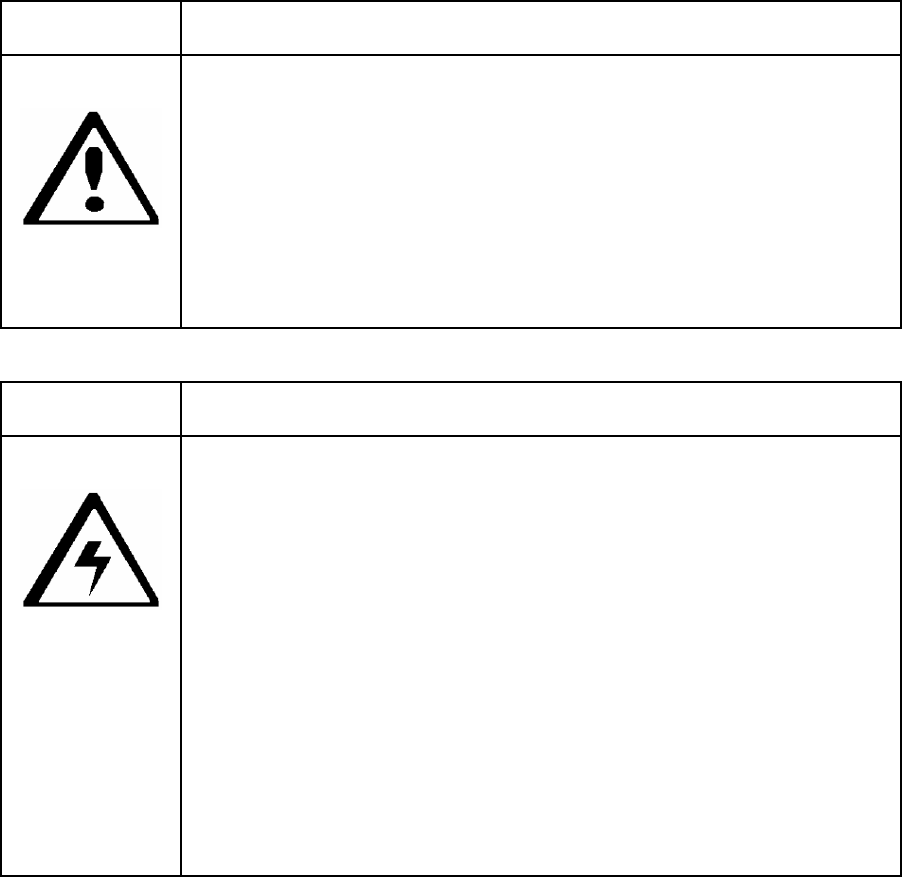
© 2010 HID Global Corporation All rights reserved
Simplified Chinese
如何使用本手册
实际上,DTC4500 证卡打印机用户指南
是一本整个证卡打印机的故障排除和服务手册。本手册旨在帮助安装人员和技术人员快速有效地查找相关
过程、组件和术语。安装人员或技术人员可根据自己的喜好,高效地使用本手册的电子文档或纸面文档。
安全消息(请仔细阅读)
符号 安全事项的重要说明
危险:
如果不遵循这些安装指南进行操作,可能会导致重伤,甚至死亡。
可能引发安全问题的信息由警告符号(如左图所示)来表示。
为了确保人身安全,在执行前面带有此符号的操作之前,请先阅读下面
的安全消息。
为了确保人身安全,除非另有规定,否则在执行维修过程前,始终应断
开电源。
为了确保人身安全,只能由有资格的人员执行这些过程。
安全消息(请仔细阅读)
符号 安全事项的重要说明
小心:
此设备为静电敏感设备。如果暴露在静电电流下,可能会损坏设备。
可能引发静电安全问题的信息由警告符号(如左图所示)来表示。
为了防止设备或介质受损,在执行前面带有此符号的操作之前,请先阅
读下面的安全消息。
为了防止设备或介质受损,请在处理电路板和打印头部件中或附近的
电缆时,遵守所有规定的静电放电 (ESD) 过程。
为了防止设备或介质受损,请始终佩带适当的个人接地设备(例如,已
接地避免出现潜在损坏的高质量腕带)。
为了防止设备或介质受损,除非另有规定,否则在执行任何维修过程前
,始终应将色带和证卡与打印机分离。
为了防止设备或介质受损,在操作打印机前,请取下手指和手上的珠宝
饰物,并将手上的油渍和污渍彻底清洗干净。
DTC4500 Card Printer/Encoder User Guide 9
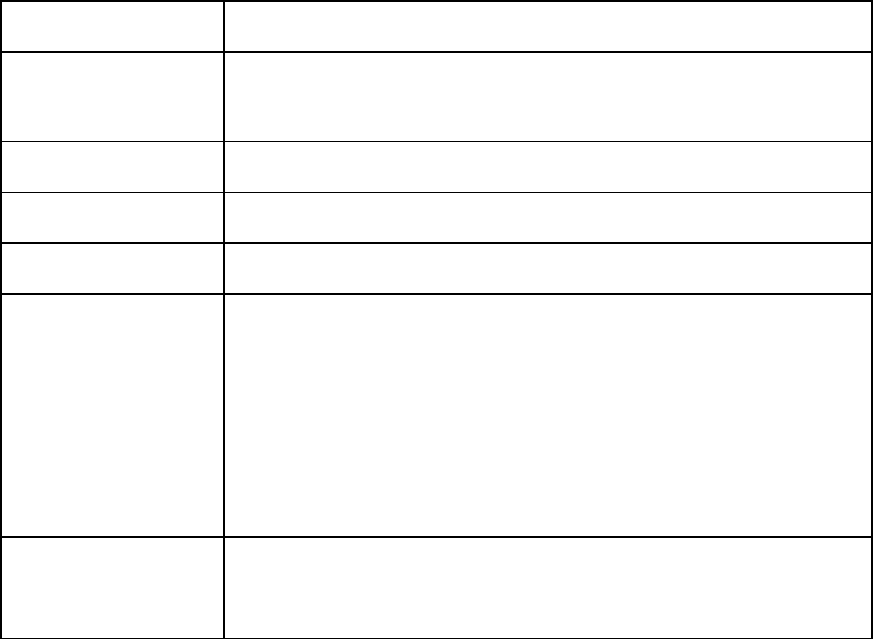
© 2010 HID Global Corporation All rights reserved
Technical Specifications
Term Function
Print resolution • 300 x 300 dpi(11.8 dots/mm)
• Up to 16.7 million colors, Monochrome
Printer Memory 16MB RAM
Print Area CR-80 (3.375"L x 2.125"W / 85.6mmL x 54mmW)
Print Method Dye Sublimation/Resin Thermal Transfer
Printer Driver &
System
Requirements
• Windows XP, Server 2003 and 2008, Vista 32-bit and 64-bit
compliance, Linux distributions-Red Hat, open
• SUSE, SUSE Enterprise, Ubuntu, Fedora Core
• Mac OS X version 10.0 to 10.5
• x86 based PC or compatible, Windows 2000, Windows XP,
Windows 2003, 500MHz computer with 256MB of RAM or
higher, 500MB free hard disk space or higher
Fargo E-card
Software
Development Kit
Support with developed Fargo E-card Software Development Kit
(SDK).
DTC4500 Card Printer/Encoder User Guide 10

© 2010 HID Global Corporation All rights reserved
Technical Specifications
Term Function
Connectivity • Standard USB 2.0 (USB Standard with this option), including
single USB cable support for Omnikey 5121 and 5125
encoders
• Ethernet 10/100 option, including single Ethernet cable
support for Omnikey 5121 encoder (separate USB cable
required for encoding with the Omnikey 5125 encoder)
• Full bi-directional status messaging to the PC during the
encoding process
Print Speed Indicates the Ribbon type and the number of Ribbon panels
printed where Y=Yellow, M=Magenta, C=Cyan, K=Resin Black,
O=Overlay, F=Fluorescing Resin
• YMCKO= 24 seconds per card
• YMCKOK= 30 seconds per card
• Resin= 6 seconds per card
• Print speed indicates an approximate batch print speed and
is measured from the time a card feeds into the Printer to the
time it ejects from the Printer.
• Print speeds do not include encoding time or the time
needed for the PC to process the image.
• Process time is dependent on the size of the file, the CPU,
amount of RAM and the amount of available resources at the
time of the print.
DTC4500 Card Printer/Encoder User Guide 11

© 2010 HID Global Corporation All rights reserved
Technical Specifications
Term Function
Card Size and
Types Supported
• CR-80 (3.362"L x 2.114"W / 85.4mmL x 53.7mmW)
• CR-79 (3.303”L x 2.051”W / 83.7mmL x 51.9mmW
• 10 mil to 40 mil card thickness
• Re-writable card technologies (requires special rewritable
cards)
• PVC, Polyester cards with a polished PVC finish
Printer Dimensions
DTC4500 :
• 14.4"(366 mm)L x 9.2"(234 mm)W x 9.8"(249 mm)H w/o
output bin
• 18.1"(460 mm)L x 9.2"(234 mm)W x 9.8"(249 mm)H w/
output bin
DTC4500 with Flipper (includes input Hopper):
• 18.7"(475 mm)L x 9.2"(234 mm)W x 9.8"(249 mm)H
DTC4500 without Flipper (includes input and output
Hoppers):
• 18.7"(475 mm)L x 9.2"(234 mm)W x 18.9"(480 mm)H
Environmental
Operation
• 20-80% Humidity
• 65° to 80° F / 18° to 27° C Temperature
Electrical • External power adapter: 100-240 VAC, 1.5 A max, output
24Vdc 3.75A
• 50 Hz/60 Hz Supply Frequency
• Efficiency level IV
Encoding Options
Supported
• Omnikey 5121 (iClass, Mifare, Desfire)
• Omnikey 5125 (HID Prox,Indala)
• Contact Smart Card (requires Omnikey 5121 or 5125 )
• ISO Mag Encoding standard 7811, Parts 1-7. High or Low
Coercivity. (Raw Magnetic Encoding option)
• JIS II Mag Encoding
DTC4500 Card Printer/Encoder User Guide 12

© 2010 HID Global Corporation All rights reserved
Functional Specifications
This Card Printer utilizes two different, yet closely related printing technologies to achieve its remarkable
direct-to-card print quality for dye-sublimation and resin thermal transfer.
Printer Components: Print Ribbons
The Card Printer utilizes both dye-sublimation and/or resin thermal transfer methods to print images
directly onto blank cards. Since the dye-sublimation and the resin thermal transfer print methods each
provide their own unique benefits, Print Ribbons are available in resin-only, dye-sublimation-only and
combination dye-sublimation/resin versions.
To make it easier to remember which Print Ribbons are which, a letter code has been developed to
indicate the type of Ribbon panels found on each Ribbon. This letter code is as follows:
= Dye-Sublimation Yellow Panel
= Dye-Sublimation Magenta Panel
= Dye-Sublimation Cyan Panel
= Resin Black Panel (Premium unless otherwise stated )
= Clear Protective Overlay Panel
= Ultra Violet Fluorescing Panel
DTC4500 Card Printer/Encoder User Guide 13
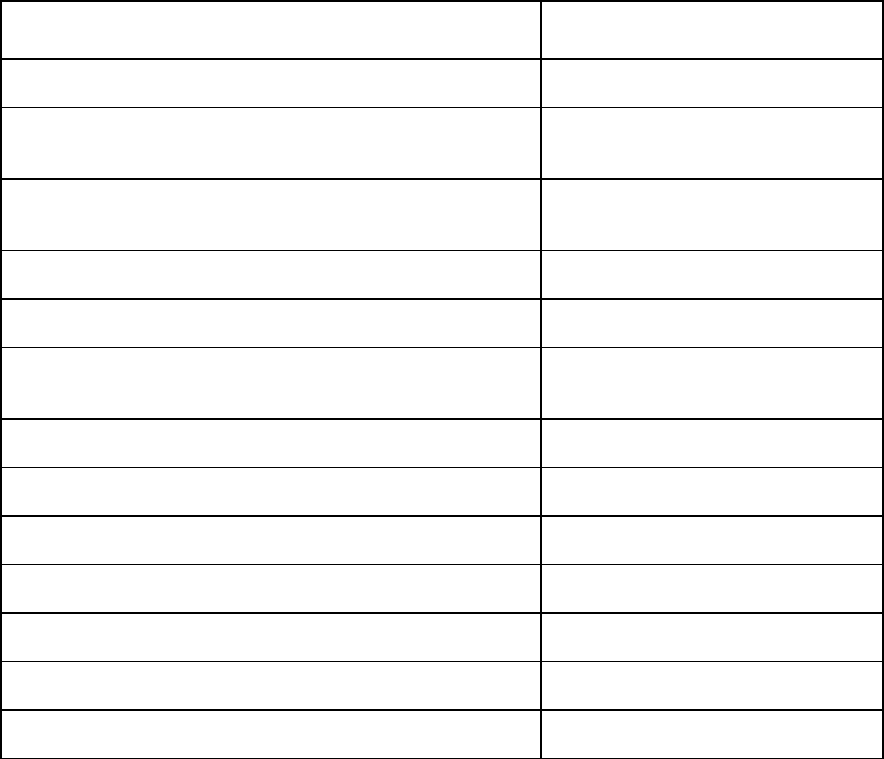
© 2010 HID Global Corporation All rights reserved
Ribbon Types/Count Table
Ribbon type and count used in each Printer.
Ribbon DTC4500
YMCKO – Full Color/Resin Black/Overlay 500
YMCKO Half Panel – Full Color (1/2)/Resin
Black/Overlay 850
YMCFKO - Full Color/UV Fluorescing/Resin
Black/Overlay 500
YMCKK - Full Color/2 Resin Black 500
YMCKOK - Full Color/2 Resin Black/Overlay 500
YMCFKOK - Full Color/UV Fluorescing/2 Resin
Black/Overlay 400
K – Standard Resin 3000
K – Premium Resin 3000
Colored Resin 2000
Metallic Resin 2000
KO - Premium Black Resin/Overlay 1250
BO - Dye-Sub Black/Overlay 1250
None – Rewritable Supported
DTC4500 Card Printer/Encoder User Guide 14
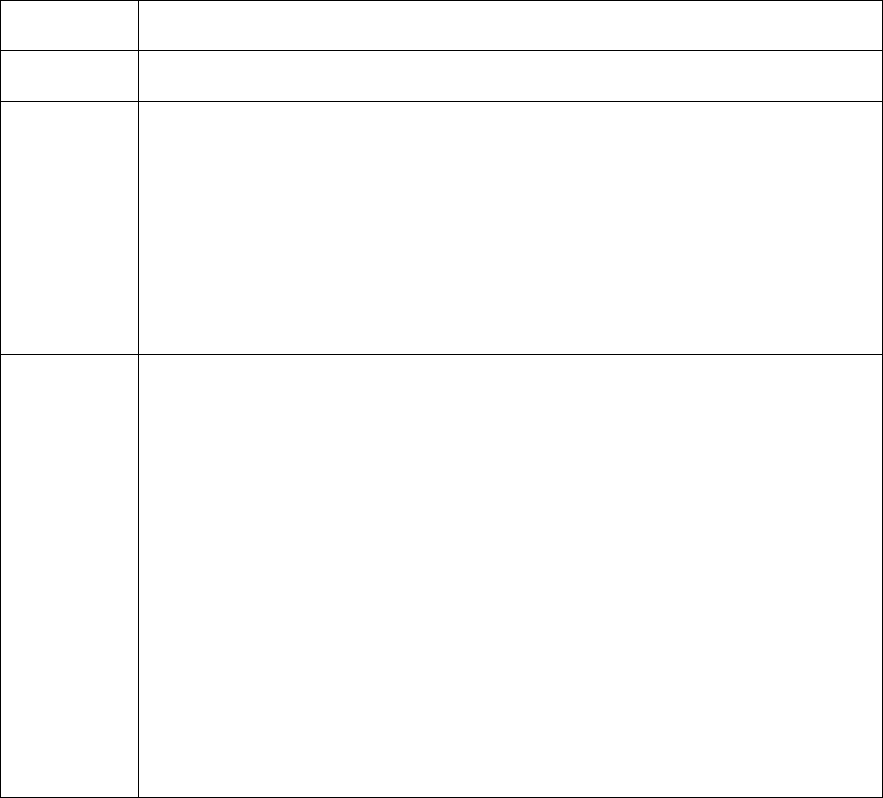
© 2010 HID Global Corporation All rights reserved
Printer Components: Blank Cards
Type Description
Card Size The Card Printer accepts standard CR-80 and CR-79 sized cards.
Card
Surface Suitable cards must have a polished PVC surface free of fingerprints, dust
or any other types of embedded contaminants. In addition, cards must
have a completely smooth, level surface in order for the Printer to achieve
consistent color coverage.
• Certain types of Proximity cards have an uneven surface that will
inhibit consistent color transfer.
• Certain types of smart card chips are raised slightly above the cards
surface which also results in poor color transfer.
UltraCard™
Brand
Cards
The UltraCard product line, available exclusively as part of HID's Global's
Fargo brand secure card issuance solutions, has a long standing
reputation among dealers and end-Users for consistent quality in
construction.
• In addition to blank stock, the UltraCard line is available in a variety of
configurations for magnetic stripe, custom holograms and other
additional anti-counterfeiting feature
• UltraCard™ Premium is the preferred card for Direct-to-Card (DTC®)
applications that require a higher quality card. The UltraCard
Premium’s composite material construction provides for maximum
durability, flexibility and card life, with optimal resolution print quality
for lamination and fluorescent panel Ribbon printing applications.
• UltraCard™ PVC cards are medium-durability cards for a glossy,
photo quality finish. These cards are manufactured to ensure clean,
scratch-free cards for high-quality prints and extended Printhead life.
DTC4500 Card Printer/Encoder User Guide 15

© 2010 HID Global Corporation All rights reserved
Section 2: Setup and Installation Procedures
This section describes the setup and installation for the DTC4500 Card Printer.
Choosing a Good Location
Follow these guidelines:
• Place the unit in a location with adequate air circulation to prevent internal heat build up.
• Use the Printer's dimensions as a guideline for the minimum clearances to the unit. (Note: Allow for
adequate clearance in front of the unit to accommodate the unit with its Covers open.)
• Do not install unit near heat sources such as radiators or air ducts or in a place subject to direct
sunlight, excessive dust, mechanical vibration or shock.
About Moisture Condensation
If the unit is brought directly from a cold to a warm location or is placed in a very damp room, moisture
may condense inside the unit. Should this occur, print quality may not be optimum.
Leave the unit turned Off in a warm, dry room for several hours before using. This will allow the moisture
to evaporate.
Caution: For safety purposes, Ethernet is not intended for a direct connection outside of the
building.
Unpacking and Inspection
While unpacking your Printer, inspect the carton to ensure that no damage has occurred during shipping.
Make sure that all supplied accessories are included with your unit.
Check that the following items are included:
• Power Supply
• US / EU Power Cable
• USB cable (2.0)
• Software Installation CD/User Guide
• User Guide
• Warranty Statement, Registration Card and Compliancy Document
DTC4500 Card Printer/Encoder User Guide 16
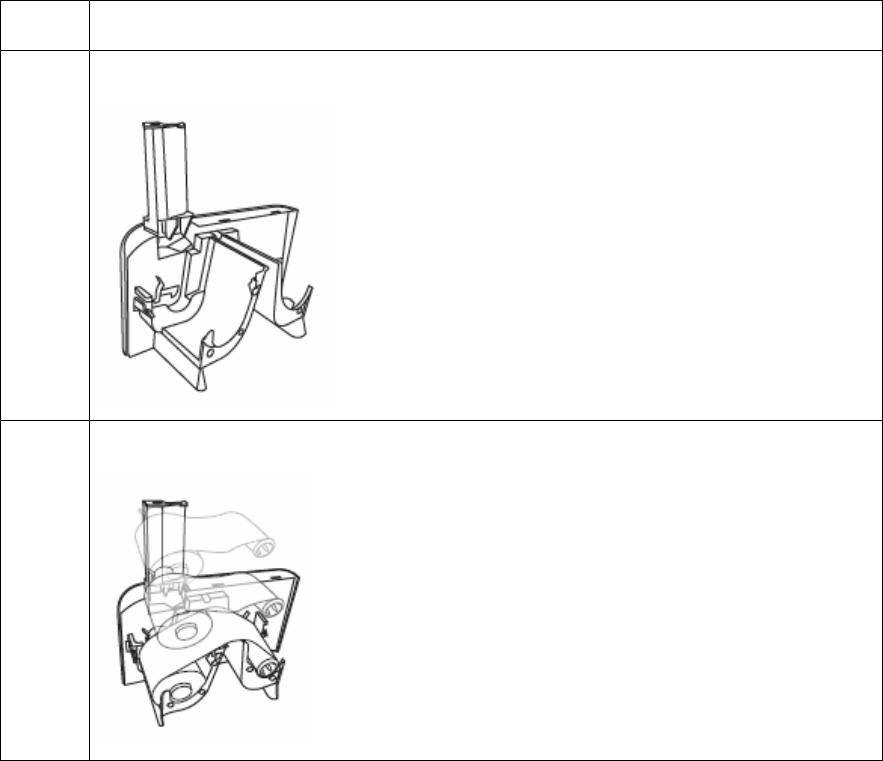
© 2010 HID Global Corporation All rights reserved
Installing the Print Ribbon Cartridge (DTC4500)
Fargo Card Printers require highly specialized supplies to function properly.
• The Fargo DTC4500 Card Printer uses a one-piece, refill system.
• To maximize Printer life, reliability, printed card quality and durability, you must use only Fargo-
certified supplies.
• For this reason, your Fargo warranty is void, where not prohibited by law, if you use non-Fargo-
certified supplies.
• Printer cleaning is recommended with each Ribbon change to ensure quality printed cards.
• Resin-only Print Ribbons consist of a continuous roll of a single resin color. No protective overlay
panel (O) is provided since resin images do not require the protection of such an overlay.
Installing the Ribbon
Step Procedure
1 Lift up the Cleaning Roller Cover.
2 Load the Print Ribbon into the Print Ribbon Cartridge.
DTC4500 Card Printer/Encoder User Guide 17
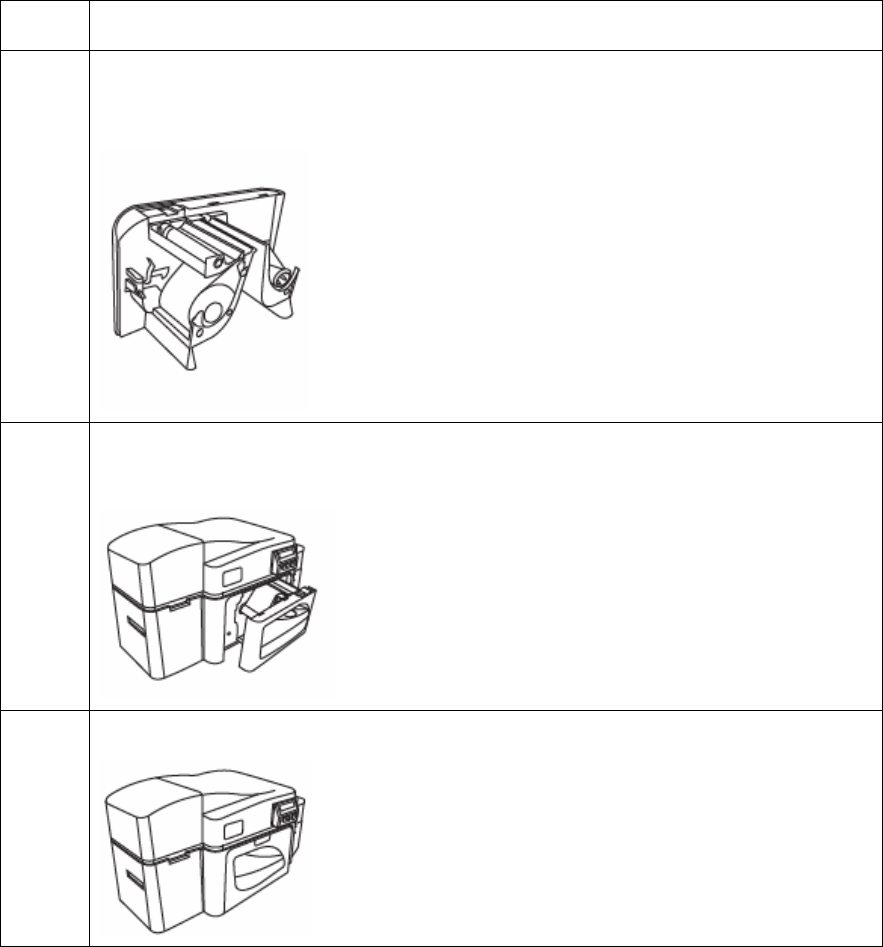
© 2010 HID Global Corporation All rights reserved
Installing the Ribbon
Step Procedure
3 a. Close the Cleaning Roller Cover.
b. Insert the new Cleaning roller.
4 Load the Ribbon Cartridge into the Printer.
5 Close the Front Cover.
DTC4500 Card Printer/Encoder User Guide 18
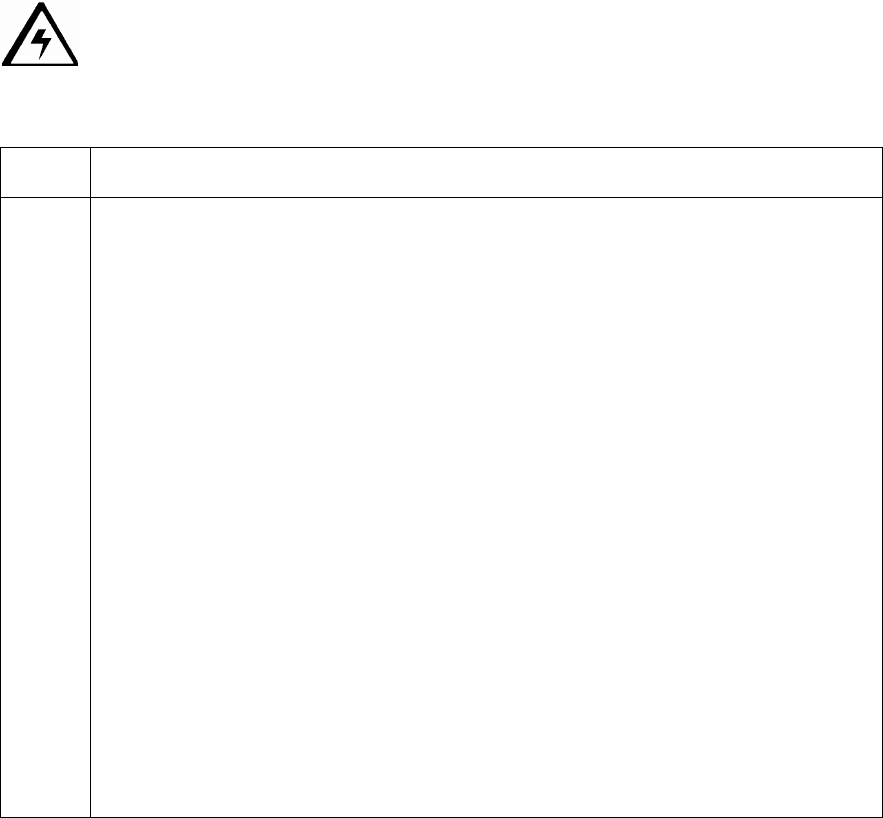
© 2010 HID Global Corporation All rights reserved
Installing Blank Cards into the Card Hopper (DTC4500)
Using the Single and Dual Hopper
Caution: Do not run the cards with a contaminated, dull or uneven surface through the
Printer.
Step Procedure
1 Pre-instruction.
• Printing onto such cards will ultimately lead to poor print quality and will
greatly reduce the life of the Printhead. Card Types include PVC or PVC
finish.
• Cards eject into the Output Hopper or Reject Hopper.
• Each Hopper holds 100 cards.
• The DTC4500 is available with two (2) Hopper configurations: Single and
Dual Hopper
• Certain types of smart card chips are raised slightly above the cards
surface which may result in poor color transfer. Design the card with white
space surrounding the chip. (Note: The Fargo DTC4500 Printer is capable
of printing single load cards and multiple feed cards (batch mode).)
• To print using single feed, simply remove all cards from the Card Hopper,
leave the Card Hopper door closed and place a card in the single Feed
Card Slot (which can be used repeatedly).
• Again, the cards should be loaded with the print side down and (if
applicable) the magnetic strip up and towards the front of the Printer.
DTC4500 Card Printer/Encoder User Guide 19
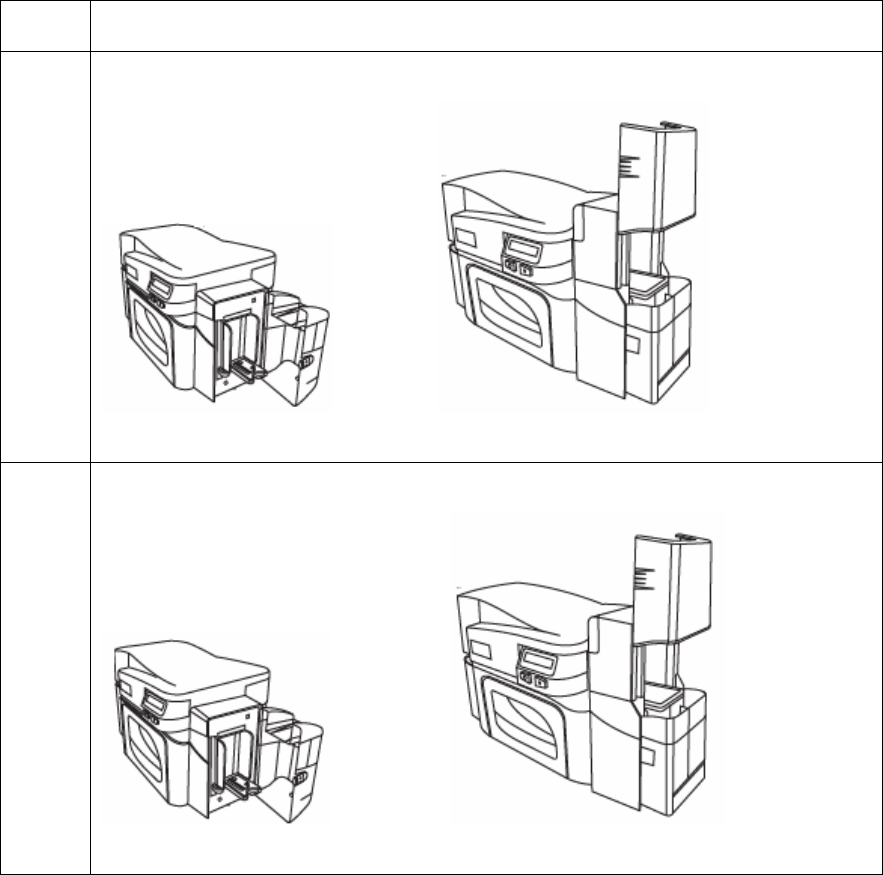
© 2010 HID Global Corporation All rights reserved
Using the Single and Dual Hopper
Step Procedure
2 Open the Card Hopper Cover.
Single Hopper Dual Hopper
3 Press the Card Hopper Load Lever down until the Card Tray locks into place.
DTC4500 Card Printer/Encoder User Guide 20
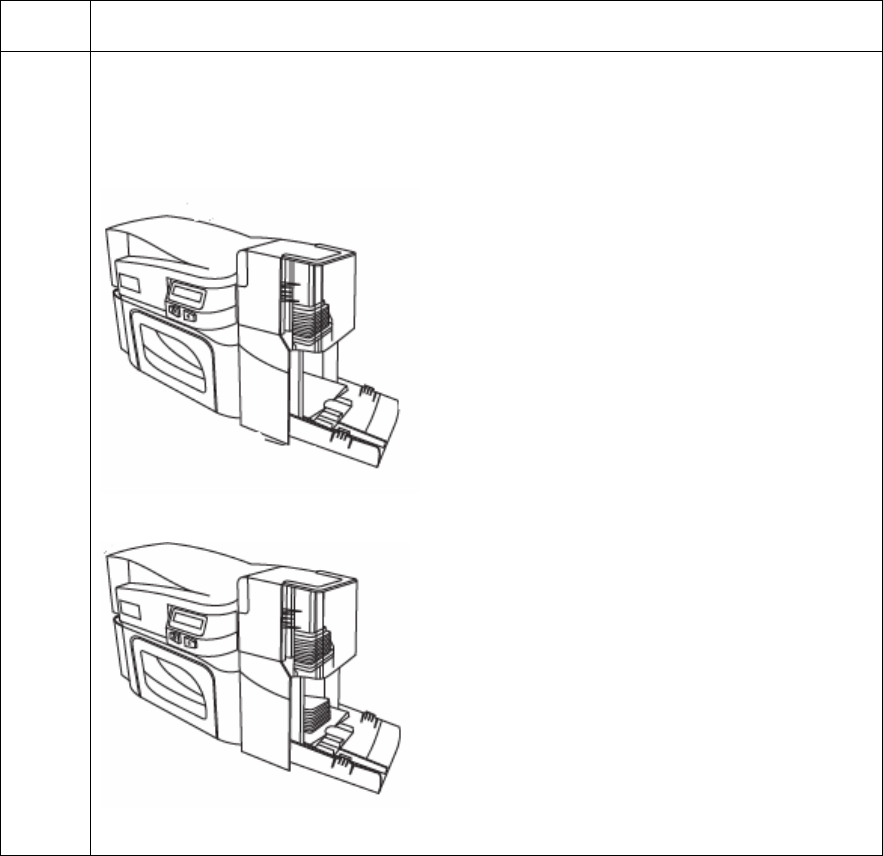
© 2010 HID Global Corporation All rights reserved
Using the Single and Dual Hopper
Step Procedure
4 Load up to 100 cards into the Hopper with the print side down. (Note: If using
cards with a magnetic stripe, the magnetic stripe should be loaded with the
stripe up and to the front of the Printer.)
Display: Card loaded into the upper Hopper of DTC4500 Single Hopper
Display: Cards loaded into lower Hopper of DTC4500 Dual Hopper
DTC4500 Card Printer/Encoder User Guide 21
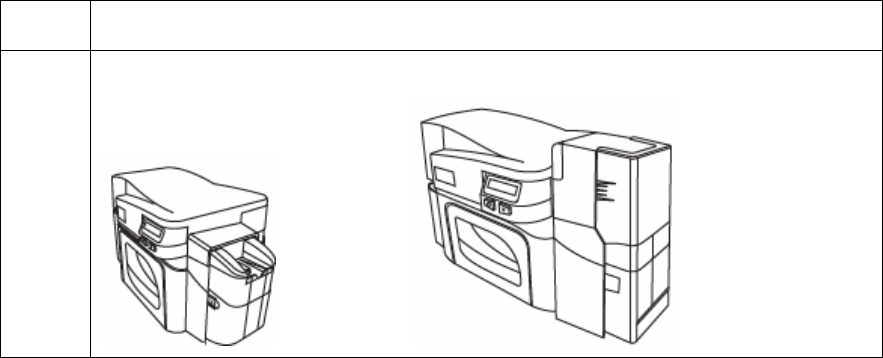
© 2010 HID Global Corporation All rights reserved
Using the Single and Dual Hopper
Step Procedure
5 Close the Card Hopper Cover to release the lever to the printing position.
DTC4500 Card Printer/Encoder User Guide 22
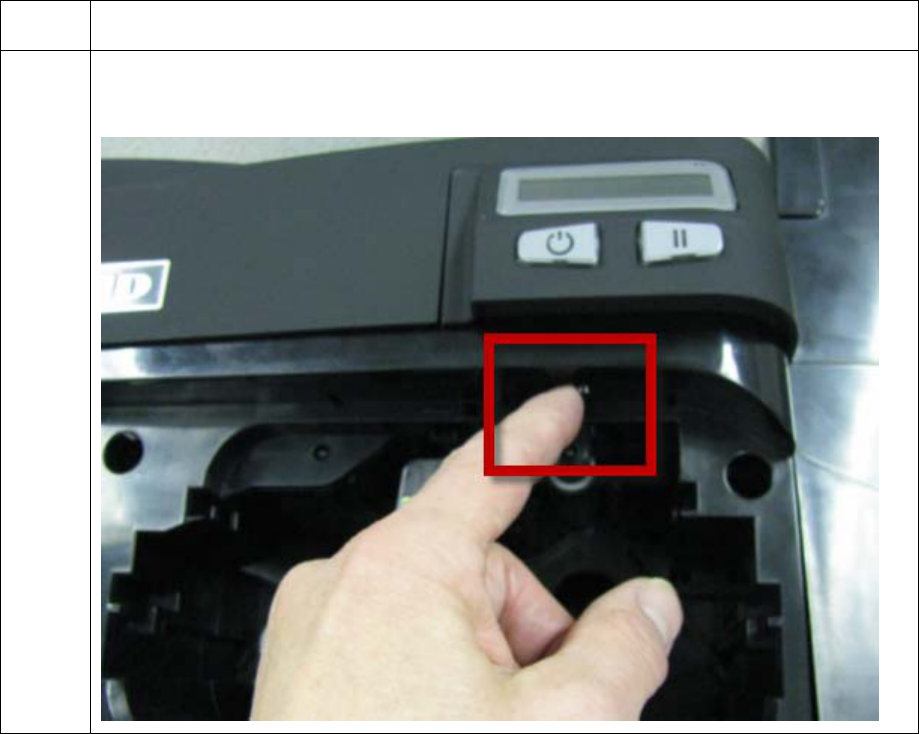
© 2010 HID Global Corporation All rights reserved
Setting the Card Size for CR79 and CR80
Follow this procedure in the Printer and in the Printer Driver to setup the card size.
Step Procedure
1 Open the front door and locate the slide bar.
DTC4500 Card Printer/Encoder User Guide 23
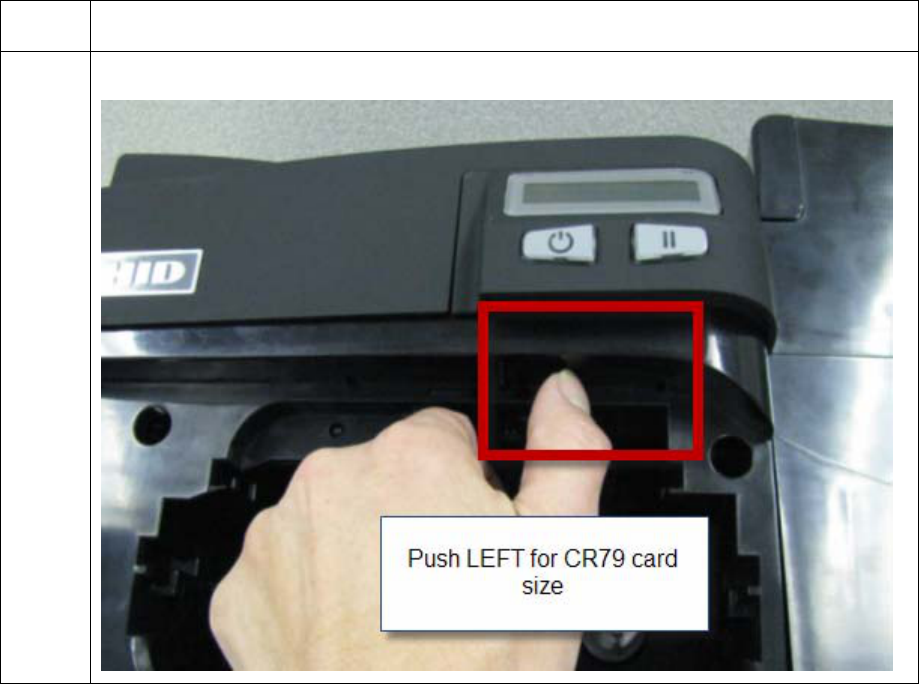
© 2010 HID Global Corporation All rights reserved
Setting the Card Size for CR79 and CR80
Step Procedure
2 If using the CR79 card, push the slide bar to the LEFT.
DTC4500 Card Printer/Encoder User Guide 24
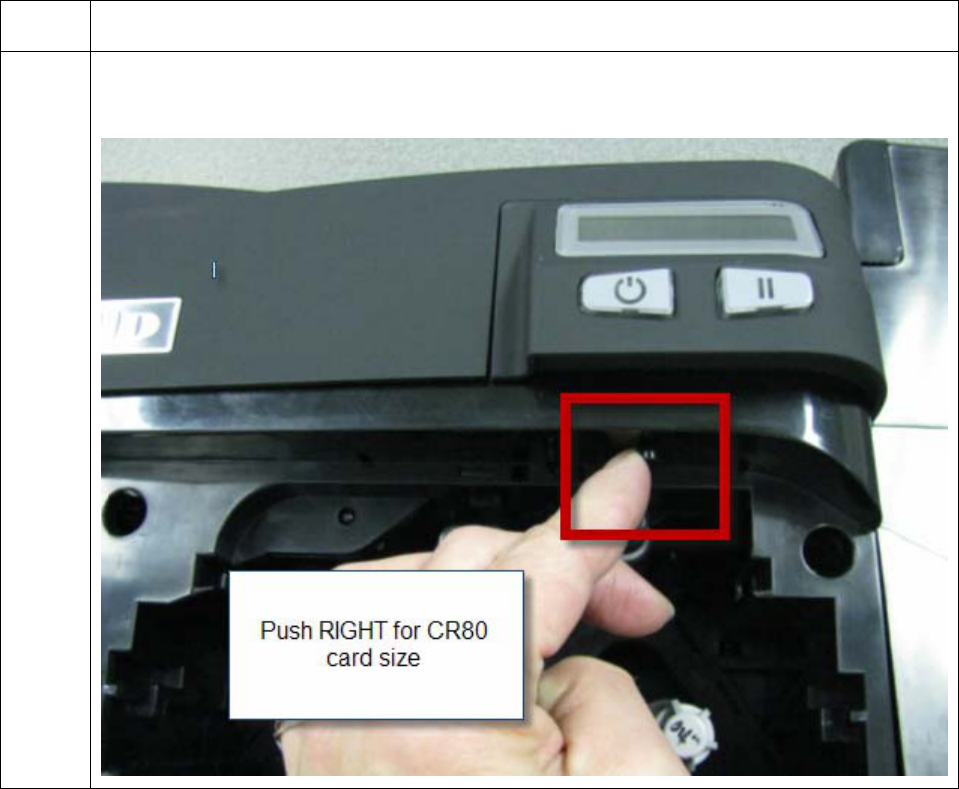
© 2010 HID Global Corporation All rights reserved
Setting the Card Size for CR79 and CR80
Step Procedure
3 If using the CR80 card, push the slide bar to the RIGHT.
DTC4500 Card Printer/Encoder User Guide 25
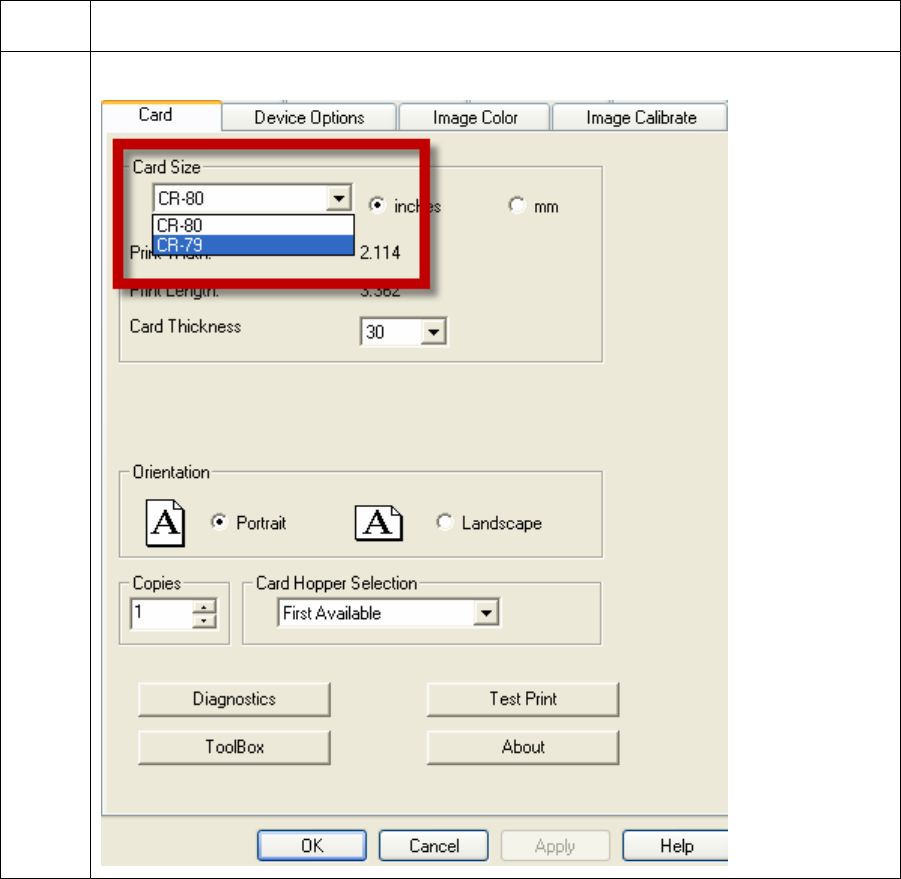
© 2010 HID Global Corporation All rights reserved
Setting the Card Size for CR79 and CR80
Step Procedure
4 From the Driver Printing Preferences, select the correct card size.
DTC4500 Card Printer/Encoder User Guide 26
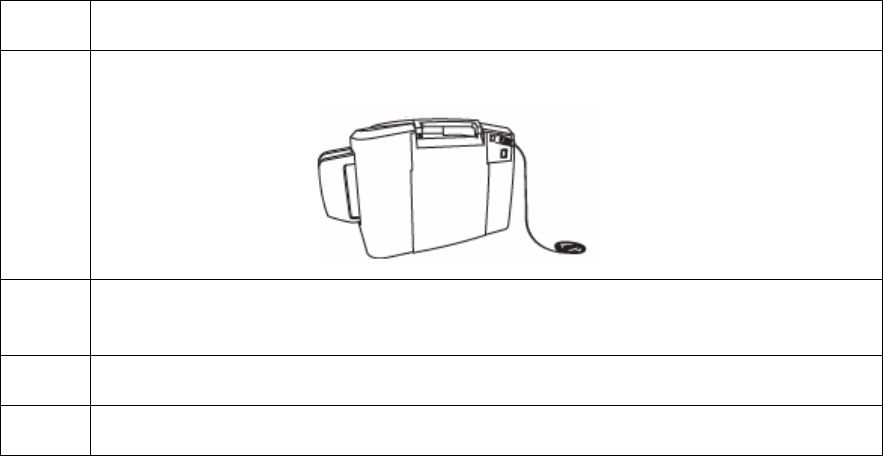
© 2010 HID Global Corporation All rights reserved
Connecting the Printer power
Follow this procedure. (Note: Do not connect the Printer’s USB cable until prompted during the Printer
Driver installation.)
Step Procedure
1 Plug the AC adapter power cable into the back of the Printer.
2 Plug the wall power cable into the AC power adapter. This display shows
Printer from behind with AC power cable.
3 Plug the wall power cable into a standard 110VAC power outlet.
4 Press the left ON/Off Button to power up the printer.
DTC4500 Card Printer/Encoder User Guide 27
© 2010 HID Global Corporation All rights reserved
Section 3: Print Driver Installation
This section describes the Printer Driver installation requirements and standard procedures.
Requirements are listed below. The DTC4500 Print Driver supports the following:
• Vista, 32 bit Windows OS,
• Windows XP
• Server 2003
• Vista, 64 bit Windows OS
• Linux OS (Ubuntu7.10, Red Hat Enterprise Desktop 5, Fecora Core 7 & 8, openSUSE 10.3 , open
NOVELL SUSE 10.). Contact HID/Fargo Technical Support for the driver.
Driver Installation Instructions
Start the installation process by inserting the Driver CD into the computer. Then, follow the Installaware
Wizard screen prompts.
• Select 32 bit Windows or 64 bit Windows to start the installation.
• Select the Fargo Workbench Utility Program to install this program.
• Specific versions of Windows require Administrator rights.
• From the Printer & Faxes folder, open the Printing Preferences to setup the Driver after it has been
installed.
• Printing Preferences need to be setup after the Driver has been installed. Each TAB is shown in the
next section.
• Use the drop down arrows to select the correct options for each printing preference.
DTC4500 Card Printer/Encoder User Guide 28
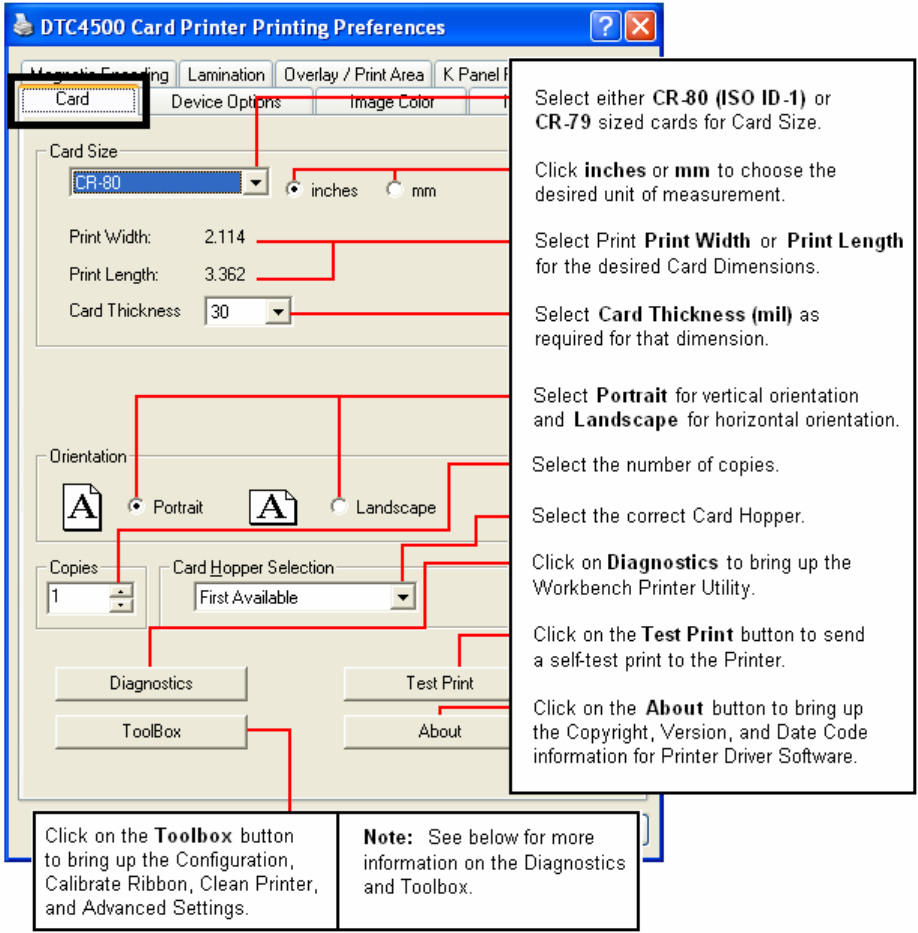
© 2010 HID Global Corporation All rights reserved
Section 4: Printer Preferences Tab Functions
This section provides an overview of the Printer Driver preferences tab.
|contextid=30 Using the Card tab
Click on the Card tab to bring up the window (shown below). Refer to the Help file for the Fargo
Workbench Utility Program and User Guide.
DTC4500 Card Printer/Encoder User Guide 29
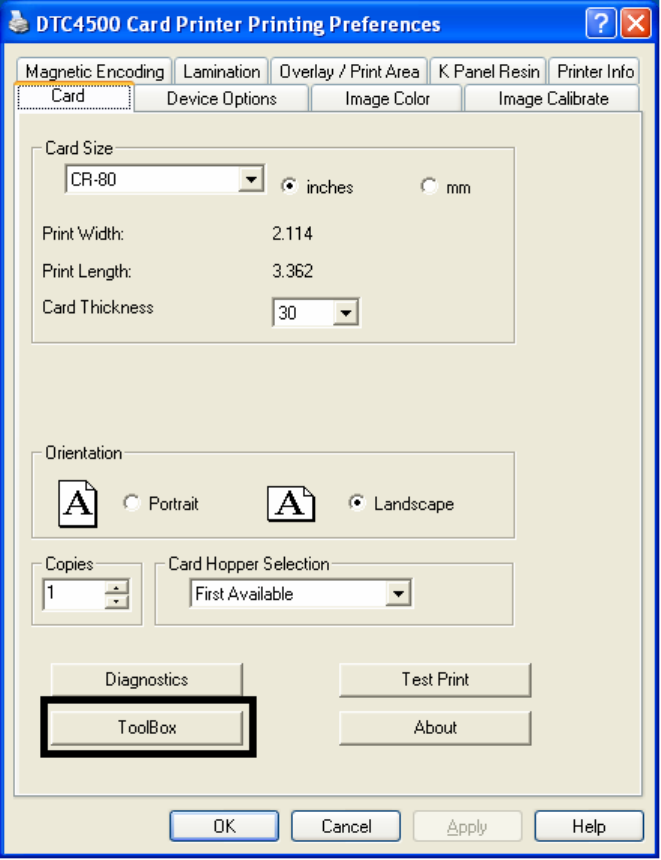
© 2010 HID Global Corporation All rights reserved
Using the Toolbox Options
DTC4500 Card Printer/Encoder User Guide 30
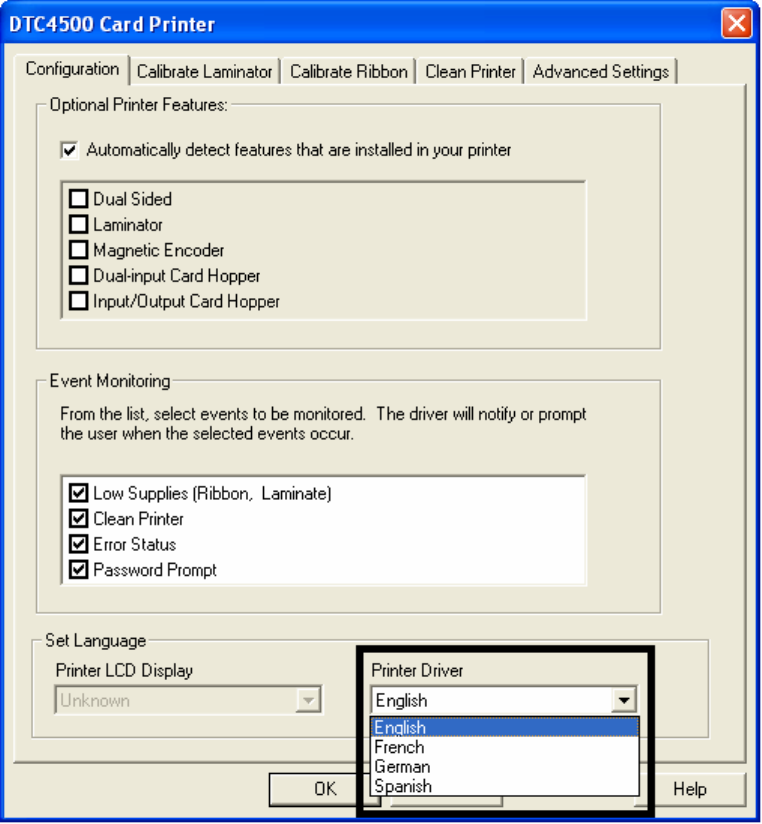
© 2010 HID Global Corporation All rights reserved
|contextid=150 Using the Configuration Tab
This option is used to show the currently installed Optional Printer features, Event Monitoring, to set the
Printer Driver language and Printer LCD Display language.
• To switch between languages, select the desired language and reboot the driver.
DTC4500 Card Printer/Encoder User Guide 31
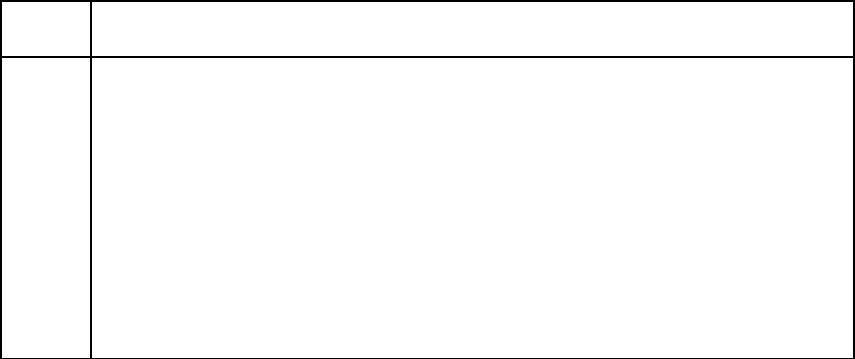
© 2010 HID Global Corporation All rights reserved
|contextid=151 Selecting the Calibrate Laminator tab
The Calibrate Laminator tab is active when the Laminator is automatically detected or when the
Laminator is manually checked (as a Printer Feature on the Configuration tab). If the Laminator is not
detected and not manually checked, the tab is active; however, all functions are grayed out.
• Calibrate button: Sends calibrate Laminator command to Printer. Follow the instruction on the page
for setting up the Printer.
• Help button: Launches help specific to this tab.
Step Procedure
1 Select the Calibrate Laminator tab.
a. Ensure that the Cartridges are out of the Laminator.
b. Ensure the Laminator Cover is closed.
c. Click on the Calibrate button. (Note: The Printer’s LCD will display
CALIBRATE PASSED. Error Message Calibration Failed may be
solved by manually increasing the sensor calibration number to 13 of
higher under the Advanced Settings tab. Do not use the AUTO calibrate
function.)
d. Click on the OK button on the LCD display to complete the procedure.
DTC4500 Card Printer/Encoder User Guide 32
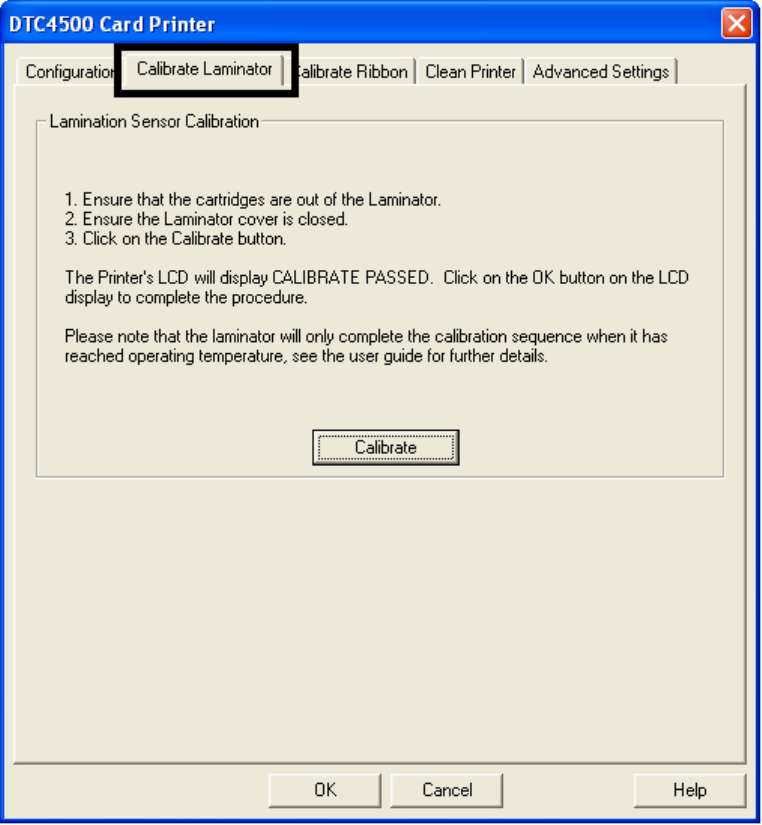
© 2010 HID Global Corporation All rights reserved
Selecting the Calibrate Laminator tab
DTC4500 Card Printer/Encoder User Guide 33
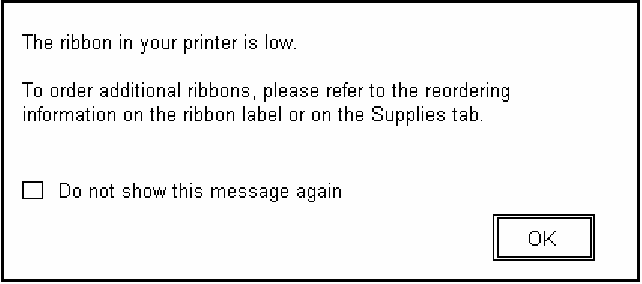
© 2010 HID Global Corporation All rights reserved
Using the Event Monitoring Group Box
This Event Monitoring group box displays the Low Supplies (Ribbon, Laminate and Film).
• The default setting is checked. If checked, the Ribbon Low message box is displayed with every
print job when Printer reports low Ribbon to the Driver.
• Do not show this message again: The check box allows the User to suppress message per Driver
instance. Default = unchecked.
Reviewing the Ribbon Low message
Display – Ribbon Low dialog
DTC4500 Card Printer/Encoder User Guide 34

© 2010 HID Global Corporation All rights reserved
|contextid=152 Selecting the Calibrate Ribbon tab
The two buttons for the Calibrate Ribbon tab are described below.
• Calibrate button: Sends the Calibrate Ribbon Command to Printer. Follow the instructions below to
set up the Printer.
• Help button: Launches help specific to this tab.
Step Procedure
1 Select the Calibrate Ribbon tab.
a. Ensure that the Ribbon Cartridge is removed.
b. Ensure the Printer’s Cover is closed.
c. Click on the Calibrate button. (Note: The Printer’s LCD will display
CALIBRATE PASSED.)
d. Click on the OK button on the LCD display to complete the procedure.
DTC4500 Card Printer/Encoder User Guide 35
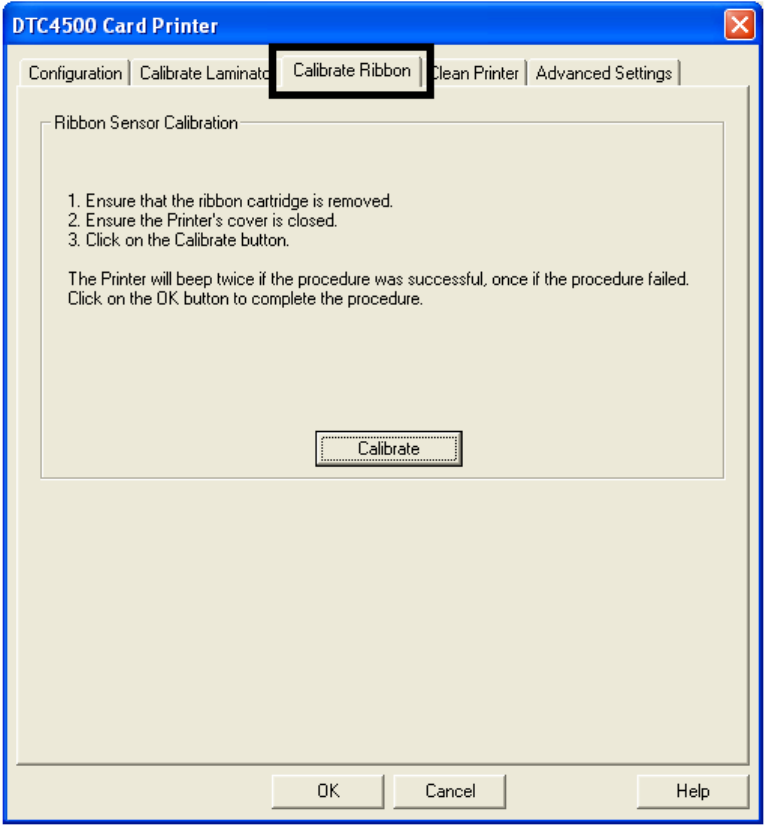
© 2010 HID Global Corporation All rights reserved
Selecting the Calibrate Ribbon tab
DTC4500 Card Printer/Encoder User Guide 36
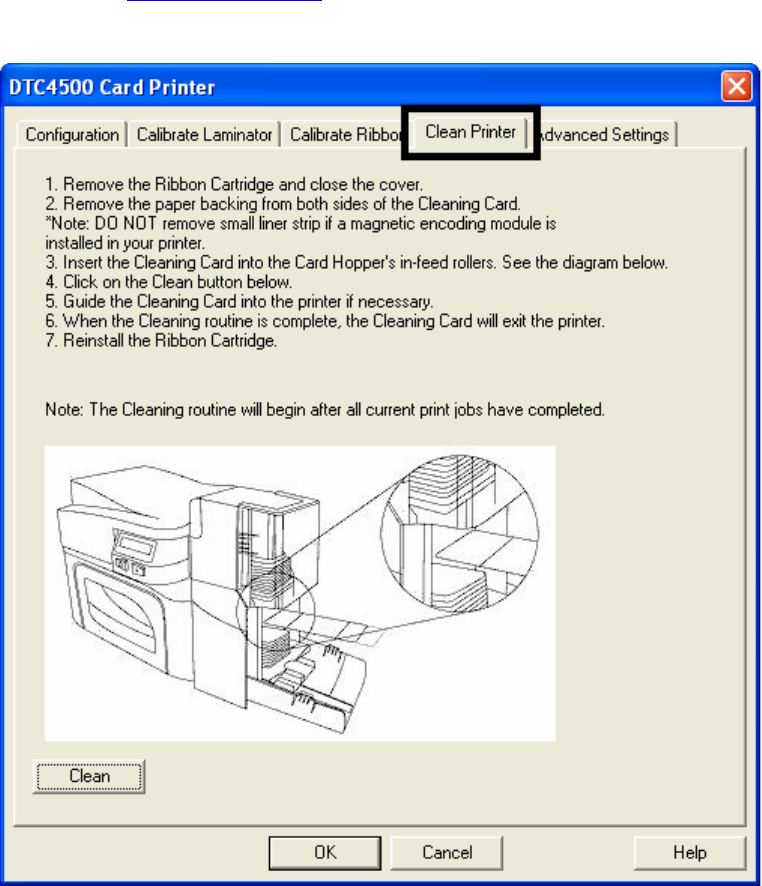
© 2010 HID Global Corporation All rights reserved
|contextid=154 Selecting the Clean Printer tab
The button for the Clean Printer tab is described below.
• Clean Button: Launches cleaning routine. Follow the instruction on the page for setting up the
Printer.
• Help button: Launches help that is specific to this tab.
• Also see Cleaning the Printer for full instructions.
DTC4500 Card Printer/Encoder User Guide 37
© 2010 HID Global Corporation All rights reserved
|contextid=155 Selecting the Advanced Settings tab
Use the Advanced Settings tab for adjusting the internal Printer settings, which are customized for
every Printer at the factory and saved directly within the Printer's memory. (Note: You can select the
Restore Defaults to restore the internal default settings.)
Selecting the Advanced Settings tab
These change values for Firmware settings. See below.
• Setting Column: Displays label for setting
• Default Column: Displays default value for setting
• Current Column: Displays current value for setting
• Change the value by clicking on the value to activate spin control or type.
• Apply Button: Applies changed values.
• Restore Defaults Button: Restores default values.
DTC4500 Card Printer/Encoder User Guide 38
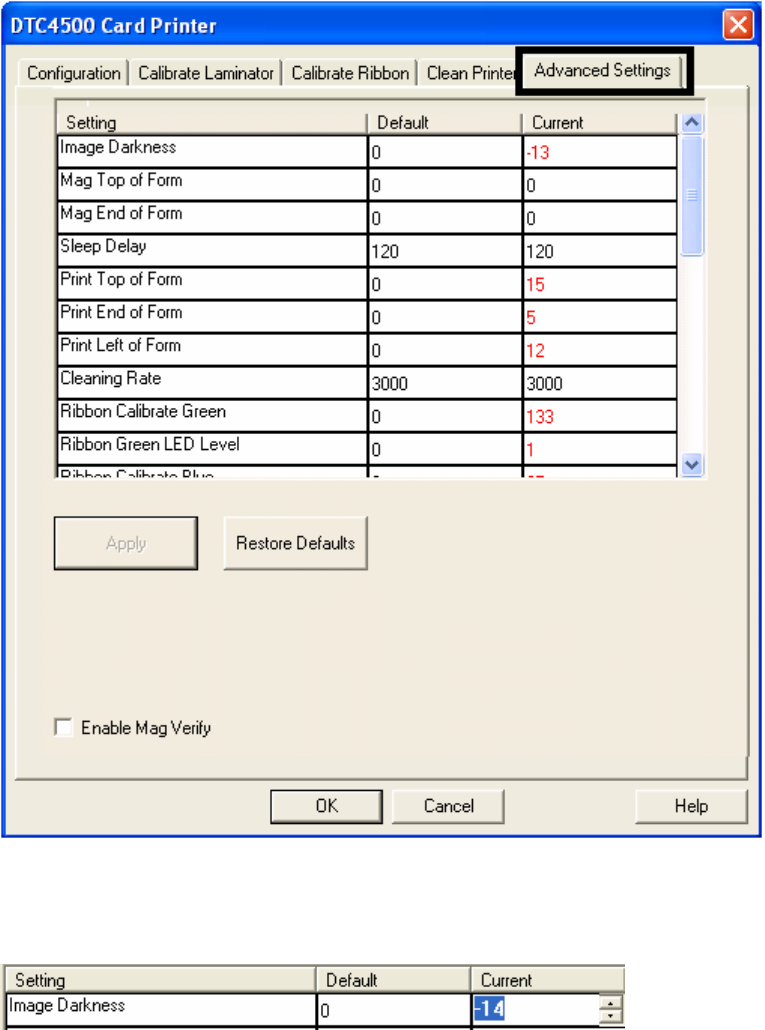
© 2010 HID Global Corporation All rights reserved
Selecting the Advanced Settings tab
Example:
DTC4500 Card Printer/Encoder User Guide 39
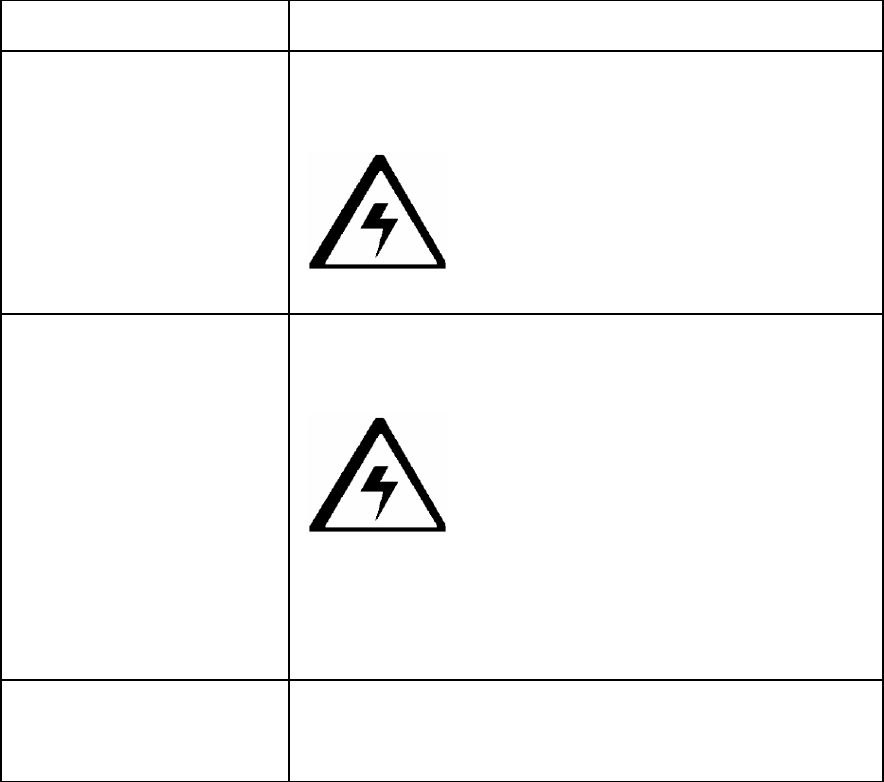
© 2010 HID Global Corporation All rights reserved
Selecting the Advanced Settings tab
Setting Option
Image Darkness Use this option to set the overall darkness of the printed
image by increasing or decreasing the amount of heat
(used by the Printhead when printing).
Caution: If the value is set too high, the
Ribbon may jam or even break.
Mag Top of Form Use this option to shift the starting point where the Printer
begins to encode the magnetic track data on the card’s
Magnetic Stripe.
Caution: If the negative value is set too
high, the Printer may start encoding before the Magnetic
Stripe reaches the encoding head.
• Maximum adjustment range is +/- 80.
• Each increment equals .01”.
Sleep Delay The Sleep Time setting adjusts the number of minutes of
inactivity before the Printer enters a low power sleep
state.
DTC4500 Card Printer/Encoder User Guide 40
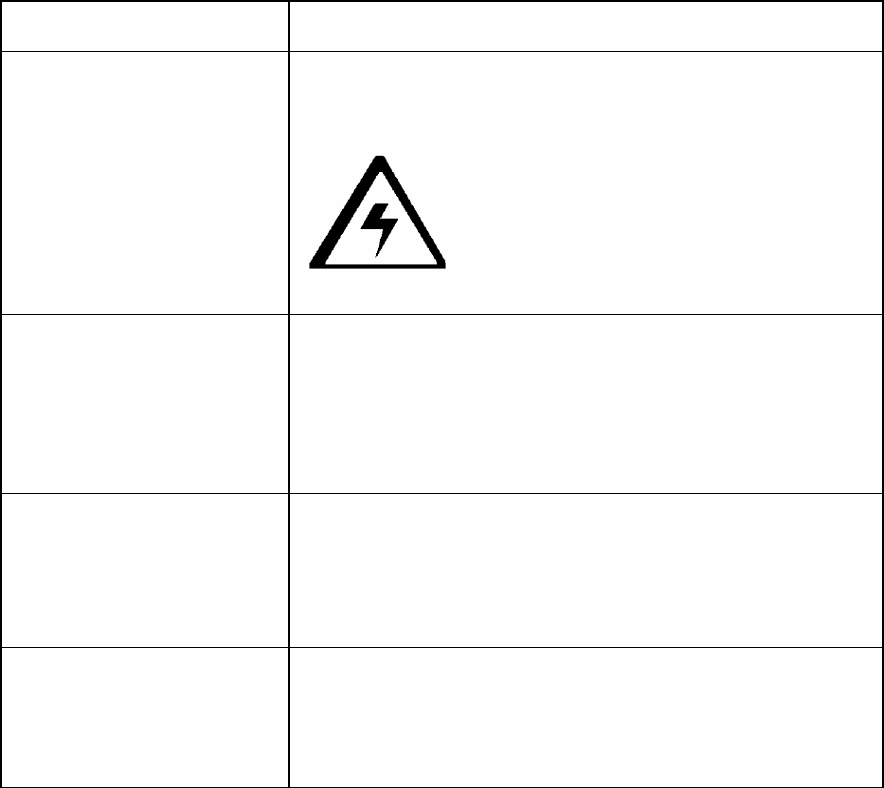
© 2010 HID Global Corporation All rights reserved
Selecting the Advanced Settings tab
Setting Option
Print Top of Form Use this option to adjust the length-wise or horizontal
position of the printed image on the card (so it appears to
be centered).
Caution: If the negative value is set too
high, the Print Ribbon may break.
Print End of Form Use this option to reduce or increase the overall printable
area; this is done in order to optimize edge to edge
printing toward the trailing edge of the card.
• Maximum adjustment range is +/- 200.
• Each increment equals .01”.
Print Left of Form Use this option to adjust the vertical position of the printed
image on the card; so it appears centered.
• Maximum Adjustment Range is +/- 127.
• Each increment equals .01”.
Cleaning Rate Use this option to adjust the number of cards printed
before the Printer displays a message indicating cleaning
is needed.
• The default value is 3000 cards.
DTC4500 Card Printer/Encoder User Guide 41
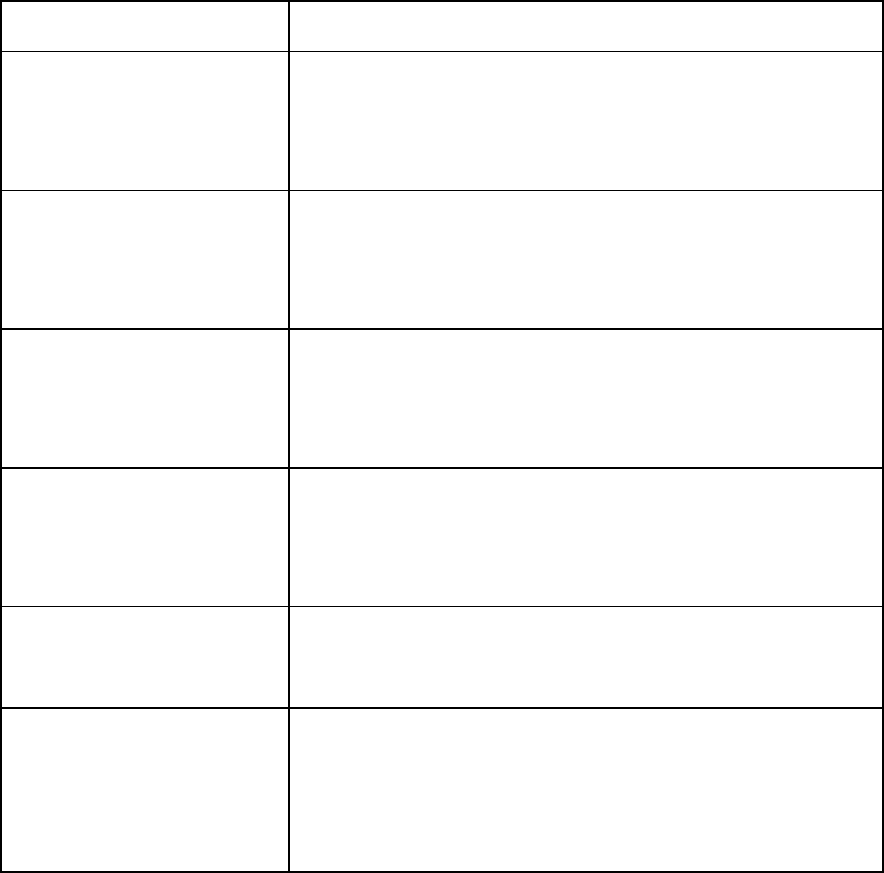
© 2010 HID Global Corporation All rights reserved
Selecting the Advanced Settings tab
Setting Option
Ribbon Calibrate Green This is a calibration driven value and should not be
adjusted.
(Note: This is factory set and should not be changed
unless directed by a technician.)
Ribbon Green LED Level This is a calibration driven value and should not be
adjusted.
(Note: This is factory set and should not be changed
unless directed by a technician.)
Ribbon Calibrate Green This is a calibration driven value and should not be
adjusted.
(Note: This is factory set and should not be changed
unless directed by a technician.)
Ribbon Blue LED Level This is a calibration driven value and should not be
adjusted.
(Note: This is factory set and should not be changed
unless directed by a technician.)
Ribbon Print Tension Use the Ribbon Tension option to increase or
decreases the amount of tension (drag) on the Ribbon
during printing.
Flipper Home Offset This is a calibration driven value and should not be
adjusted. If the Flipper unit is replaced and has not been
calibrated this value may need to be adjusted.
(Note: This is factory set and should not be changed
unless directed by a technician.)
DTC4500 Card Printer/Encoder User Guide 42
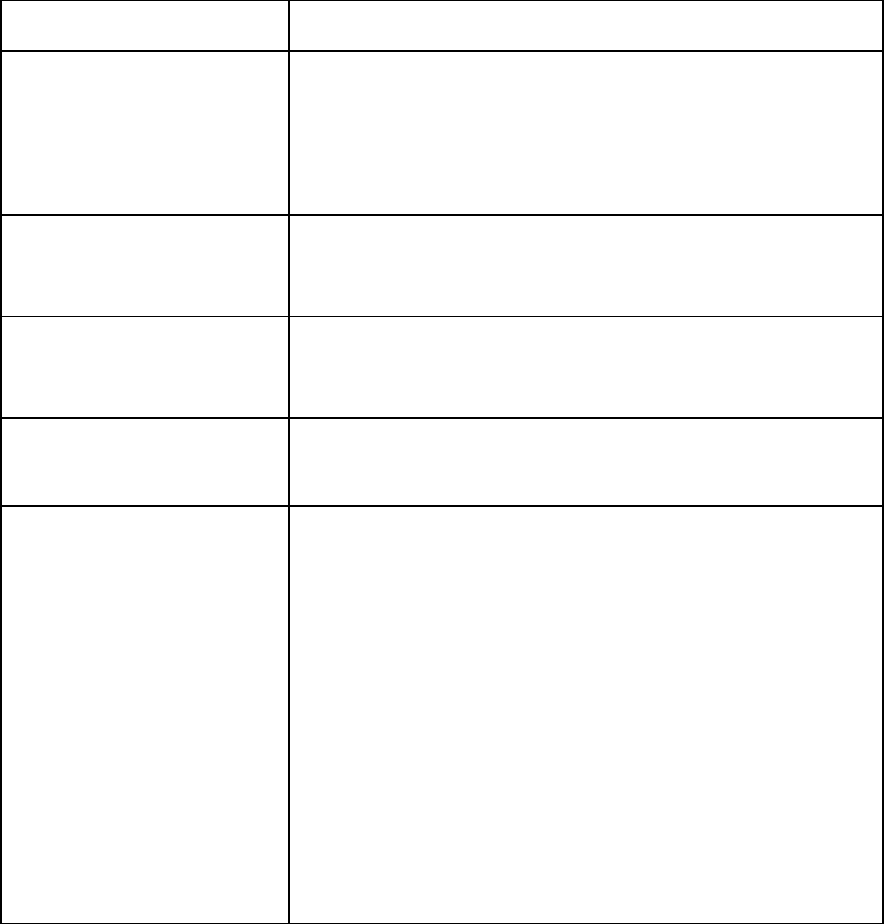
© 2010 HID Global Corporation All rights reserved
Selecting the Advanced Settings tab
Setting Option
Flipper Lam Height
Offset This is a calibration driven value and should not be
adjusted. If the Flipper unit is replaced and has not been
calibrated this value may need to be adjusted.
(Note: This is factory set and should not be changed
unless directed by a technician.)
Mag HI-Co Voltage Offset This option changes the voltage going the magnetic head.
(Note: This is factory set and should not be changed
unless directed by a technician.)
Mag Lo-Co Voltage
Offset This option changes the voltage going the magnetic head.
(Note: This is factory set and should not be changed
unless directed by a technician.)
OLED Contrast
(display contrast)
Use this option to increase or decrease the contrast of the
printer OLED (if applicable).
Resin Heat Adjust Use this adjustment for Black resin text and barcodes
appear faded or too light/dark.
Adjust the Resin Heat, Front (K) or the Resin Head, Back
(K) as needed.
• Move the slider to the left to cause less heat to be
used in the printing process, causing resin images to
be lighter or less saturated.
OR
• Move the slider to the right to (a) cause more heat to
be used or (b) cause the resin image to be darker or
more saturated.
(Note: This control can be helpful for fine-tuning the
transfer of resin text and bar codes.)
DTC4500 Card Printer/Encoder User Guide 43
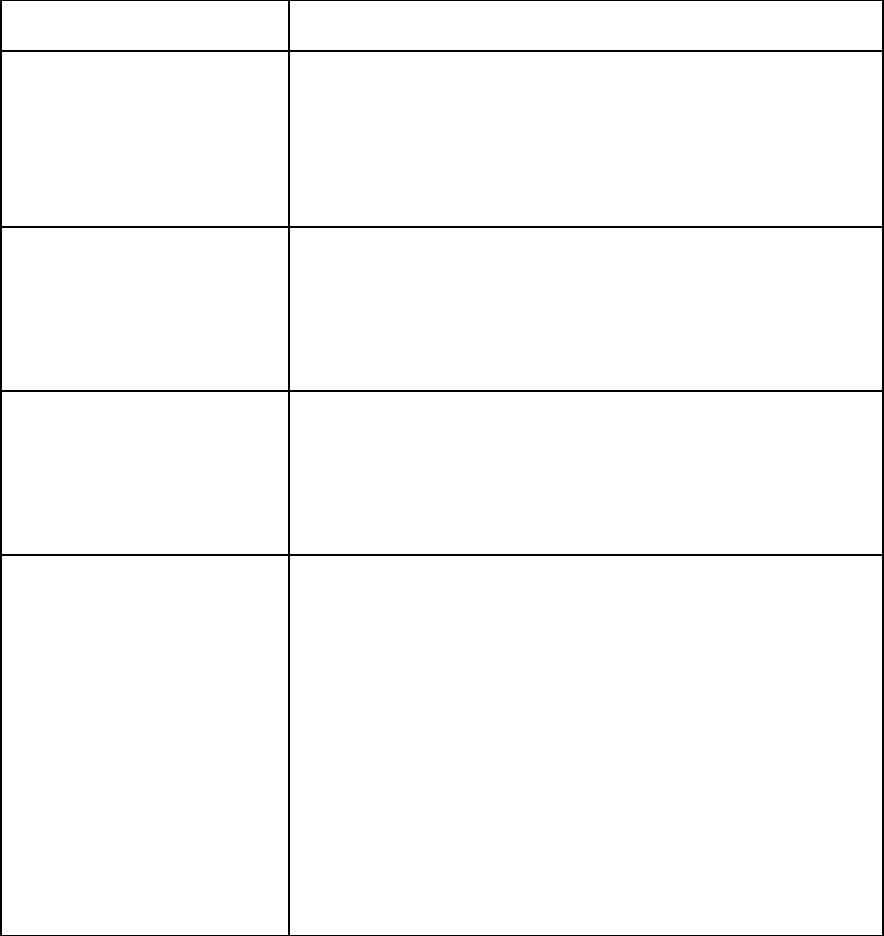
© 2010 HID Global Corporation All rights reserved
Selecting the Advanced Settings tab
Setting Option
Head Resistance This is factory set. If the main board or the Printhead is
replaced then adjust this number.
Locate the Printhead Setting Number on the bottom of the
Printhead.
The number reads R=XXXX.
Head Home Offset This is a calibration driven value and should not be
adjusted. If the Printhead assembly is replaced then this
value may need to be adjusted.
(Note: This is factory set and should not be changed
unless directed by a technician.)
Head Contact Offset This is a calibration driven value and should not be
adjusted. If the Printhead assembly is replaced then this
value may need to be adjusted.
(Note: This is factory set and should not be changed
unless directed by a technician.)
Erase Heat Offset Adjust the Erase temperature for the rewriteable cards as
needed.
• Increase the Current Setting to cause more heat to
be used in the erasing process.
OR
• Decrease the Current Setting to cause less heat to be
used in the erasing process.
(Note: Erase Temp Offset provides user ability to control
the Printhead heat level when the Erase Operation is
performed. Appropriate heat levels should be applied for
the proper erase process. This setting should be adjusted
for proper erasure.)
DTC4500 Card Printer/Encoder User Guide 44
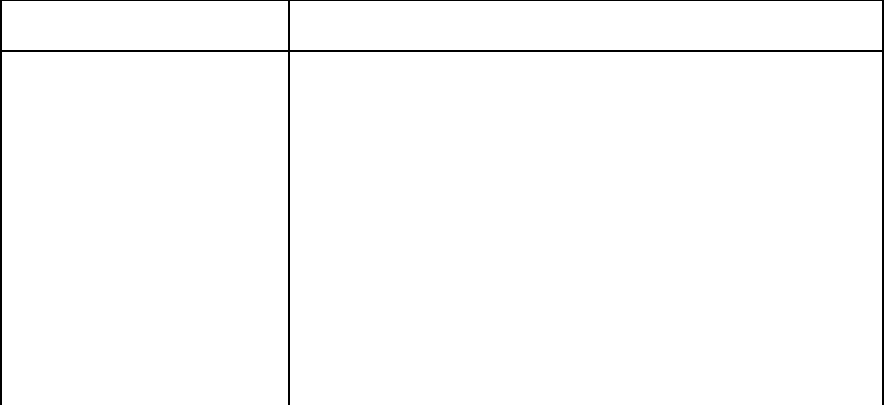
© 2010 HID Global Corporation All rights reserved
Selecting the Advanced Settings tab
Setting Option
Write Heat Offset Adjust the Write temperature for the rewriteable cards as
needed.
• Increase the Current Setting to cause more heat to
be used in the printing process of a rewritable card.
OR
• Decrease the Current Setting to cause less heat to be
used in the printing process of a rewritable card.
(Note: Write Heat Offset provides user ability to control
the Printhead heat level when the Write Operation is
performed. Appropriate heat levels should be applied for
the proper writing process.)
DTC4500 Card Printer/Encoder User Guide 45
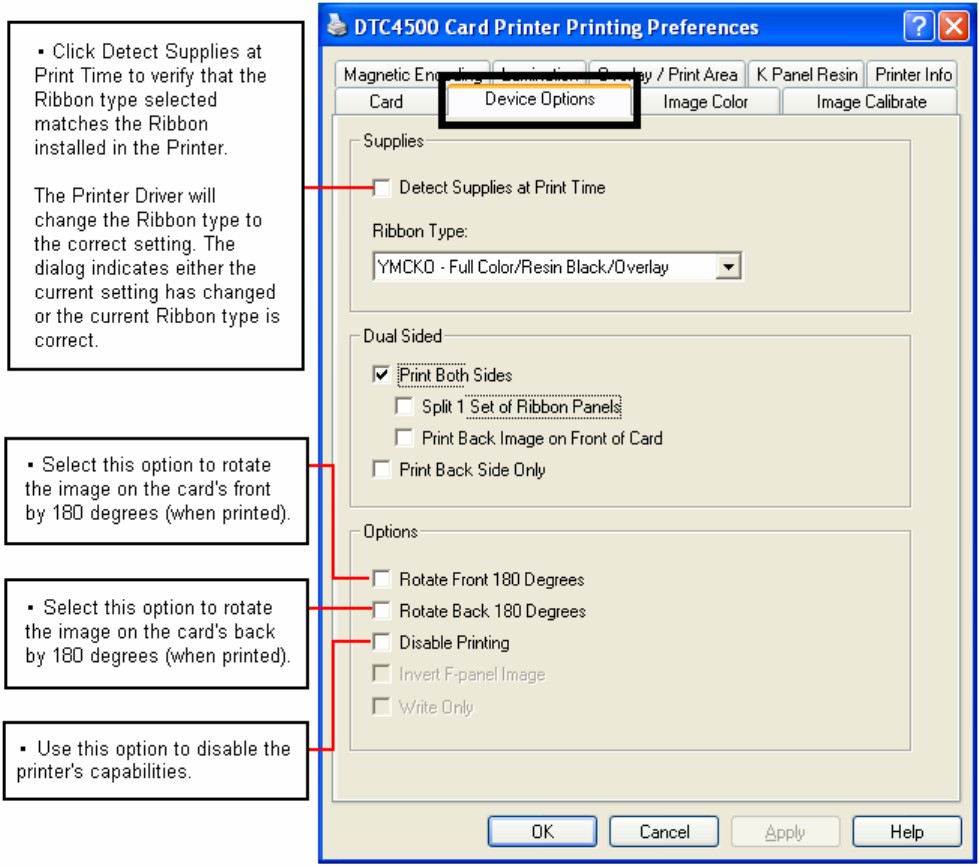
© 2010 HID Global Corporation All rights reserved
|contextid=40Using the Device Options tab
Click on the Device Option tab to bring up the window (shown below).
DTC4500 Card Printer/Encoder User Guide 46
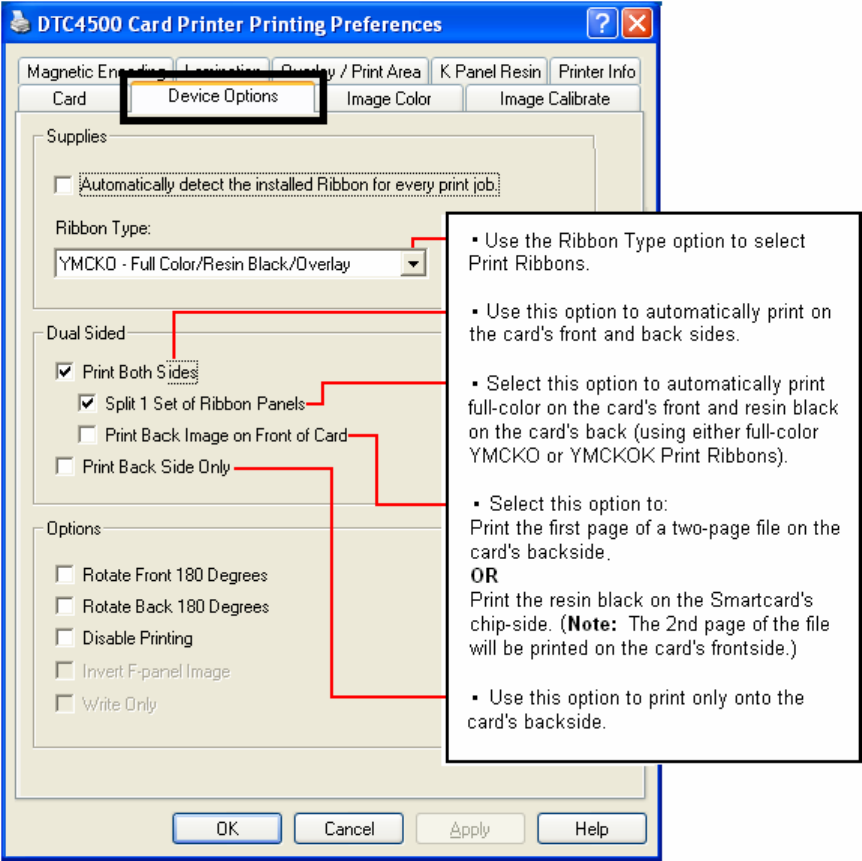
© 2010 HID Global Corporation All rights reserved
Using the Device Options tab
DTC4500 Card Printer/Encoder User Guide 47
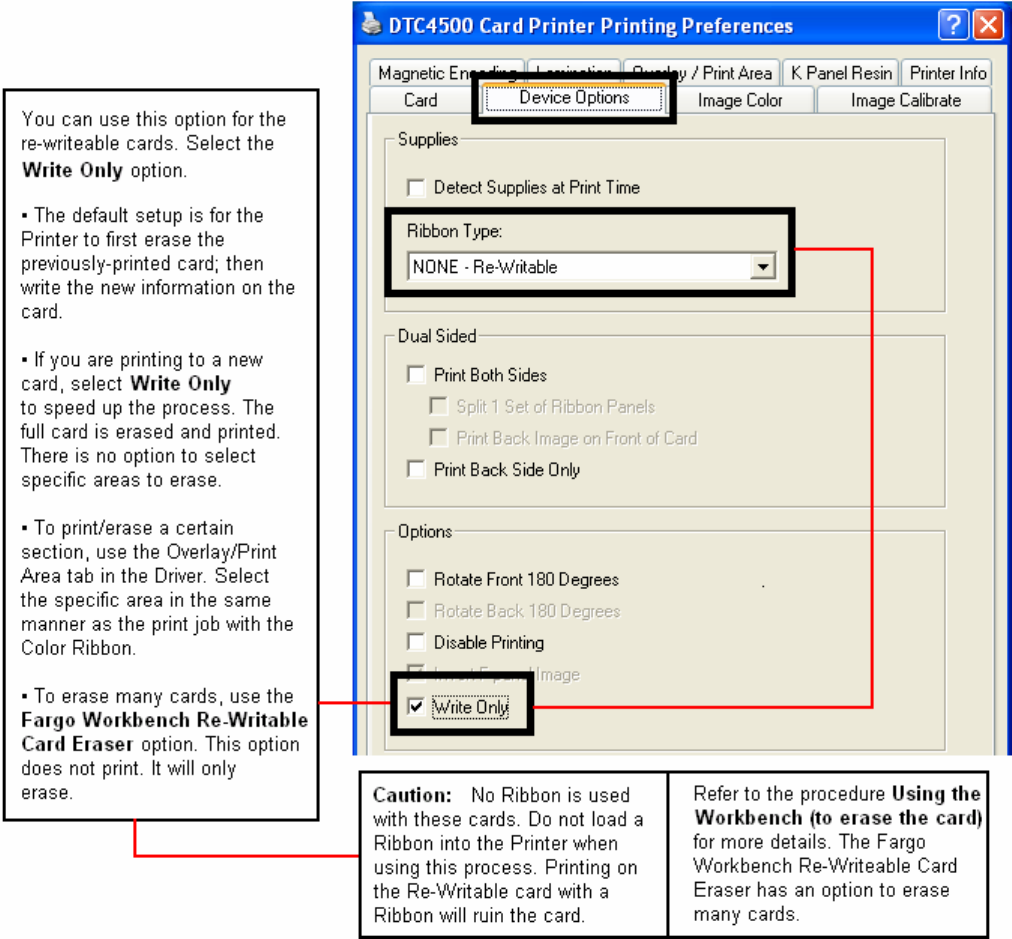
© 2010 HID Global Corporation All rights reserved
Using the Device Options tab
DTC4500 Card Printer/Encoder User Guide 48
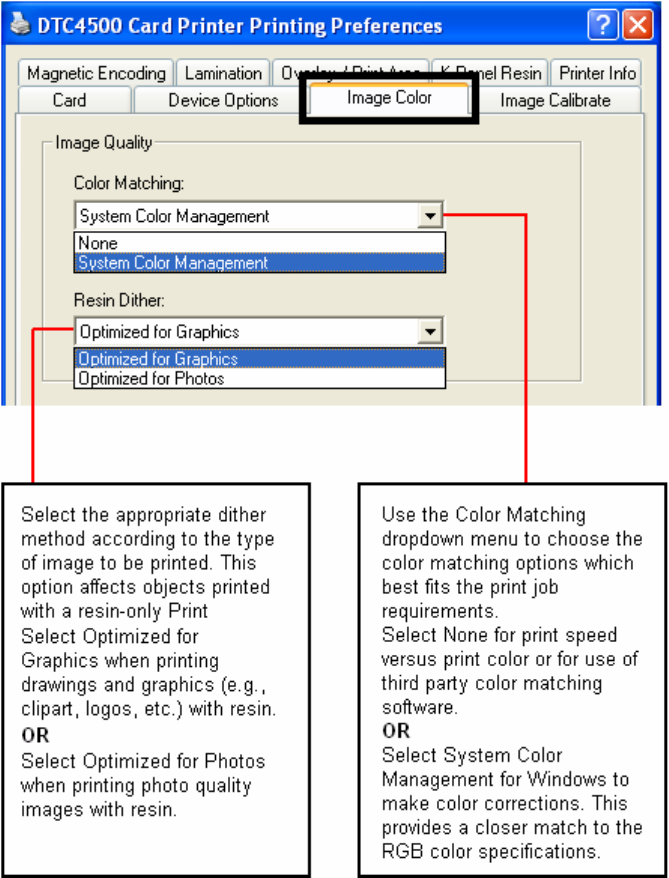
© 2010 HID Global Corporation All rights reserved
|contextid=50Using the Image Color tab
Click on the Image Color option tab to bring up the window (shown below).
DTC4500 Card Printer/Encoder User Guide 49
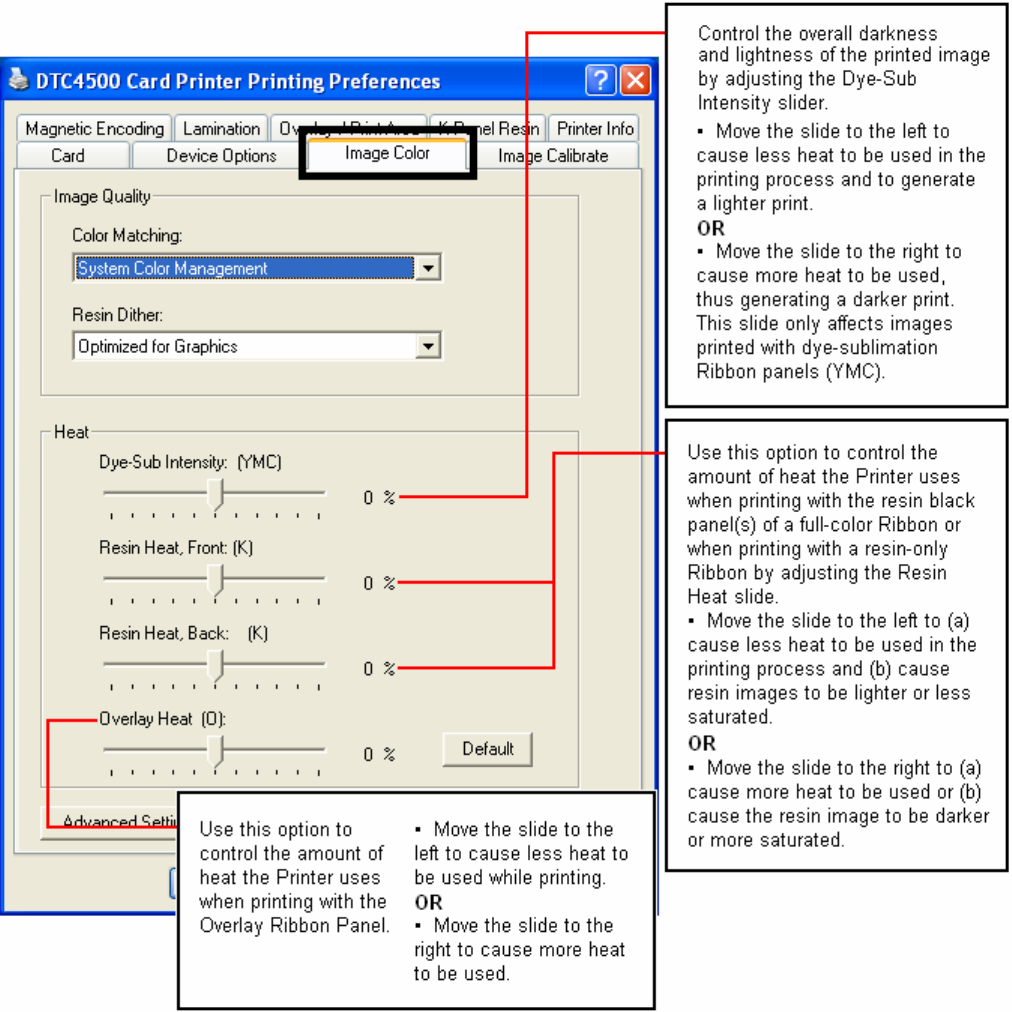
© 2010 HID Global Corporation All rights reserved
Using the Image Color tab
DTC4500 Card Printer/Encoder User Guide 50
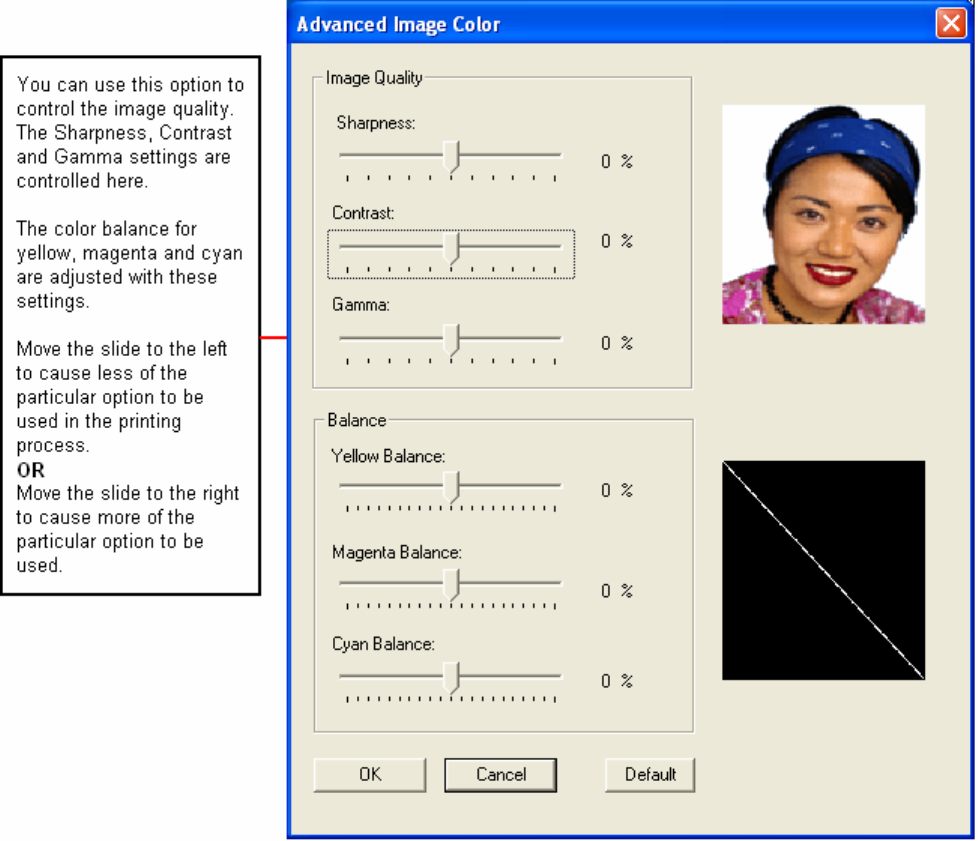
© 2010 HID Global Corporation All rights reserved
Using the Image Color tab
DTC4500 Card Printer/Encoder User Guide 51
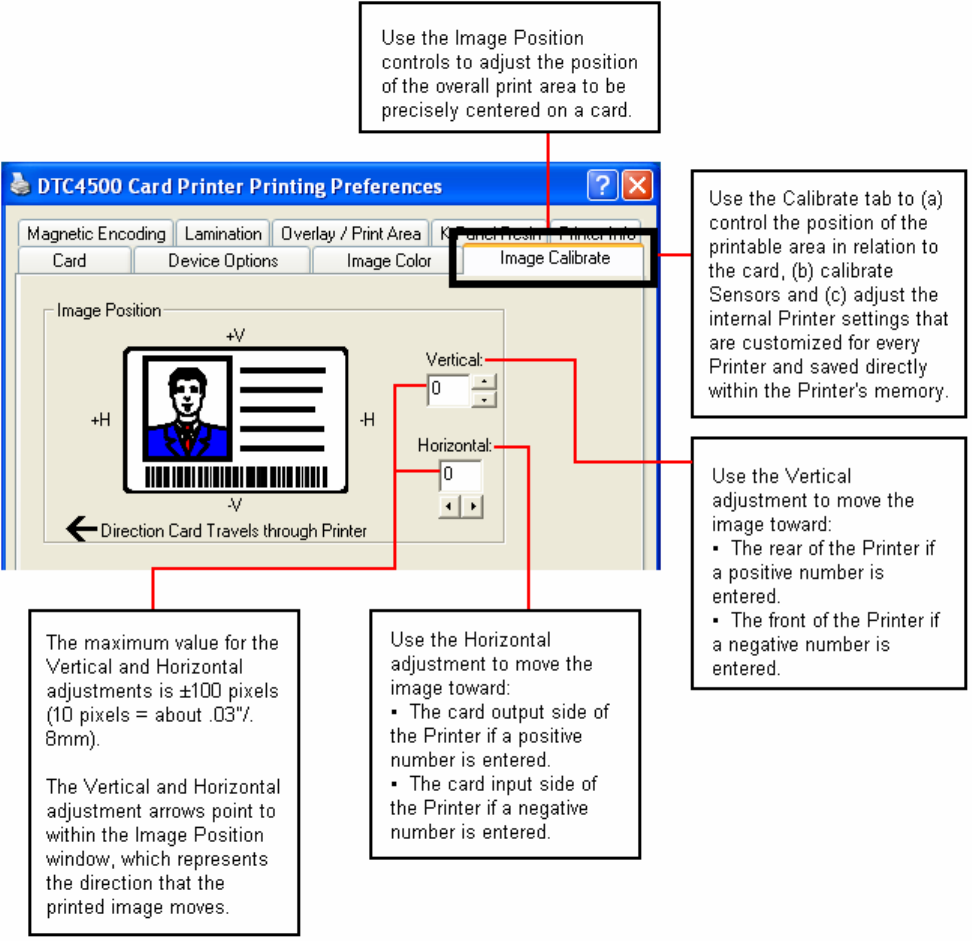
© 2010 HID Global Corporation All rights reserved
|contextid=51Using the Image Calibrate tab
Use the Image Calibrate tab to control the position of the printable area in relation to the card.
DTC4500 Card Printer/Encoder User Guide 52
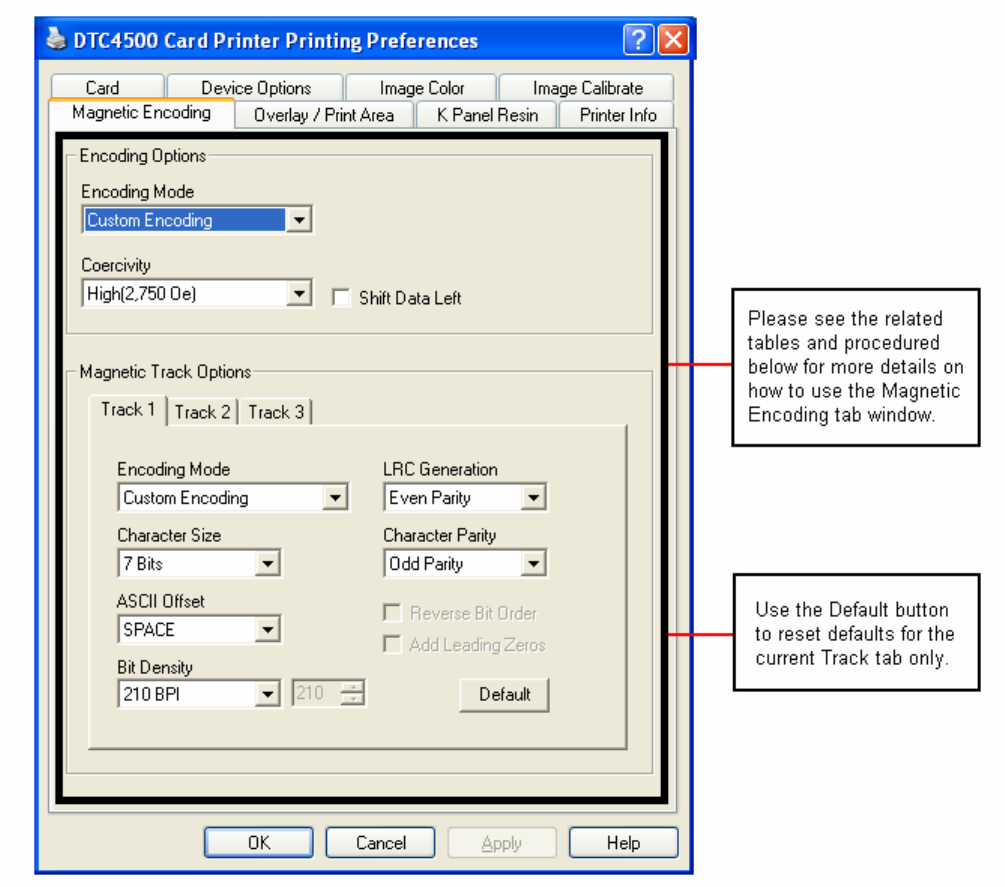
© 2010 HID Global Corporation All rights reserved
|contextid=70Using the Magnetic Encoding Tab
Select the Magnetic Encoding tab to display options for controlling the Magnetic Stripe encoding
process.You should use these options only if the Printer has an optional Magnetic Stripe Encoding
Module installed.
DTC4500 Card Printer/Encoder User Guide 53
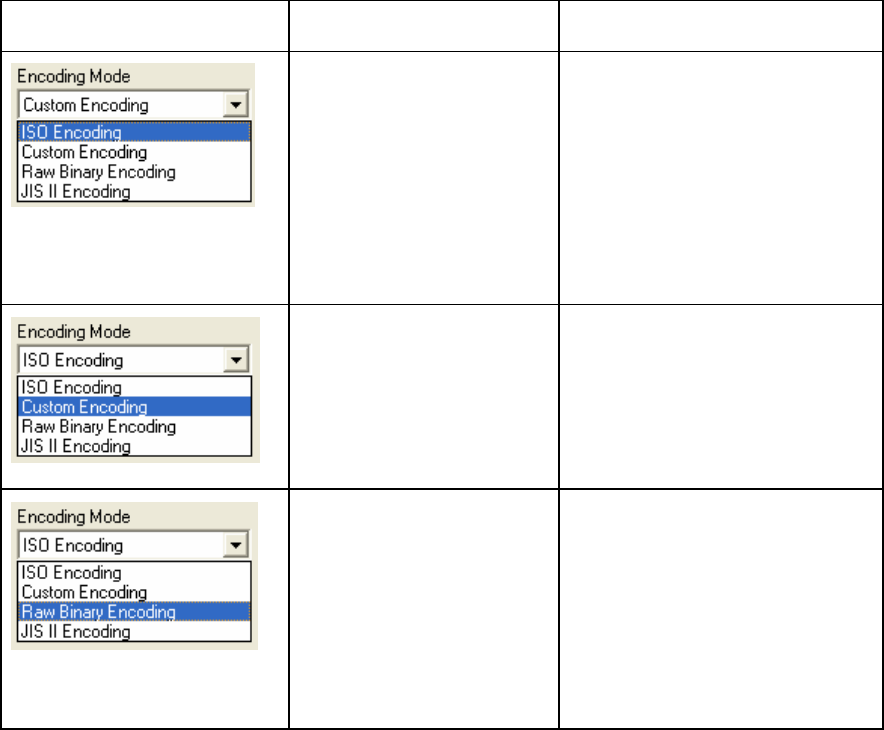
© 2010 HID Global Corporation All rights reserved
Using the Magnetic Encoding Tab – ISO Standards
You can change the encoding mode and coercivity setting or modify the ISO standards for Tracks 1, 2
and 3. This can be done by correctly modifying these Magnetic Encoding options.
Window TAB Procedure Procedure (continued)
If you select ISO
Encoding, you send
down a formatted set of
characters.
This selection activates the
track tabs. However, all
functions on the Track tabs
are inactive or gray and
display ISO defaults, which
are the defaults listed for each
track below. The Shift Data
Left check box remains
unchecked and inactive.
If you select Custom
Encoding, all options
are active.
The Default is ISO Encoding.
(Note: The defaults are the
same as the ISO Encoding
defaults.)
All functions on the Magnetic
Track Options tabs are active.
If you select Raw
Binary Encoding, you
send down a raw binary
string rather than a
formatted set of
characters.
The Coercivity dropdown
function is active and the
Shift Data Left checkbox is
not active.
All functions on the Magnetic
Track Options tabs are
inactive except for Bit
Density.
DTC4500 Card Printer/Encoder User Guide 54
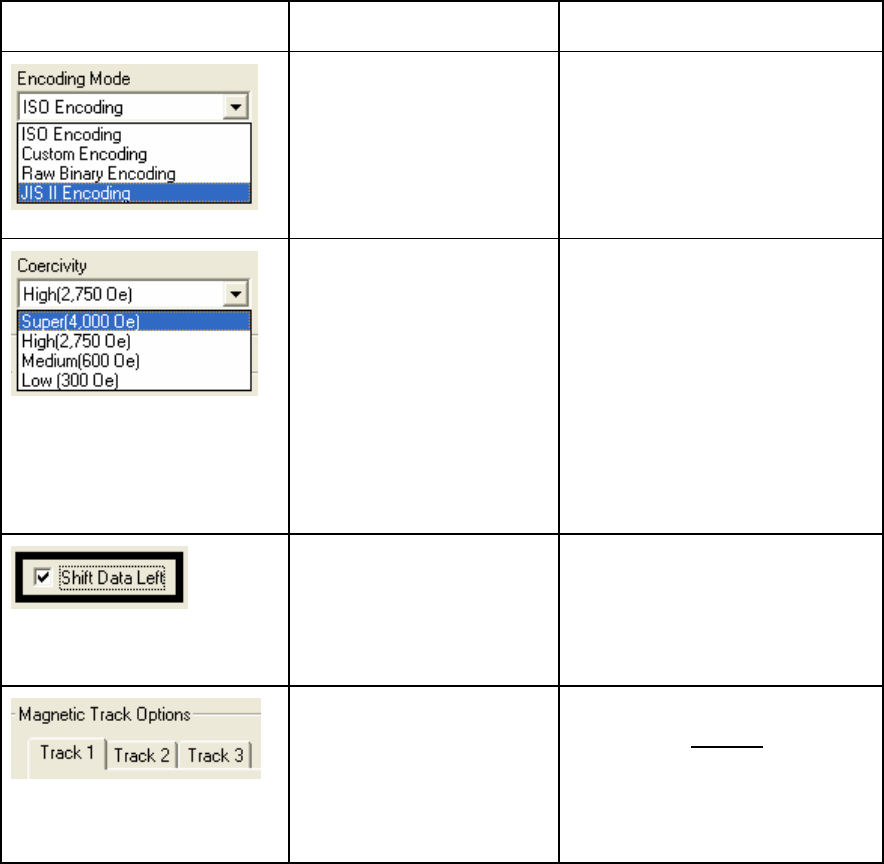
© 2010 HID Global Corporation All rights reserved
Using the Magnetic Encoding Tab – ISO Standards
Window TAB Procedure Procedure (continued)
If you select JIS II
Encoding, specific
standards are used.
This selection disables all the
Magnetic Track Options tabs.
It also disables the Coercivity
dropdown function and Shift
Data Left checkbox option.
The default Coercivity is 600 Oe.
Select the Coercivity
option (Oersted) to use
the Magnetic Stripe type
that matches the card
type.
• High Coercivity to Super
Coercivity = 2750-4000
Oersted
• Fargo’s High Coercivity
UltraCard IIIs are 2750 Oe
• Medium Coercivity=600
Oersted
• Low Coercivity = 300
Oersted
Select this option to shift
the recorded magnetic
data to the left-hand
side of the card's
Magnetic Stripe.
This is useful in situations that
require cards to be readable
with insert type readers.
Select the Magnetic
Track Selection option
to specify which track is
to be configured through
the Magnetic Track
Options.
This applies if the application
being used requires
customization of the standard
ISO encoding process.
DTC4500 Card Printer/Encoder User Guide 55
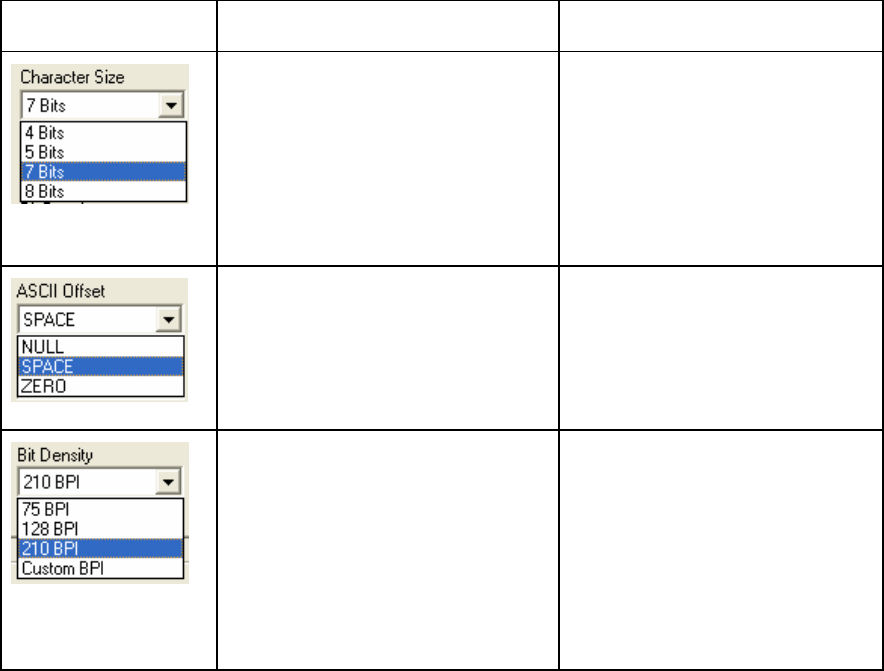
© 2010 HID Global Corporation All rights reserved
Using the Magnetic Encoding Tab – Custom Encoding or Raw Binary
Encoding Mode
You can change the Magnetic Track options for Tracks 1, 2 and 3 when using the Custom Encoding or
Raw Binary Encoding Mode. These options are not availabe for ISO or JIS II encoding.
Window TAB Procedure Procedure (continued)
Select 4 Bits to change the bits
per character to 4 BPC. (Note:
This is the default for Track 3).
Select 5 Bits to change the bits
per character to 5 BPC. (Note:
This is the default for Tracks 2
and 3).
Select 7 Bits to change the
bits per character to 7 BPC.
(Note: This is the default for
Track 1).
Select 8 Bits to change the
bits per character to 8 BPC.
Select NULL to change the
ASCII Offset to NULL.
Select SPACE to change the
ASCII Offset to SPACE. (Note:
This is the default for Track 1.)
Select ZERO to change the
ASCII Offset to ZERO. (Note:
This is the default for Tracks 2
and 3.)
Select 75 BPI to change the bits
per inch to 75 BPI. (Note: This
is the default for Track 2.)
Select 128 BPI to change the
bits per inch to 128 BPI.
Select 210 BPI to change the
bits per inch to 210 BPI.
(Note: This is the default for
Tracks 1 and 3.)
Select Custom BPI, which
enables the custom BPI text
box. (Note: The lower limit is
75 and upper limit is 210.)
DTC4500 Card Printer/Encoder User Guide 56
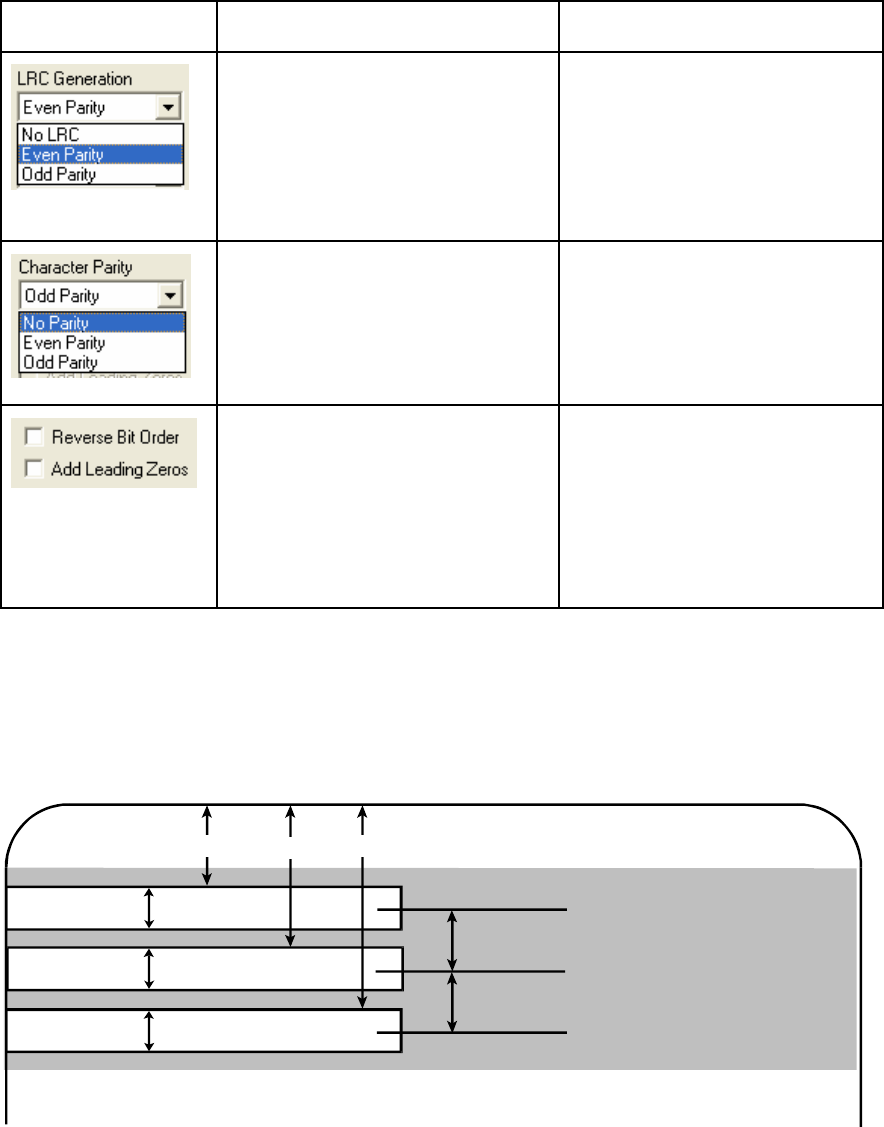
© 2010 HID Global Corporation All rights reserved
Using the Magnetic Encoding Tab – Custom Encoding or Raw Binary
Encoding Mode
Window TAB Procedure Procedure (continued)
Select No LRC to change the
LRC Generation to none.
Select Even Parity to change
the LRC Generation to Even
Parity. (Note: This is the default
for all tracks.)
Select Odd Parity to change
the LRC Generation to Odd
Parity.
Select No Parity to change the
Character Parity to none.
Select Even Parity to change
the Character Parity to Even
Parity.
Select Odd Parity to change
the Character Parity to Odd
Parity. (Note: This is the
default for all tracks.)
Reverse Bit Order is used to
reverse the character bits and is
used for the encryption of data
in specific programs
Add Leading Zeros is used to
add a set number of leading
zeros to the magnetic string in
order to move the starting
point of the encoded data in
specific programs for
encryption of data.
Reviewing the ISO Track Locations
The magnetic Encoding Module encodes onto tracks in accordance with an ISO 7811-2 Magnetic Stripe.
For track locations, review the display below.
TRACK1 0.110"
TRACK2 0.110"
TRACK3 0.110"
0.130"
0.140"
0.223" 0.353" 0.493"
DTC4500 Card Printer/Encoder User Guide 57
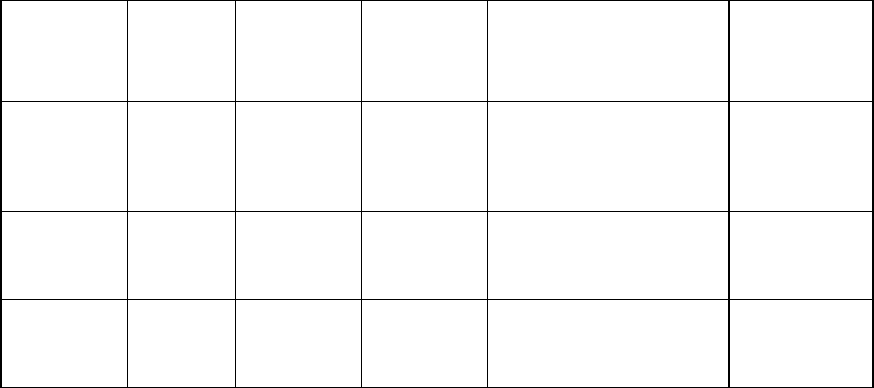
© 2010 HID Global Corporation All rights reserved
Reviewing the Sample String
• Track 1: ~1%JULIEANDERSON^1234567890?
• Track 2: ~2;1234567890987654321?
• Track 3: ~3;1234567890987654321?
Track Start
Sentinel End
Sentinel Field
Separator Valid Characters Maximum
Number of
Characters
Track 1 % ? ^ ASCII 32-95
(See the table below.) 78
Track 2 ; ? = ASCII 48-63
(See the table below.) 39
Track 3 ; ? = ASCII 48-63
(See the table below.) 106
DTC4500 Card Printer/Encoder User Guide 58
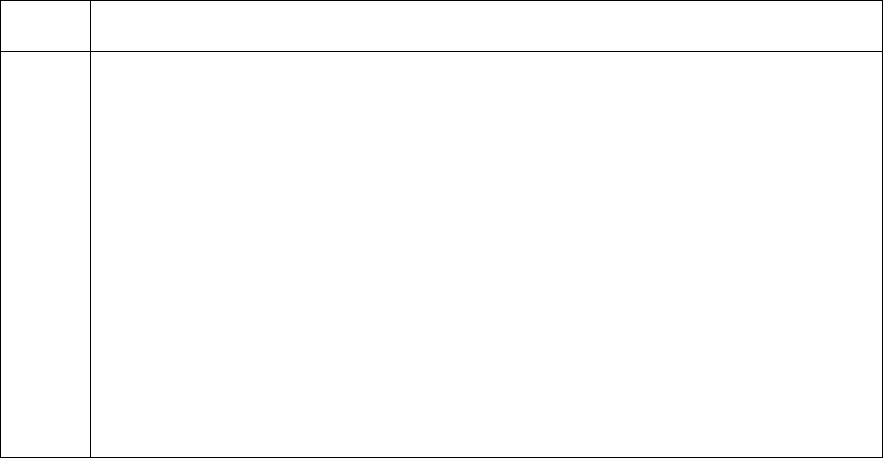
© 2010 HID Global Corporation All rights reserved
Sending the Track Information
Magnetic track data is sent in the form of text strings from the application software to the Printer Driver.
• In order for the Printer Driver to differentiate between Magnetic Track data and the rest of the
printable objects, specific characters must be added to the magnetic data to be encoded.
• These specify the data that is to be encoded, the tracks to encode and mark the start and stop of the
data string. In some cases, these specific characters are automatically added to the string of track
data by ID software applications.
• In most cases, the user must carefully add these characters to the string of Magnetic Track data. If
these characters are not added to the track data, the text intended for the Magnetic Track will appear
as printed text on the card. To avoid this, track information must be entered as described below.
Step Procedure
1 When entering track data, the ~ (tilde) character is entered first, followed by the
track number (1, 2 or 3) on which the data should encode. This is followed by
the data to be encoded.
• The first character of this data string must be the track's specific Start
Sentinel (SS) and the last character must be the specific End Sentinel
(ES).
• The characters or data in between the SS and ES can include all of the
valid characters specific to each track.
• The number of these characters, however, is limited by each track's
maximum character capacity.
• When segmenting track data, the appropriate Field Separator (FS) must be
used. The table below shows the SS, ES, FS and the valid characters
defined for each track.
DTC4500 Card Printer/Encoder User Guide 59
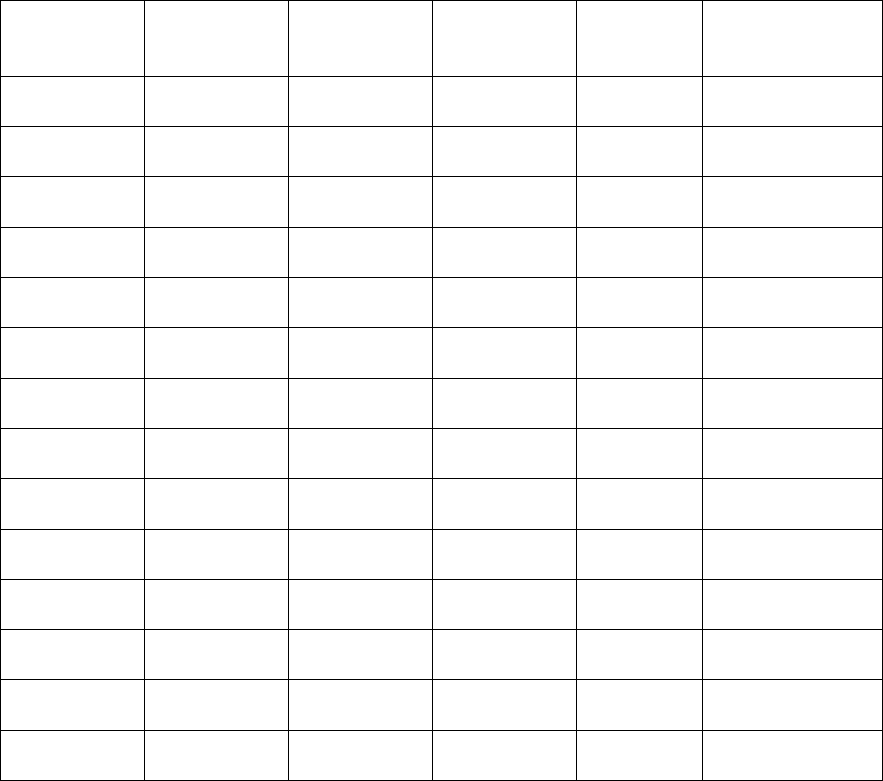
© 2010 HID Global Corporation All rights reserved
Reviewing the ASCII Code and Character Table
ASCII Code Character ASCII Code Character ASCII
Code Character
32 space 56 8 80 P
33 ! 57 9 81 Q
34 58 : 82 R
35 # 59 ; 83 S
36 $ 60 < 84 T
37 % 61 = 85 U
38 and 62 > 86 V
39 ' 63 ? 87 W
40 ( 64 @ 88 X
41 ) 65 A 89 Y
42 * 66 B 90 Z
43 + 67 C 91 [
44 ' 68 D 92 \
45 - 69 E 93 ]
DTC4500 Card Printer/Encoder User Guide 60
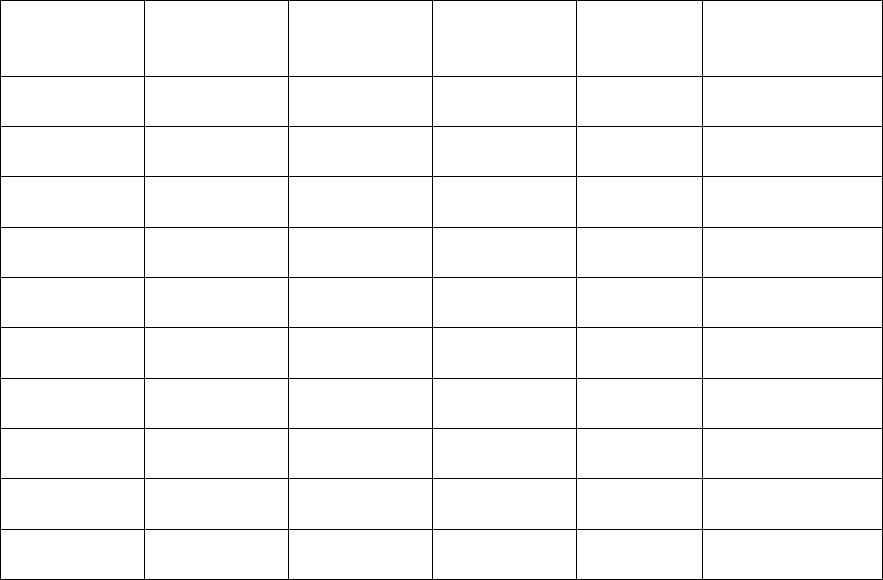
© 2010 HID Global Corporation All rights reserved
Reviewing the ASCII Code and Character Table
ASCII Code Character ASCII Code Character ASCII
Code Character
46 . 70 F 94 ^
47 / 71 G 95 _
48 0 72 H
49 1 73 I
50 2 74 J
51 3 75 K
52 4 76 L
53 5 77 M
54 6 78 N
55 7 79 O
DTC4500 Card Printer/Encoder User Guide 61
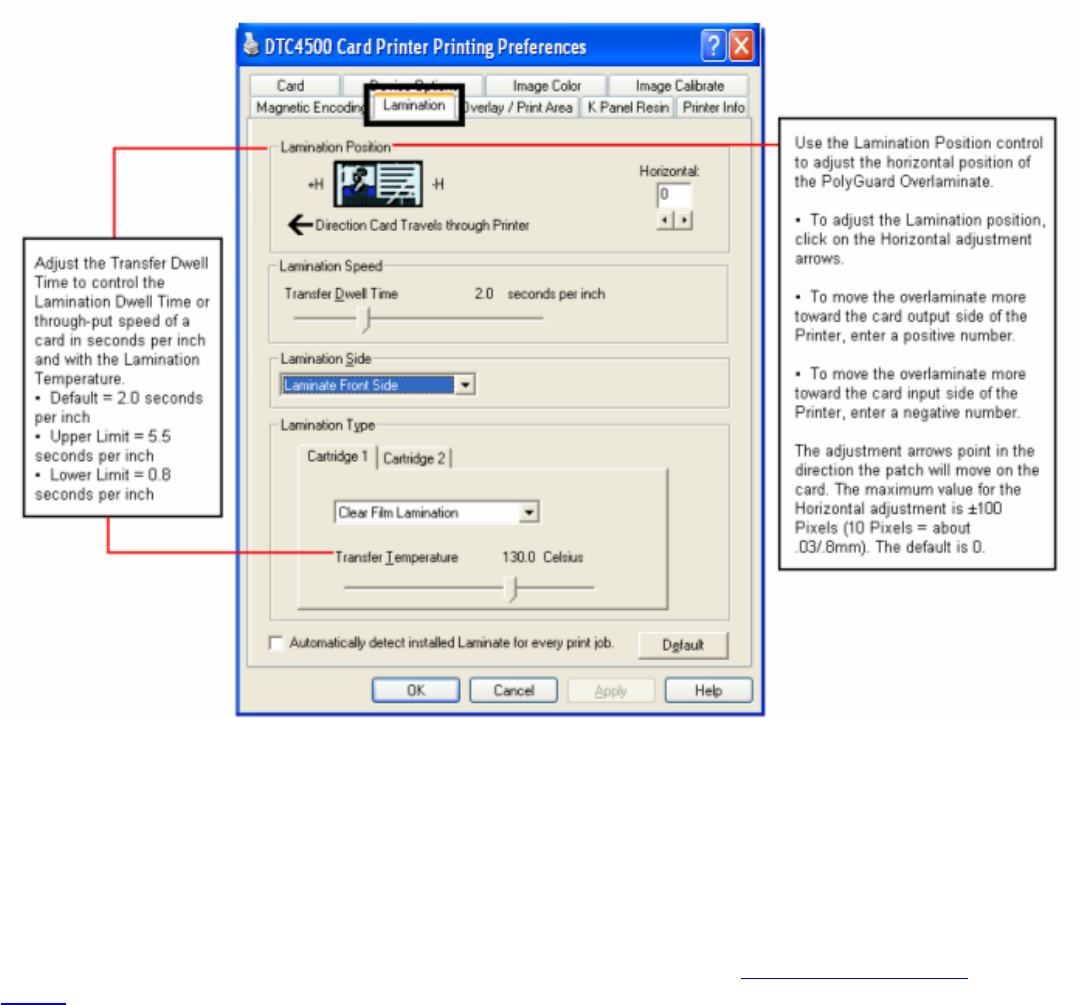
© 2010 HID Global Corporation All rights reserved
|contextid=80Using the Lamination tab
Use the Image Calibrate tab to control the position of the printable area in relation to the card.
|contextid=90 Using the Overlay / Print Area tab
This option is helpful if, for example, you would like to omit the printing or block out the overlay for a
signature or printing around a card's smart chip or Magnetic Stripe. Refer to Using the Defined Area
Option for a specific procedure that relates to this tab.
DTC4500 Card Printer/Encoder User Guide 62
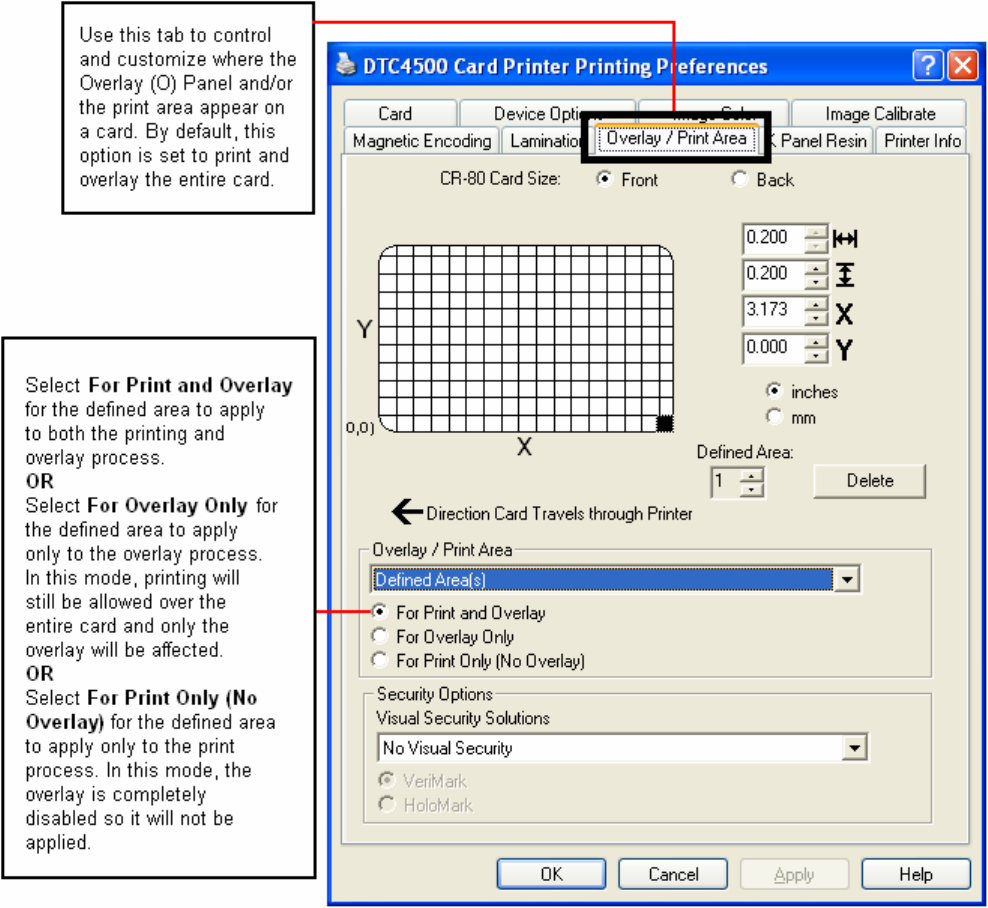
© 2010 HID Global Corporation All rights reserved
DTC4500 Card Printer/Encoder User Guide 63
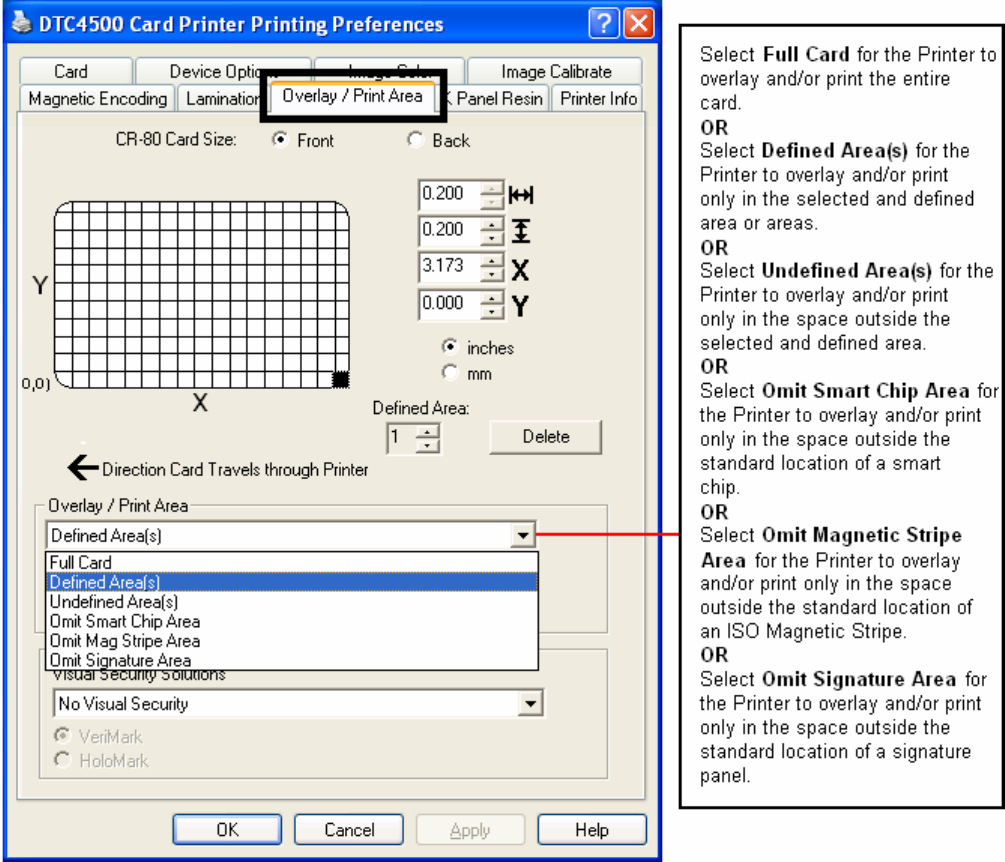
© 2010 HID Global Corporation All rights reserved
Using the Overlay / Print Area tab
DTC4500 Card Printer/Encoder User Guide 64
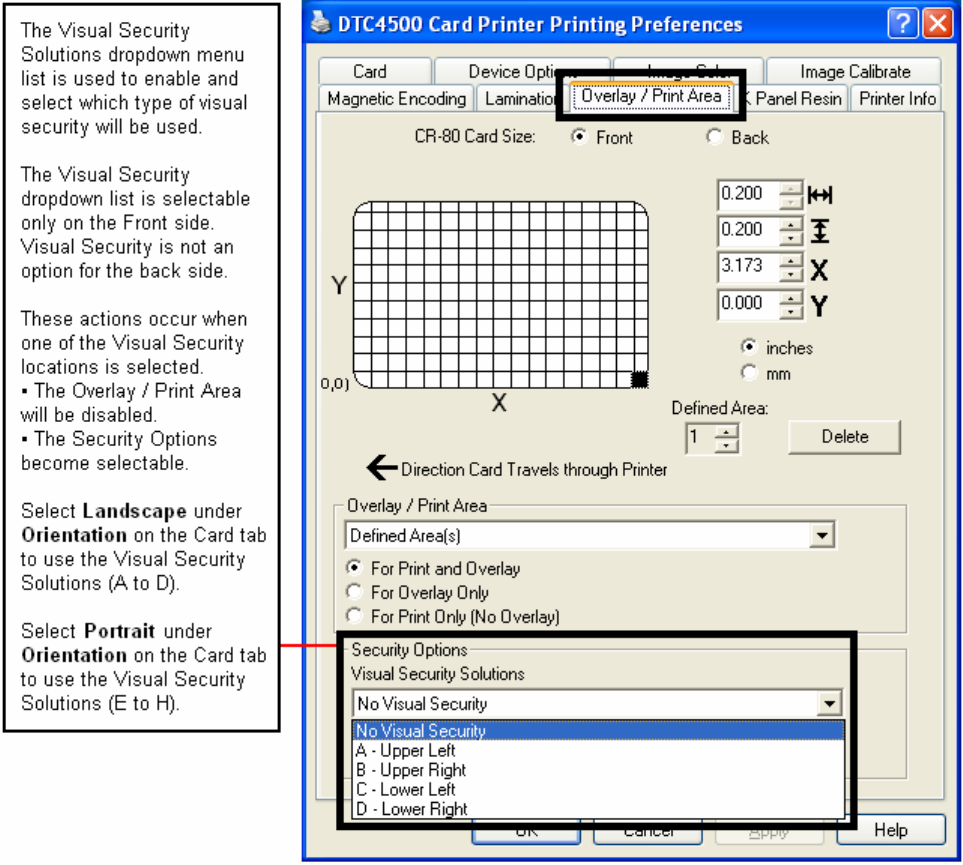
© 2010 HID Global Corporation All rights reserved
Using the Overlay / Print Area tab
DTC4500 Card Printer/Encoder User Guide 65
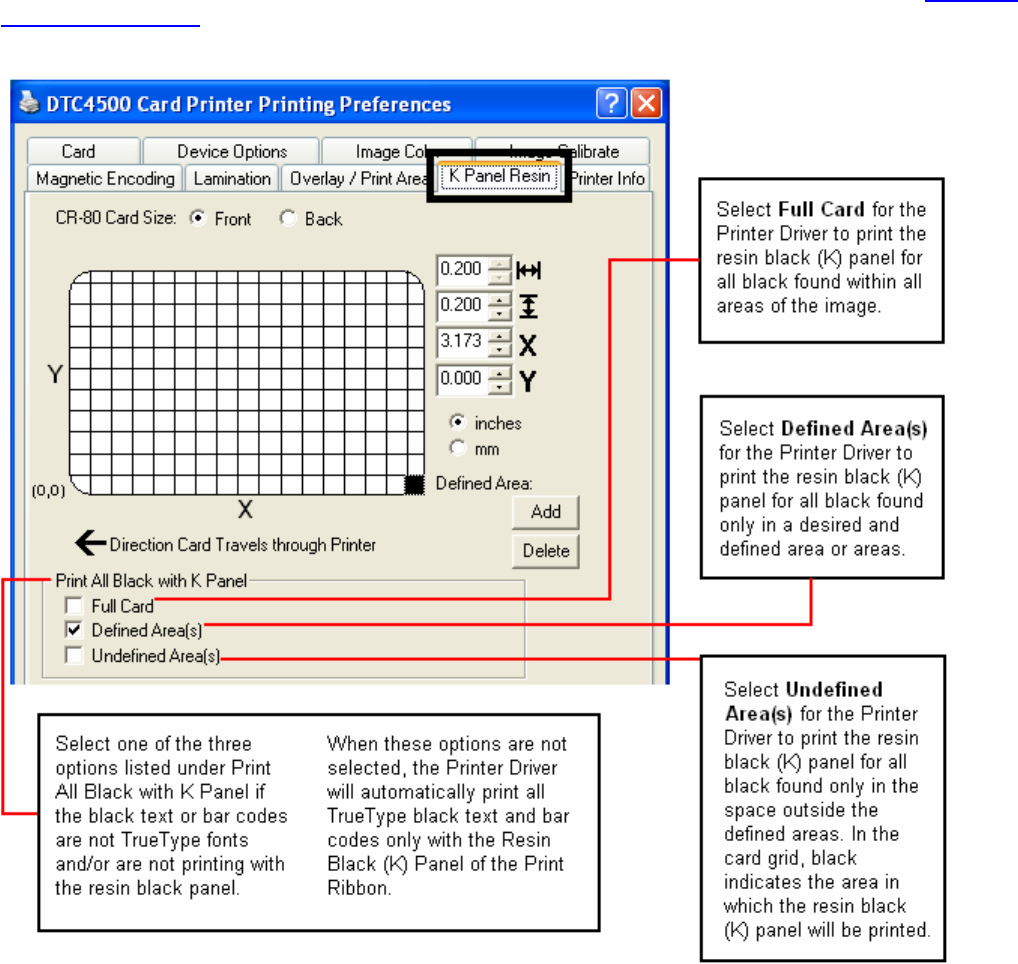
© 2010 HID Global Corporation All rights reserved
|contextid=100Using the K Panel Resin tab
Use this tab to control where the resin black (K) Panel of a full-color Ribbon is printed. Refer to Using the
Defined Area Option for a specific procedure that relates to this tab.
DTC4500 Card Printer/Encoder User Guide 66
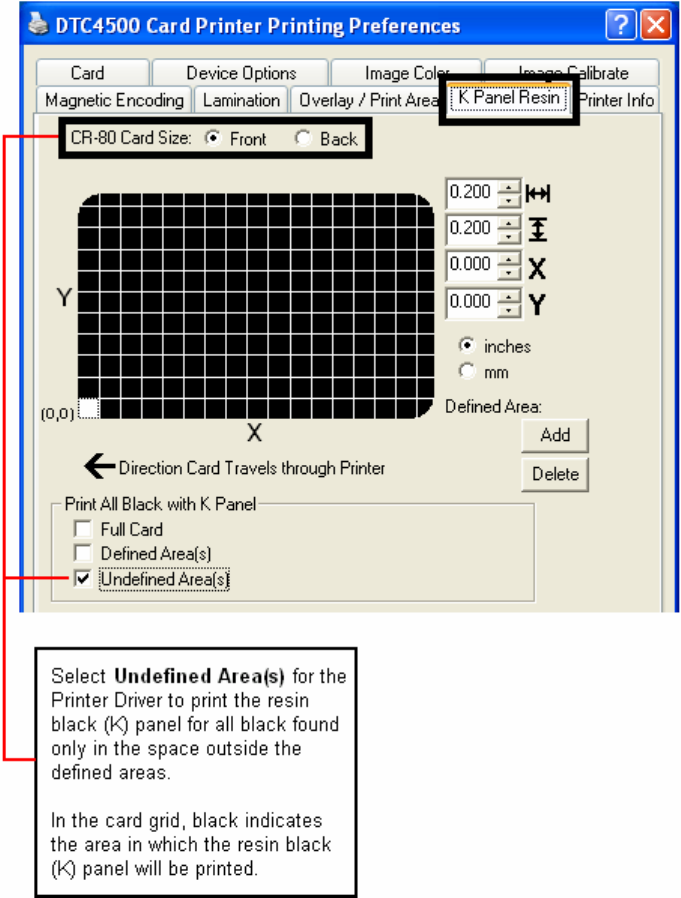
© 2010 HID Global Corporation All rights reserved
Using the K Panel Resin tab
DTC4500 Card Printer/Encoder User Guide 67
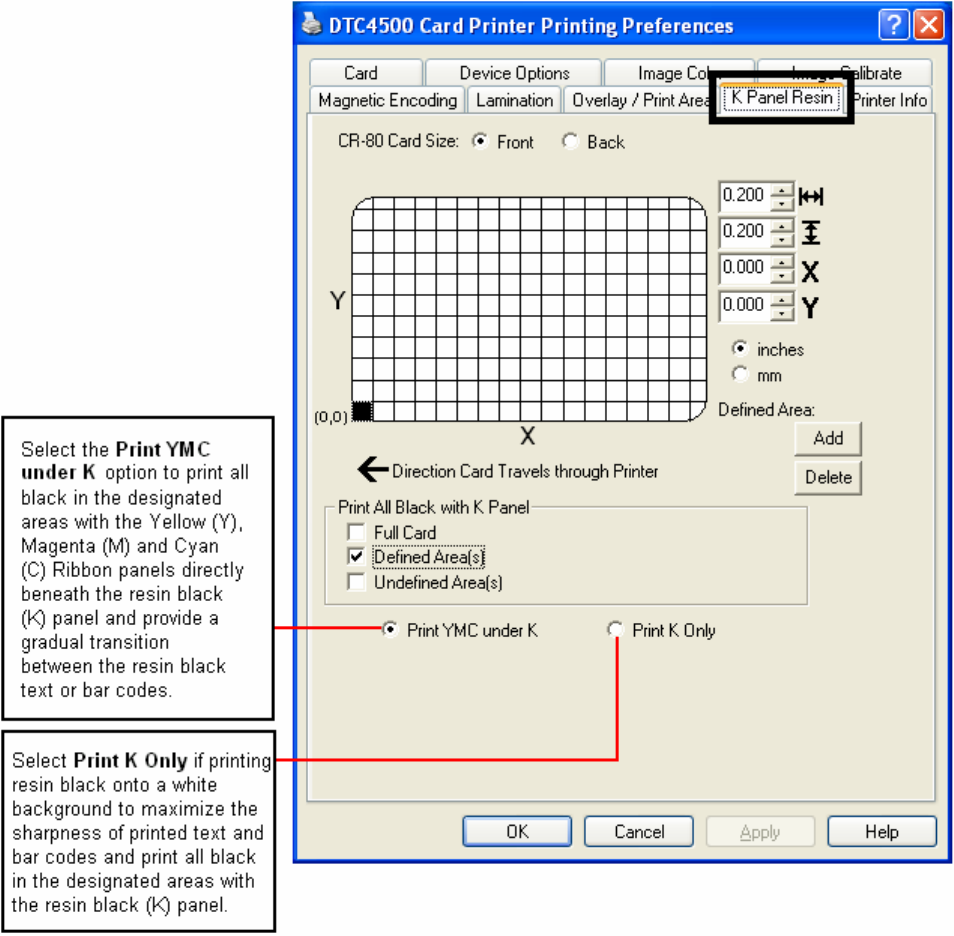
© 2010 HID Global Corporation All rights reserved
Using the K Panel Resin tab
DTC4500 Card Printer/Encoder User Guide 68
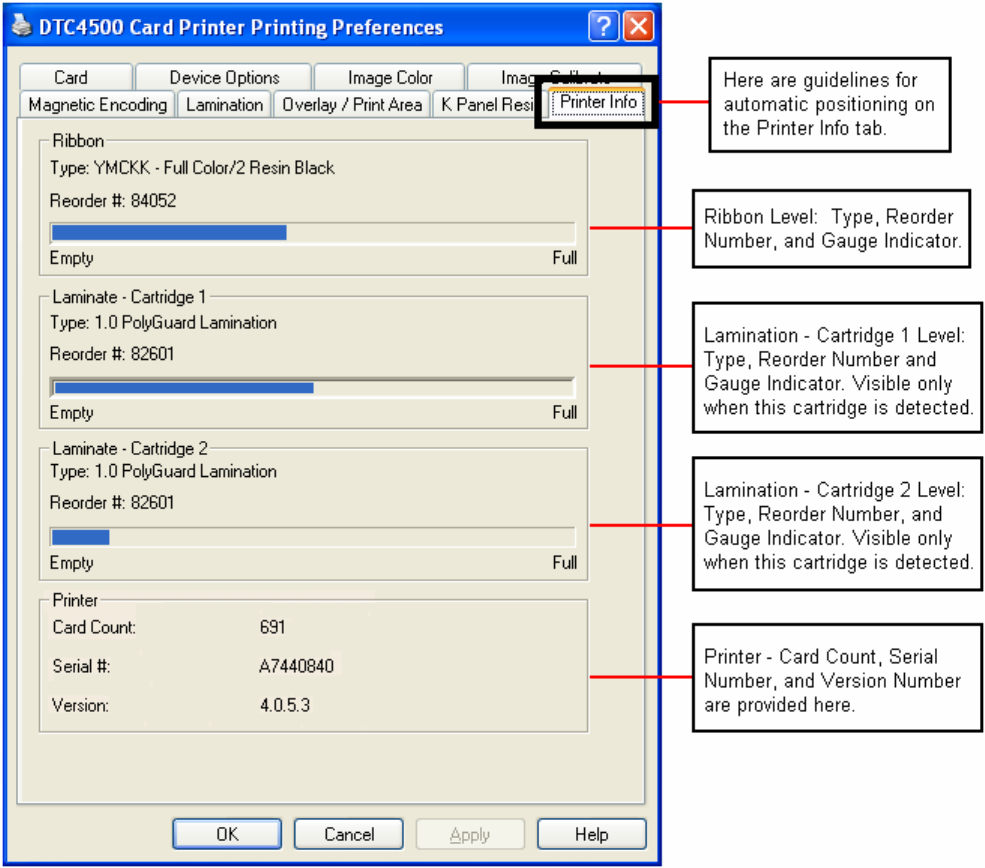
© 2010 HID Global Corporation All rights reserved
|contextid=120Using the Printer Info tab
Use the options on this tab to view information about the Ribbon, Laminate, Card Count, Printer Serial #,
Firmware version, and Reorder Media #’s installed in the Printer.
DTC4500 Card Printer/Encoder User Guide 69

© 2010 HID Global Corporation All rights reserved
Section 5: Selecting the Fluorescent Panel Ribbon
Type
The YMCFKO/YMCFKOK Ribbon is an economical way to add a fully customizable, incremental level of
security to your photo identification cards.
• Process: This process allows you to configure the data that is printed with the fluorescent panel of
an YMCFKO/YMCFKOK Ribbon. (Note: Any software program may be used to print the special
florescent panel of the Ribbon to a card once the Driver and Workbench are set up correctly.)
• Ribbons: These Ribbons contain a yellow (Y), magenta (M), cyan (C), and resin black (K) panels to
create a full color over-the-edge printing identification card. In addition, the Ribbon contains a dye-
based fluorescing panel (F) which will allow you to print a standard or one-to-one personalized
grayscale fluorescing image that is completely invisible until exposed to ultraviolet light.
Creating a Custom Fluorescent Image (using the YMCFKO Ribbon)
There are three (3) methods used to accomplish the creation of a custom fluorescent image when using
the YMCFKO Ribbon.
• First Method: The first method uses the Fargo Workbench Printer Utility to create a static image that
will be applied automatically to each card sent to the Printer. Refer to the Help file for the Fargo
Workbench Utility Program and User Guide or to Appendix A for Configuring Fluorescent Data
(F-Panel for YMCFKO Ribbon) using the Workbench.
• Second Method: The second method (described below) allows the creation of the fluorescent panel
image directly from the badge application software. (Note: You can now print a unique fluorescent
image, such as the card holder’s picture on each card.)
• Third Method: The third method is described in the Asure ID 2009 Software User Guide. See the
procedure relating to the Fluorescent Panel Ribbon. For more information about Asure ID 2009,
please visit our website at http://www.hidglobal.com/cardIssuance/idSoftware.php
DTC4500 Card Printer/Encoder User Guide 70
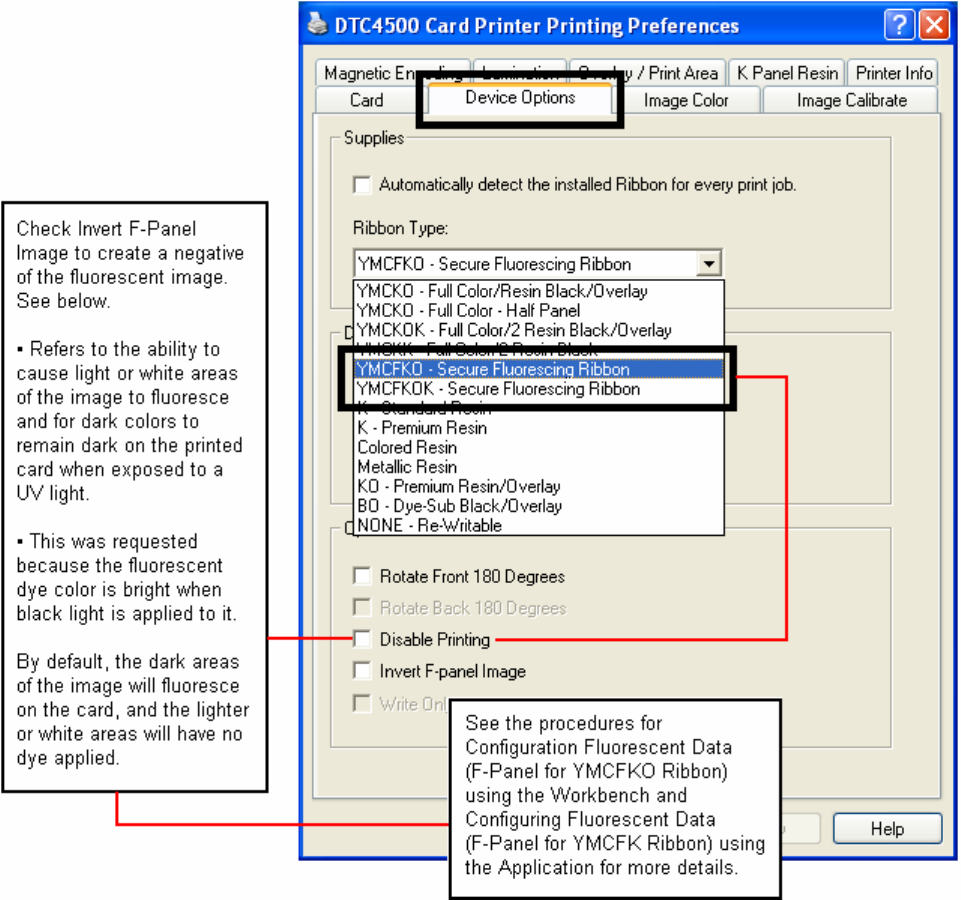
© 2010 HID Global Corporation All rights reserved
Creating a Custom Fluorescent Image (using the YMCFKO Ribbon)
DTC4500 Card Printer/Encoder User Guide 71
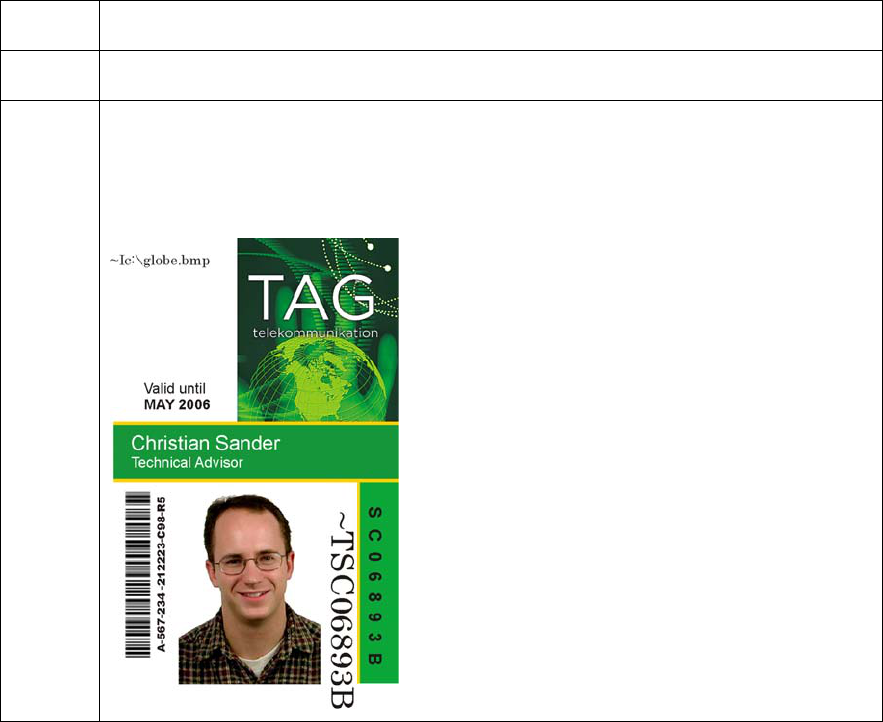
© 2010 HID Global Corporation All rights reserved
Configuring Fluorescent Data (F-Panel for YMCFKO Ribbon) using the
Application
This process creates a fluorescent image on your card using a simple text string command in your badge
application.
Step Procedure
1 Creating Fluorescent Text: Create a new text box in your badge application.
2 Type the TEXT that you want to appear as fluorescent and put a ~T before
the start of the text with no space after the ~T. The text will start on the card
where the ~T begins. (see Display A below)
DTC4500 Card Printer/Encoder User Guide 72
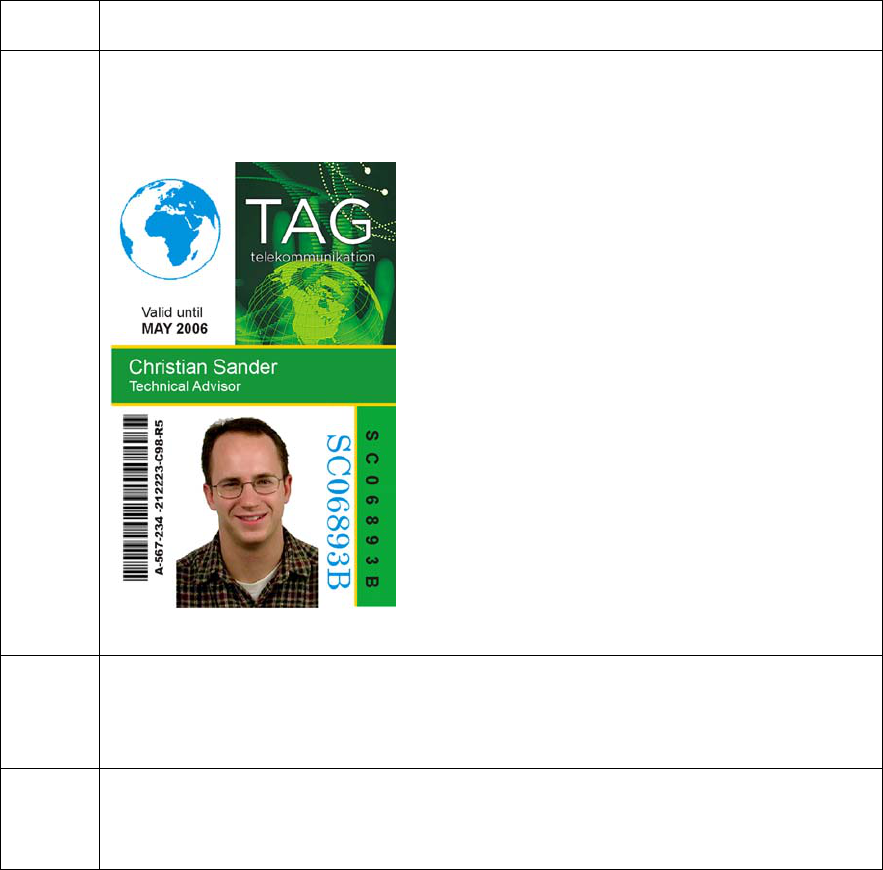
© 2010 HID Global Corporation All rights reserved
Configuring Fluorescent Data (F-Panel for YMCFKO Ribbon) using the Application
Step Procedure
3 Creating a Fluorescent Image: In a separate drawing program, create the
image that you wish to fluoresce. (See Display C below.)
4 Create the IMAGE in the actual size that you want it to appear on the card,
and save it as a Grayscale or 1 - bit bmp file on the root c:\ directory.
• Do not put spaces in the file name.
5 Create a new text box in your badge application, and type ~I followed by the
address of your image (see Display A below). The top left of your image will
start at the top left of your text box.
DTC4500 Card Printer/Encoder User Guide 73

© 2010 HID Global Corporation All rights reserved
Configuring Fluorescent Data (F-Panel for YMCFKO Ribbon) using the Application
Step Procedure
6 Set up the Printer Driver preferences. Refer to Step 8-10 below.
7 Printer will print the fluorescent BMP IMAGE at the ~I position on the card.
Printer will print the fluorescent TEXT at the ~T position on the card. (See
Display B below)
BMP Image located at c:\globe.bmp
8 Set the Ribbon for YMCFKO in the Printing Preferences. (Note: The Detect
Supplies at Print Time button may also be used.)
9 Check Dual Pass if you would like to print the F-Panel on a separate panel of
HDP film from the YMC image.
You should use:
The default Dual Pass option if the fluorescent image is used in places where
other dye is used.
OR
Any time the Invert F-Panel Image option is selected.
DTC4500 Card Printer/Encoder User Guide 74
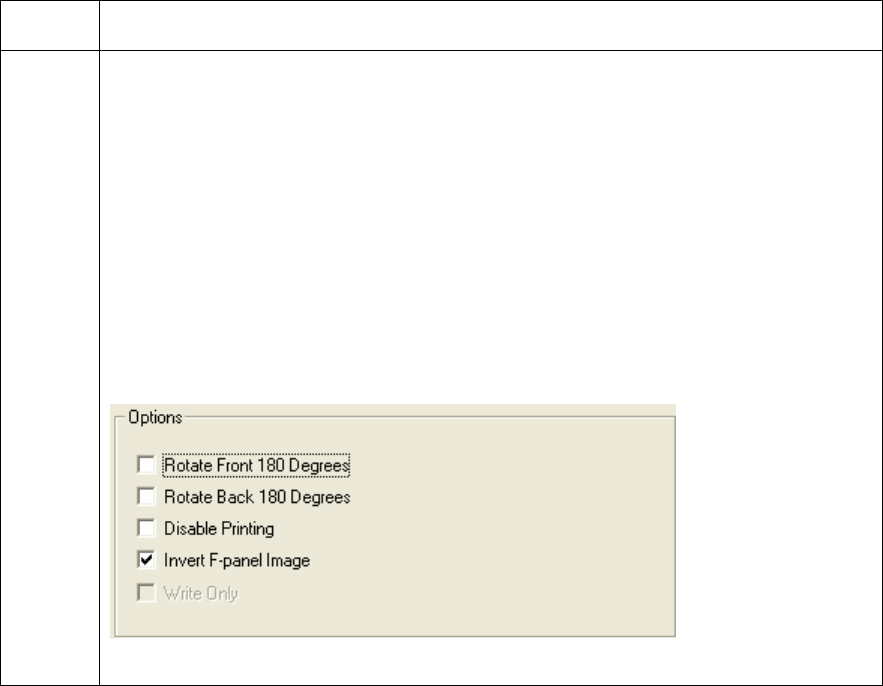
© 2010 HID Global Corporation All rights reserved
Configuring Fluorescent Data (F-Panel for YMCFKO Ribbon) using the Application
Step Procedure
10 Check Invert F-Panel Image to create a negative of the fluorescent image.
See below.
• This refers to the ability to cause light or white areas of the image to
fluoresce and dark colors to remain dark on the printed card when exposed
to a UV light.
• This was requested because the fluorescent dye color is bright when black
light is applied to it.
By default, the dark areas of the image will fluoresce on the card and the
lighter or white areas will have no dye applied. (Note: This may improve the
look of the person’s image if used for the Logo.)
DTC4500 Card Printer/Encoder User Guide 75
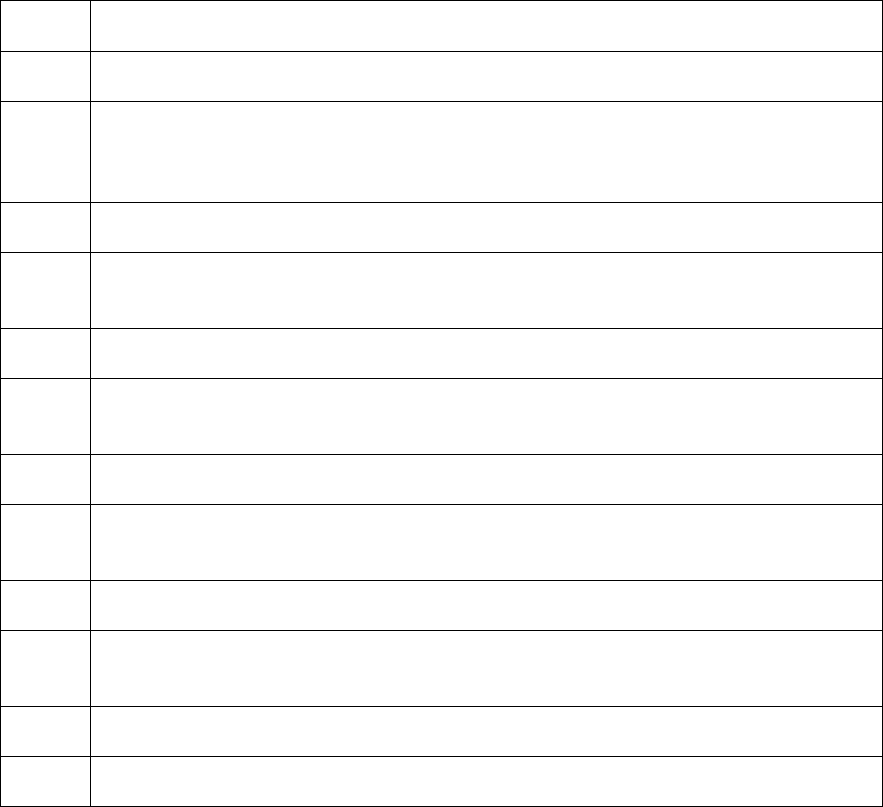
© 2010 HID Global Corporation All rights reserved
Section 6: System Overview- Troubleshooting
Reviewing the DTC4500 Sequence of Operations
Knowing the sequence of the Printer operation will help troubleshoot the printer.
Step Process
1 The File information is received from PC.
2 Printer checks the installed Ribbon type stored in memory against the Ribbon
type command that was sent from the Printer. If Ribbon type does not match,
the Pause button on the right will begin flashing.
3 The Print Stepper Motor engage.
4 The Card Feed Sensor detects leading edge of card, the Headlift Stepper then
engages to disengage the input lever.
5 The card feeds through for the alignment pass.
6 The Card Feed Stepper Motor engages to queue card for magnetic encoding
(if applicable).
7 The Encoding data is written to the card (if applicable).
8 The Magnetic Encoder verifies while the Stepper reverses the card (if
applicable).
9 The Print Ribbon Drive engages (if not already at the yellow Panel).
10 The Print Ribbon Sensor looks for the Yellow Panel. (Note: The Print Ribbon
Encoder detects number of revolutions, required to use an entire color Panel.)
11 The Print Stepper Motor engages.
12 The Card Feed Sensor detects the leading edge of card.
DTC4500 Card Printer/Encoder User Guide 76
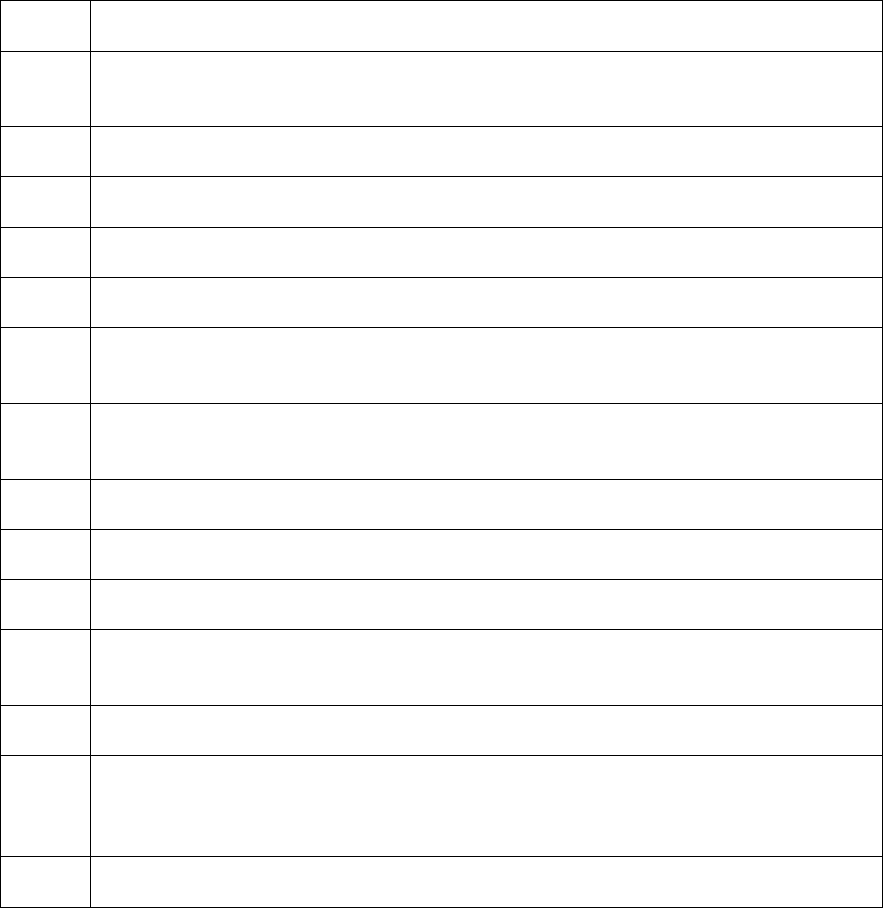
© 2010 HID Global Corporation All rights reserved
Reviewing the DTC4500 Sequence of Operations
Step Process
13 The Print Stepper Motor queues card to the middle of the platen Roller. All
Stop.
14 The Print Headlift Motor engages to the print position.
15 The Print Cover Sensor checks for closed state.
16 The Print Stepper Motor engages.
17 The Ribbon Drive Motor engages.
18 The Image data is burned by the Printhead until the image data is depleted. All
Stop.
19 The Thermistor engages the Printhead Cooling Fan to maintain proper
operating temperature.
20 The Headlift Motor engages to the queue position.
21 The Print Stepper Motor engages.
22 The Print Ribbon Drive engages.
23 After Ribbon advances a few Encoder clicks, assume the Ribbon is free of
card. All stop.
24 Repeat Steps 9 through 22 for the appropriate number of color/overlay Panels.
25 Either the Card is ejected from the singled-sided Printer or the Card Feed
Stepper engages to queue the card for the Flipper Table for the dual-sided
Printer.
26 All Stop.
DTC4500 Card Printer/Encoder User Guide 77
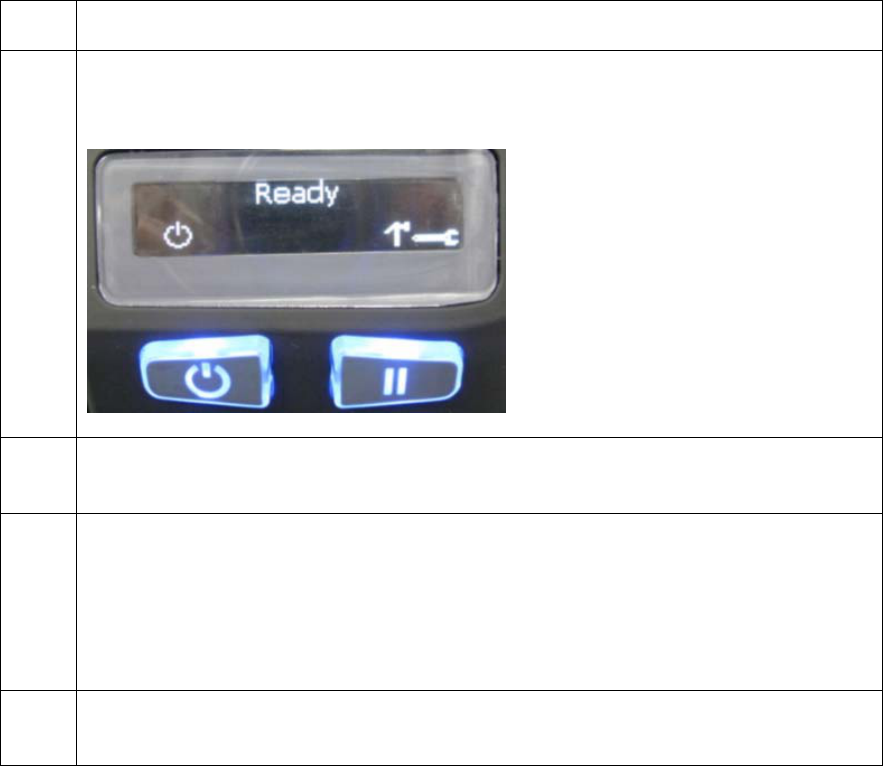
© 2010 HID Global Corporation All rights reserved
Section 7: Troubleshooting
Printer Error Button and Display Message Table
Both the DTC4500 use the Button messages rather than the Display Message system.
Step Procedure
1 All Printers have two (2) buttons, one for ON/Off (LEFT) and one for Pause (II)
(RIGHT).
2 The ON/Off button is blue when the Printer is ON. When the Printer enters the
Sleep Mode, the LED is dimmed but still ON.
3 The Pause (II) button will be illuminated blue when the Printer is capable of
accepting a printjob and does not have an error.
• This LED will continue to stay on while the Printer prints as long as there is
no error.
• This LED will also be dimmed when the Printer goes into sleep mode.
4 When an error occurs, the Pause button will no longer be illuminated blue, but
will blink red.
DTC4500 Card Printer/Encoder User Guide 78
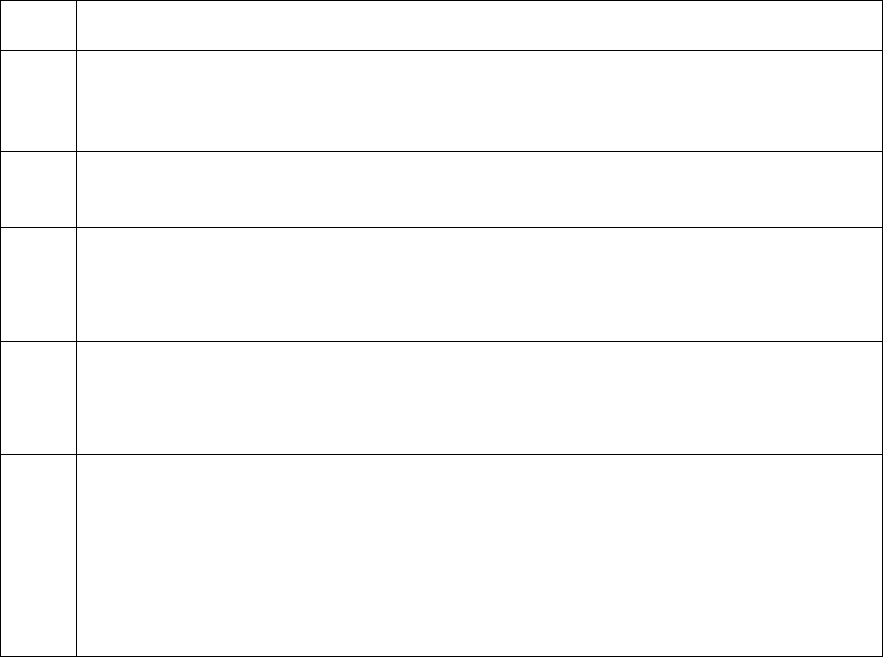
© 2010 HID Global Corporation All rights reserved
Printer Error Button and Display Message Table
Both the DTC4500 use the Button messages rather than the Display Message system.
Step Procedure
5 Press the ON/Off button when Printer is in an error state to cause the action to
be cancelled. (Note: If no other error occurs, then the Pause button will
illuminate its blue LED.)
6 Press the Pause button when Printer is in an error state to cause the Printer to
retry. (Note: It will illuminate its blue LED and retry the failed action.)
7 When downloading an upgrade file, both blue LED’s will blink. If the unit is a
DTC1000:
• You have been advised that the upgrade is in process.
8 If a language (other then English) is currently selected:
• You can press and hold the Pause button during the power-up sequence to
change the language back to English.
9 When no LCD Display is available, press or hold the buttons to access certain
Internal Test jobs. See below.
• To print a card with the Printer Settings, press the Pause button and hold for
4+ seconds when the Printer is ready and idle.
• To print the alignment or the Self Test, press the ON/OFF button then
immediately press the Pause button.
DTC4500 Card Printer/Encoder User Guide 79

© 2010 HID Global Corporation All rights reserved
Using the Error Message Table
This section provides the troubleshooting table for the error message. The DTC4500 has a display that
will show the Printer error messages.
• When an error occurs in the Printer, the PC will show the error message on screen with solutions.
• The display will blink in the location needing attention. Those locations include the Printer, Input
Hopper, Magnetic Encoder, Flipper, Card Path, Ribbon, and Data/Communication error device.
Each table uses a 3- column presentation to present a specific or Printer error message, its cause and its
solution.
• This allows the troubleshooter to identify the error and its cause, and then perform the procedure
(provided in the solution column).
• This standard mode of identifying the problem and its solution should provide an efficient method of
troubleshooting this Printer.
• If you encounter problems beyond the capabilities of these the error message table, you should
contact Technical Support. Refer to: Section 10: HID Global Technical Support
DTC4500 Card Printer/Encoder User Guide 80
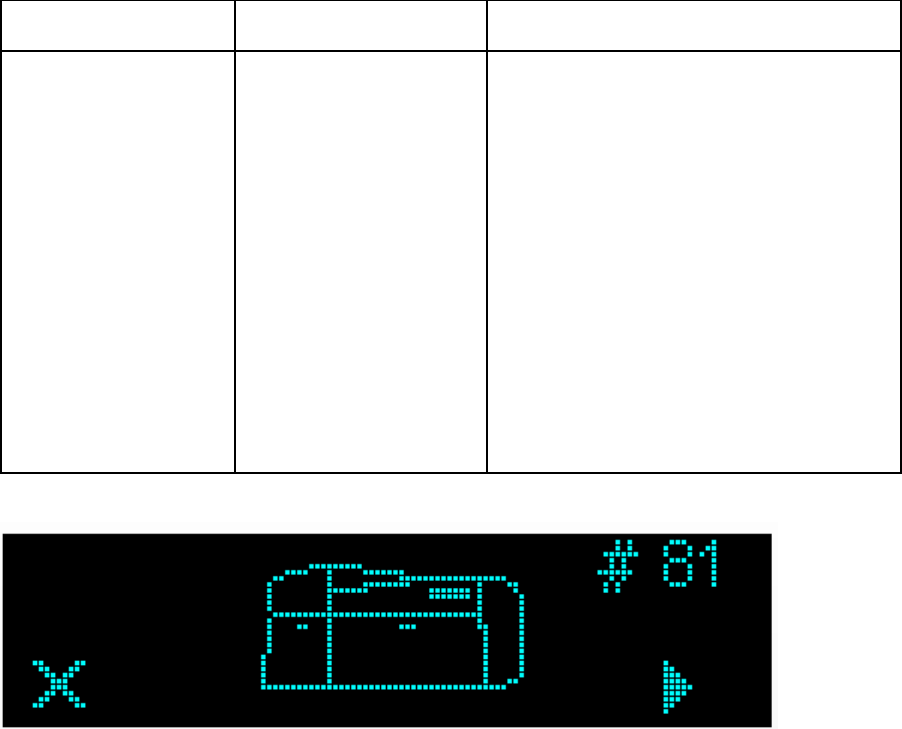
© 2010 HID Global Corporation All rights reserved
Using the Error Message Table
Error Message Cause Solution
# 81
Unable to Feed
The Printer is unable to
feed a card from the
Card Hopper.
Check the following, then press the
Pause button to continue.
• Verify the card thickness setting is
set to the thickness of your cards.
• Verify the Cleaning roller is properly
installed on the Ribbon Cartridge.
• Check for card slippage. If
necessary, run the Printer cleaning
routine.
• Verify that your cards are within the
perimeters accepted card size range.
• Verify the cards are not sticking
together.
DTC4500 Card Printer/Encoder User Guide 81
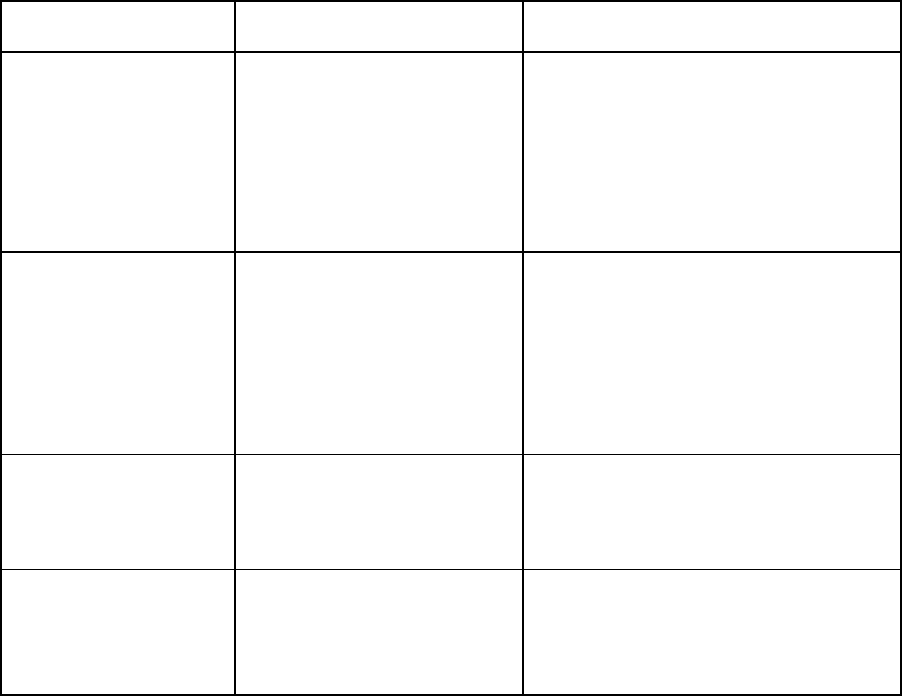
© 2010 HID Global Corporation All rights reserved
Troubleshooting with the Error Message Table
Error Message Cause Solution
# 2
Head Move Error
# 3
Headlift Error
|contextid=201
This is a problem with the
Printhead Lift. Reset the Printer and try again.
• If this problem persists, call for
technical assistance.
# 8
Head Sensor Error
|contextid=200
The Printhead
Temperature Sensor is not
functioning or is not
connected properly.
OR
The Printhead is not
cooling properly.
Reset the Printer and try again.
• If the problem persists, call for
technical assistance.
# 9
Reboot Required
Unspecified system error
detected by the Printer
Firmware.
Reset the Printer and try again.
• If this problem persists, call for
technical assistance.
# 25
Ribbon not Installed
|contextid=232
A Ribbon is not installed in
the Printer.
Install a Ribbon and retry.
DTC4500 Card Printer/Encoder User Guide 82
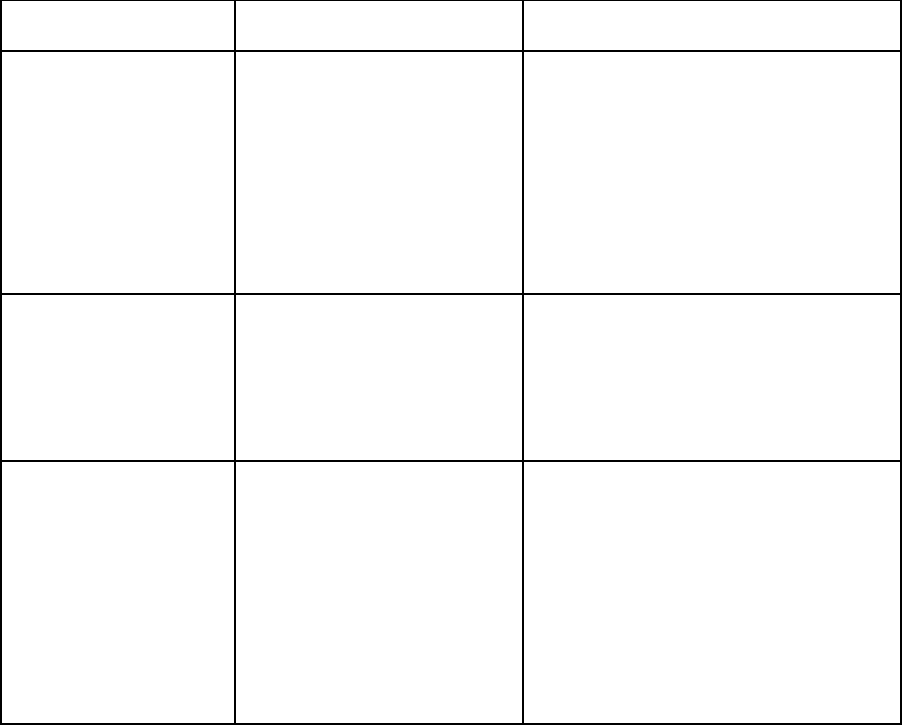
© 2010 HID Global Corporation All rights reserved
Troubleshooting with the Error Message Table
Error Message Cause Solution
# 30
Mag Verify Error
|contextid=251
|contextid=252
Magnetic encoding
verification failure.
• Try encoding with a different
card.
• Verify cards have the Magnetic
Stripe.
• Replace the Magnetic Encoding
Module.
# 31
No Mag Module
|contextid=250
You are trying to send
encoding data, but the
Printer is not configured
with this Encoder type.
• Ensure that no encoding data is
being sent with the print job and
reprint the card.
• Install a Magnetic Encoding
Module.
# 38
# 39
# 40
EEPROM Corrupt
EEPROM Read
Error
EEPROM restored with
factory default values. If changes were made in the
Advanced Setting Tab in the Printer
Driver, click the Default button to
reset these numbers.
• Reset the Printer and try again. If
this problem persists, call for
technical assistance.
DTC4500 Card Printer/Encoder User Guide 83
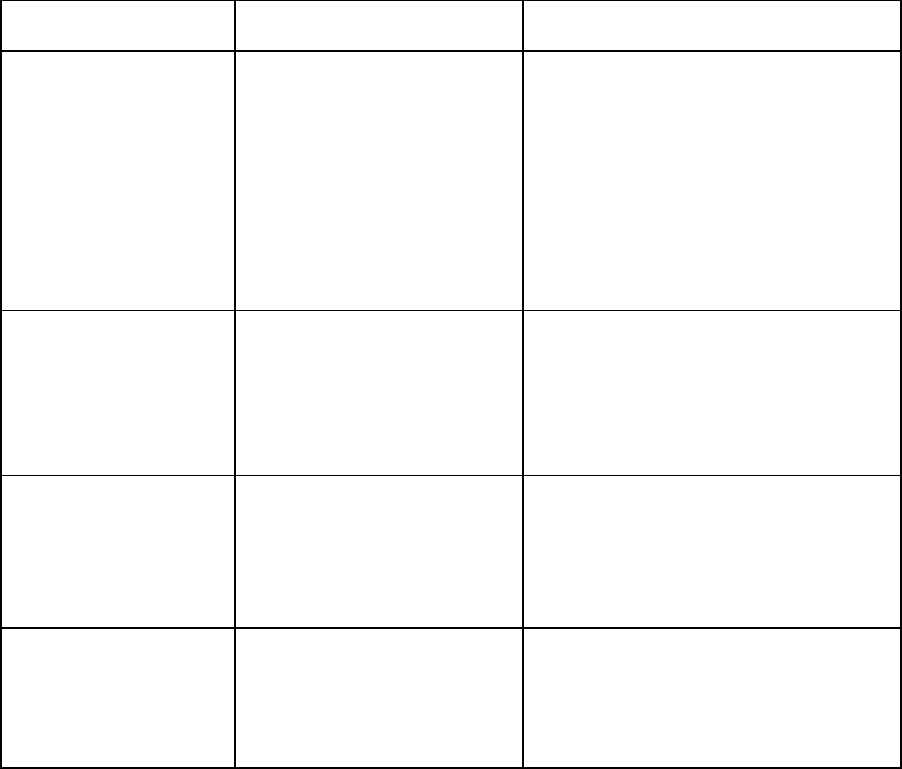
© 2010 HID Global Corporation All rights reserved
Troubleshooting with the Error Message Table
Error Message Cause Solution
# 44
Flipper Jam/ Home
Error
|contextid=220
A card has become
jammed in the Printer’s
Flipper Table.
The Flipper failed to
position properly while
aligning a card or flipping a
card.
Clear any cards in the Flipper Table
using the buttons to move the card
out. Resume printing.
• Reset the Printer and retry. If
problem persists call for technical
assistance.
# 45
No Flip Module
|contextid=221
Request to print on 2nd side
of card, but no Flipper is
installed.
If a Flipper Module is present,
ensure that the Print Both Sides
option in the Printer Driver is set
correctly.
• Install a Flipper module.
# 48
Check Lam Power
|contextid=281
Lam is connected but not
powered.
Power off the Printer, power the
Laminator, and then power on the
Printer. A damaged Flipper board,
E-Card board, or EEPROM could
potentially result in this same error.
# 52
Lam Generic Error
|contextid=280
Laminator firmware error
Cycle power and try again.
• If this problem persists call for
technical assistance.
DTC4500 Card Printer/Encoder User Guide 84
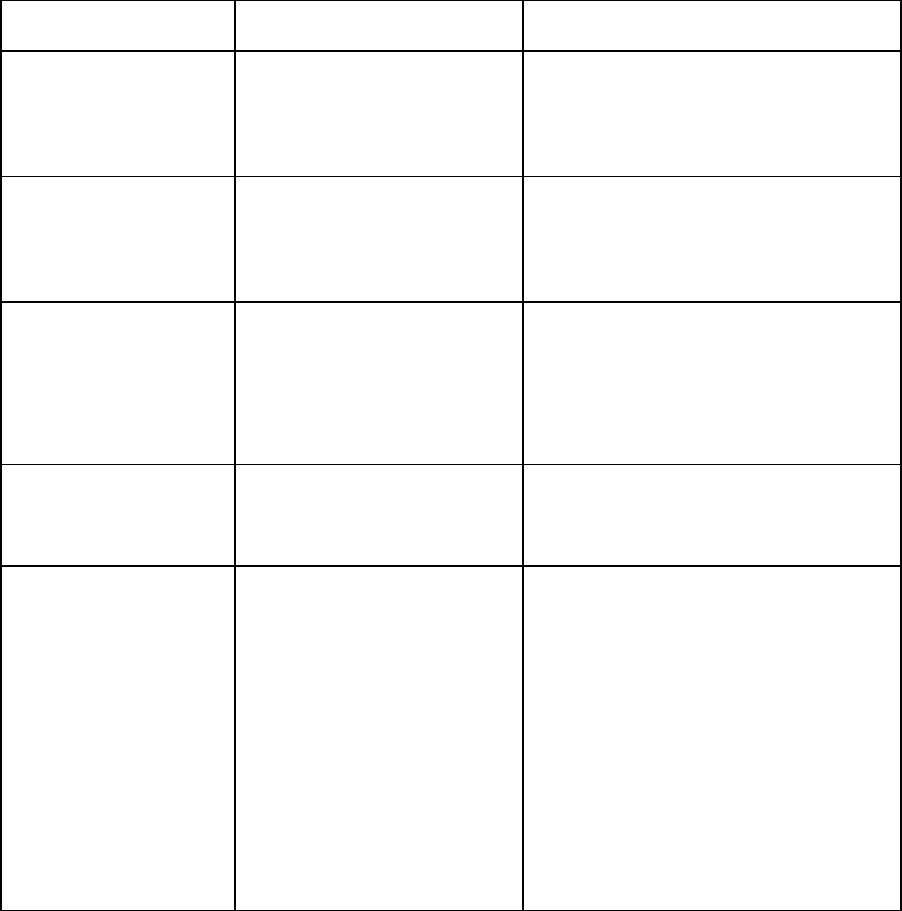
© 2010 HID Global Corporation All rights reserved
Troubleshooting with the Error Message Table
Error Message Cause Solution
# 53
Lam Card Jam
A jam occurred
somewhere between the
Printer and the laminator
Open covers and clear the
obstruction/jam
# 63
Lam Tag Error
|contextid=286
There is no material
loaded in the laminator Load material into the Laminator
# 64
# 65
# 66
Reboot Required
Unspecified system error
detected by the Printer
Firmware.
Reset the Printer and try again.
• If this problem persists, call for
technical assistance.
# 68
Card in Printer
A card is jammed in the
Print Station or card
flipping area of the Printer.
Clear the jam and press the the
Pause button.
# 70
Multiple Feed
|contextid=211
Multiple cards were fed
into the Printer. Verify the card thickness is set to
the thickness of your cards, then
press the Pause button.
• Check for card slippage. If
necessary, run the Printer
cleaning routine
• Verify the Cleaning roller is
properly installed on the Ribbon
Cartridge.
• Verify the cards are not sticking
together.
DTC4500 Card Printer/Encoder User Guide 85

© 2010 HID Global Corporation All rights reserved
Troubleshooting with the Error Message Table
Error Message Cause Solution
# 81
Unable to Feed
|contextid=214
|contextid=210
The Printer is unable to
feed a card from the Card
Hopper.
Check the following, then press the
Pause button to continue.
• Verify the card thickness setting
is set to the thickness of your
cards.
• Verify the Cleaning roller is
properly installed on the Ribbon
Cartridge.
• Check for card slippage. If
necessary, run the Printer
cleaning routine.
• Verify that your cards are within
the perimeters accepted card
size range.
Verify the cards are not sticking
together.
# 82
Mag Jam
|contextid=216
A card is jammed Magnetic
station
• Clear any cards in the Magnetic
station using the buttons to move
the card out.
• Press the Pause button to
continue.
DTC4500 Card Printer/Encoder User Guide 86
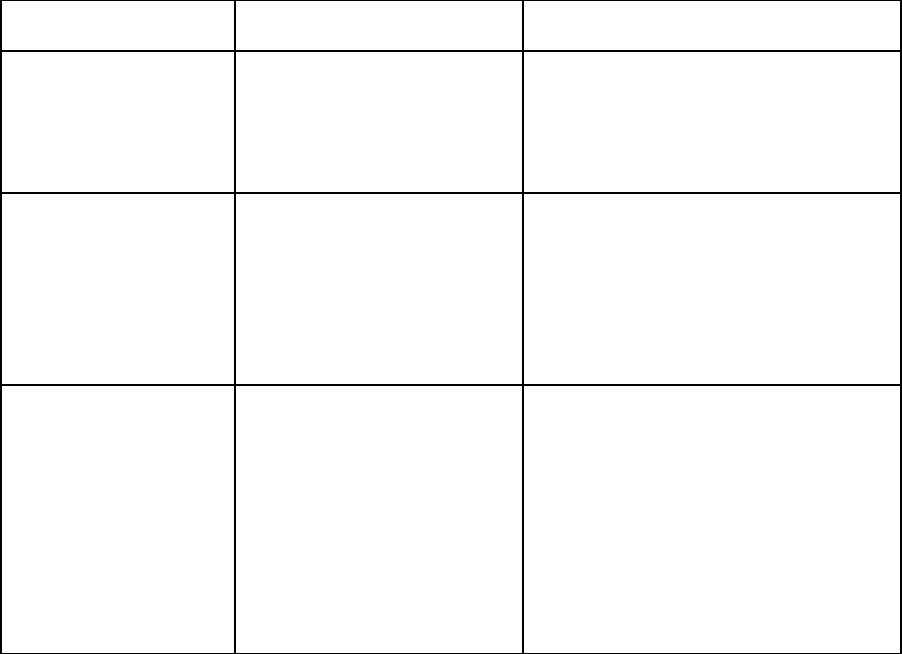
© 2010 HID Global Corporation All rights reserved
Troubleshooting with the Error Message Table
Error Message Cause Solution
# 91
Ribbon Out
|contextid=233
The Print Ribbon has run
out.
• Install a new Ribbon.
• Press the Pause button to
continue or the ON/OFF button to
cancel.
# 93
Wrong Ribbon
|contextid=231
The Print Ribbon installed
in the Printer does not
match the Ribbon type
selected in the Printer
Driver.
• Change either the installed Print
Ribbon or the Ribbon type
selected in the Printer Driver.
• Press the Pause button to
continue or the ON/OFF button to
cancel .
# 97
Ribbon Search
Error
|contextid=239
The Ribbon is not able to
find the next panel
correctly.
Check for jams/breaks.
Recalibrate the Ribbon Sensor.
• If broken, repair by taping the
Ribbon back on to the take- up
core.
• Replace the Ribbon.
• Press the Pause button to
continue or the ON/OFF button to
cancel.
DTC4500 Card Printer/Encoder User Guide 87
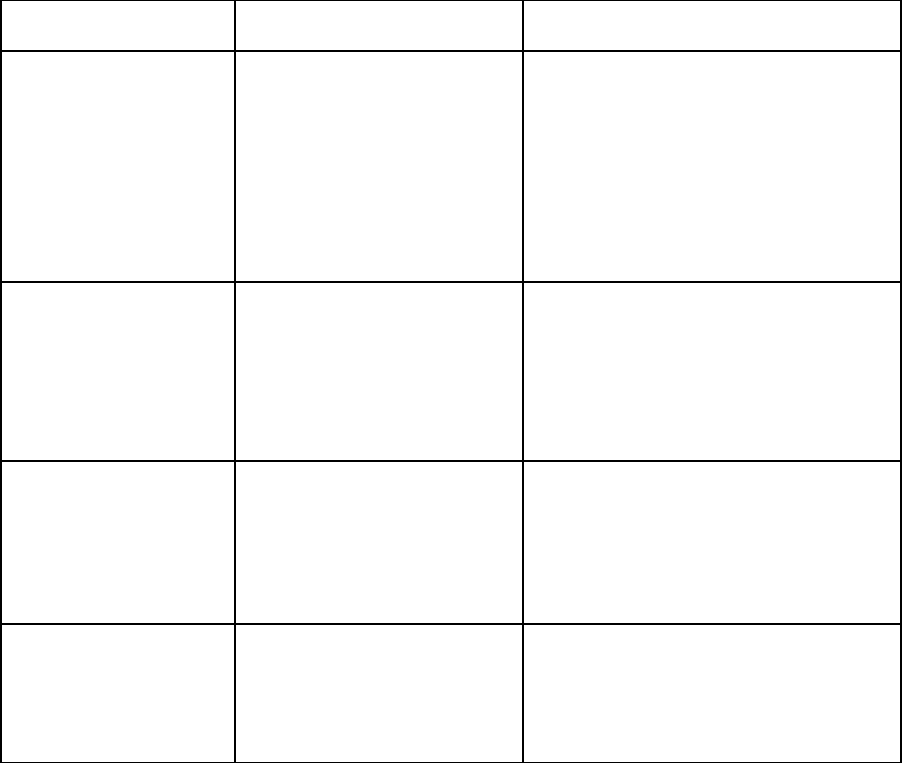
© 2010 HID Global Corporation All rights reserved
Troubleshooting with the Error Message Table
Error Message Cause Solution
# 99
Ribbon Error
|contextid=234
The Print Ribbon has
either broken or jammed.
• If jammed, clear the jam.
• If broken, repair by taping the
Ribbon back on to the take- up
core.
• Press the Pause button to
continue or the ON/OFF button to
cancel.
# 100
Ribbon RFID Error
|contextid=230
There is no Ribbon or the
Ribbon tag information is
corrupted or incorrect.
Verify the Printer Driver settings for
correct Ribbon.
• Try a new Ribbon and continue.
• Press the ON/OFF button to
cancel.
# 102
# 103
# 104
Headlift Error
This is a problem with the
Printhead Lift. Reset the Printer and try again.
• If this problem persists, call for
technical assistance.
# 106
Job Data Error
The print data sent to the
Printer is corrupt or has
been interrupted.
Check the interface cable.
Select the ON/OFF button to cancel
this print job and then resend the
job.
DTC4500 Card Printer/Encoder User Guide 88
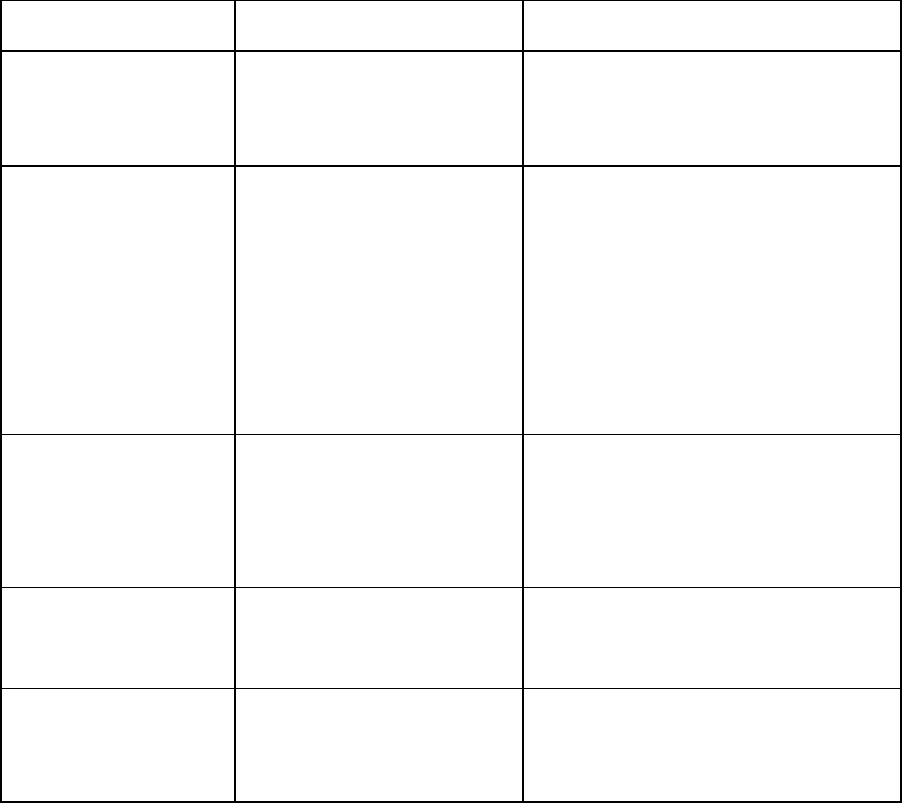
© 2010 HID Global Corporation All rights reserved
Troubleshooting with the Error Message Table
Error Message Cause Solution
# 107
Printing Error
An error was detected
during printing. Reset the Printer and try again.
• If this problem persists, call for
technical assistance.
# 109
Ribbon Release
Error
The Printer cannot locate
the next Ribbon panel in
order to release the
Ribbon from the card.
Ensure that the Ribbon is not stuck
to the card.
• Replace the Ribbon.
• Recalibrate the Ribbon sensor.
• If the Ribbon is broken, repair by
taping the Ribbon back onto the
take- up core and manually
advance to the next panel.
# 110
Card Jam/Align
error
A card is jammed in the
Print Station or card
flipping area of the Printer.
Clear the jam. Press the Pause
button to continue.
# 111
Head Loading
An unrecoverable error
has occurred during
printing.
Reset the Printer and try again. If
this problem persists, call for
technical assistance.
# 112
Card Jam/Align
error
A card is jammed in the
Print Station or card
flipping area of the Printer.
Clear the jam. Press the Pause
button to continue.
DTC4500 Card Printer/Encoder User Guide 89
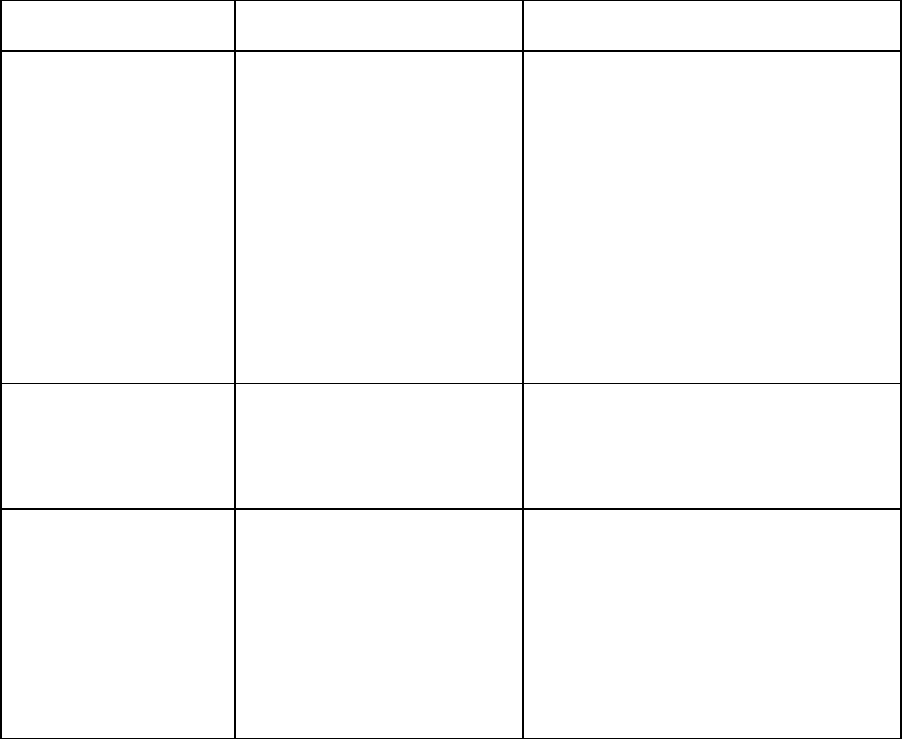
© 2010 HID Global Corporation All rights reserved
Troubleshooting with the Error Message Table
Error Message Cause Solution
# 113
Ribbon Release
Error
|contextid=300
The Printer cannot locate
the next Ribbon panel in
order to release the
Ribbon from the card.
Ensure that the Ribbon is not stuck
to the card.
• Replace the Ribbon.
• Recalibrate the Ribbon sensor.
• If the Ribbon is broken, repair by
taping the Ribbon back onto the
take- up core and manually
advance to the next panel.
• Press the Pause button to
continue.
# 128
Calibrate Ribbon
|contextid=235
The Print Ribbon Sensor is
out of calibration. Calibrate the Ribbon Sensor.
# 131
Flipper Jam/ Home
Error
A card has become
jammed in the Printer’s
Flipper Table.
The Flipper failed to
position properly while
aligning a card or flipping a
card.
Clear any cards in the Flipper Table,
using the buttons to move the card
out.
• Resume printing.
• Reset the Printer and retry. If
problem persists call for technical
assistance.
DTC4500 Card Printer/Encoder User Guide 90
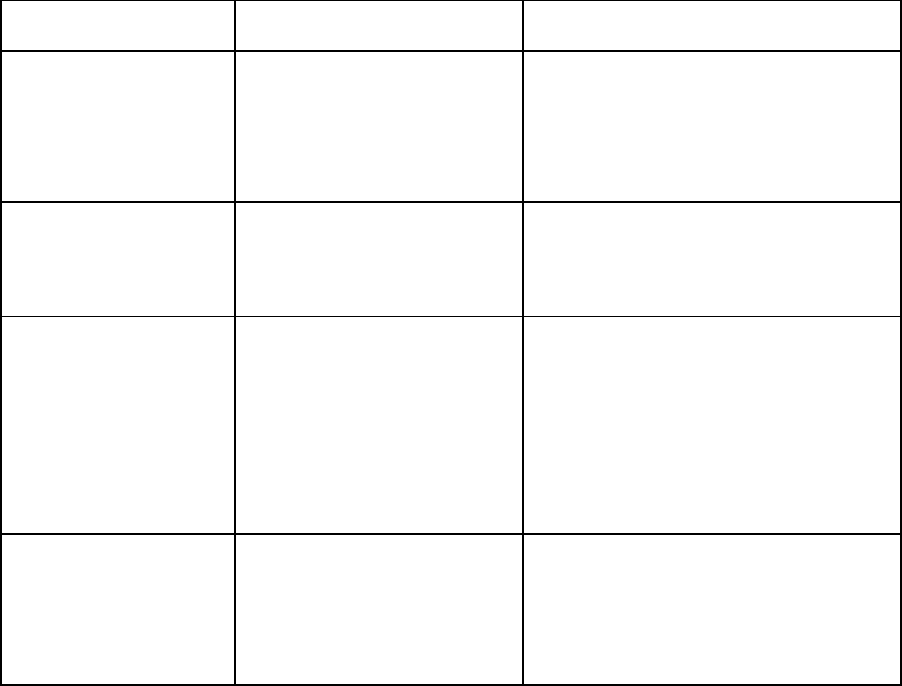
© 2010 HID Global Corporation All rights reserved
Troubleshooting with the Error Message Table
Error Message Cause Solution
# 136
Secure Guard Print
Disabled
|contextid=203
Printing is disabled by
SecureGuard until a
password is received.
Reset the Printer and retry.
• If the problem persists, call for
technical assistance.
# 139
Please Remove
Ribbon
Ribbon needs to be
removed. Reset the Printer and retry.
• If problem persists, call for
technical assistance.
# 144
EEPROM Corrupt
EEPROM Read
Error
EEPROM restored with
factory default values.
• If changes were made in the
Advanced Setting Tab in the
Printer Driver, click the Default
button to reset these numbers.
• Reset the Printer and try again. If
this problem persists, call for
technical assistance.
# 170
Ribbon Calibration
failed
Ribbon calibration failed.
Check for material blocking sensor
and try again.
DTC4500 Card Printer/Encoder User Guide 91
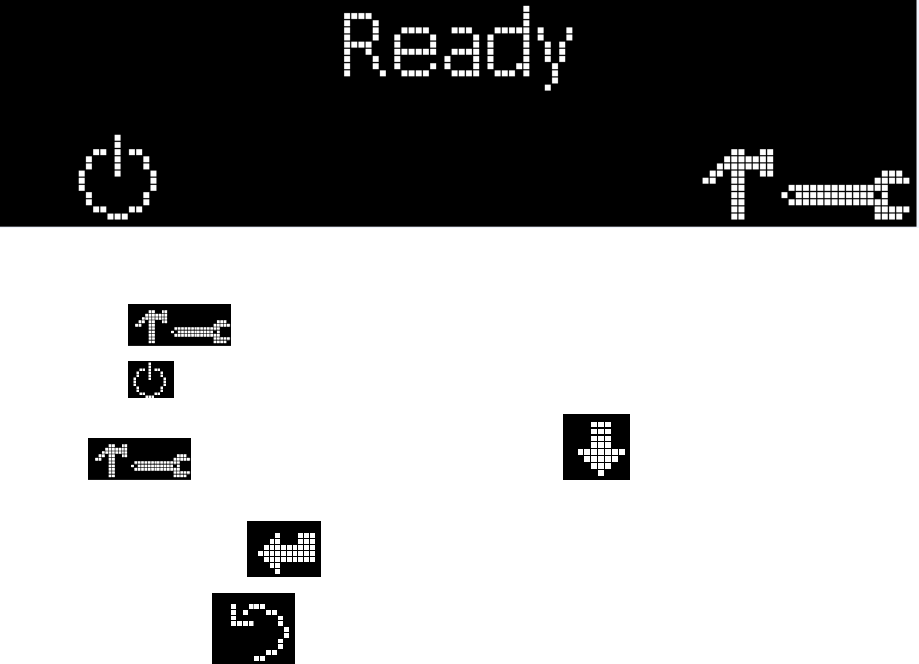
© 2010 HID Global Corporation All rights reserved
Printer Specific Tools (DTC4500)
Here is a description of these tools.
• Press the button to scroll through the details of the Printer and perform the action.
• Press the button to select the option.
• Once is selected, use the left down arrow to scroll through the Info, Test Prints,
and Languages and Exit.
• Use the corner arrow to run that option.
• The curved arrow will return to the first screen.
DTC4500 Card Printer/Encoder User Guide 92
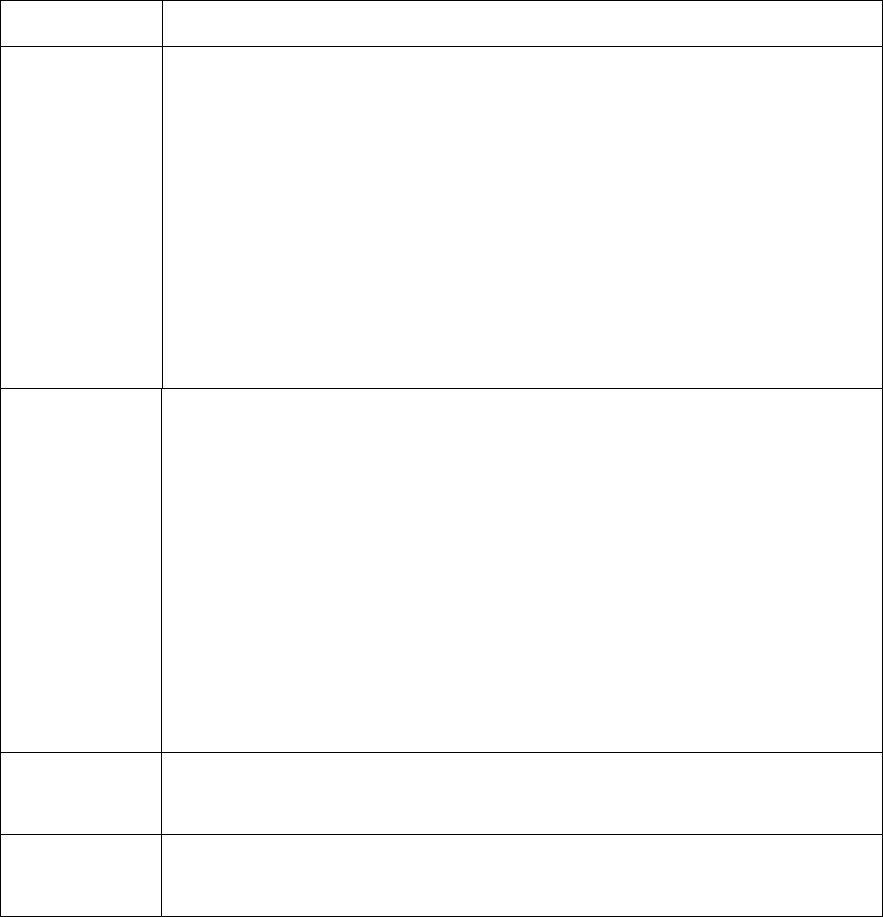
© 2010 HID Global Corporation All rights reserved
Additional Printer Specific Tools (DTC4500)
Label Description
INFO • Printer Type
• Firmware Version
• I.P Address
• Flipper
• Lamination
• Magnetics
• E-Card
• Password
• Card count
TEST
PRINTS Color Photo:
Select this to print a color card to test communication and integrity.
Alignment:
Select this to print a card used to align the print image on the card.
Settings:
Select this to print a card with the Advanced settings.
Resin:
Select this to print a RESIN test card.
Rewritable:
Select this to ERASE the Rewritable card.
Language Language:
Select this choice to change the Printer Displayed Language.
Exit Exit:
Select this choice to exit the Printer Tool options.
DTC4500 Card Printer/Encoder User Guide 93
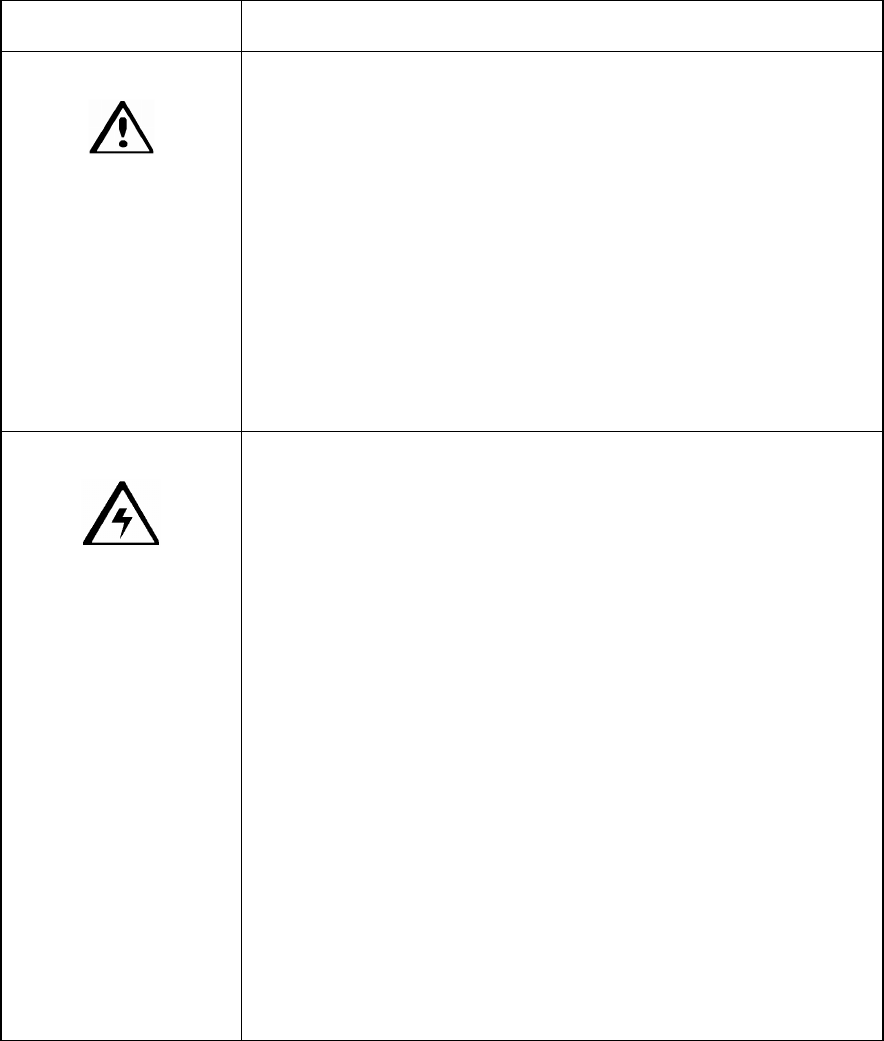
© 2010 HID Global Corporation All rights reserved
Section 8: Cleaning
The Card Printer is built to require a minimum amount of maintenance. Nevertheless, there are a few
procedures you can perform on a regular basis or as needed to ensure the best possible performance
Safety Messages (review carefully)
Symbol Critical Instructions for Safety purposes
Danger:
Failure to follow these installation guidelines can result in
death or serious injury.
Information that raises potential safety issues is indicated by a
warning symbol (as shown to the left).
• To prevent personal injury, refer to the following safety
messages before performing an operation preceded by this
symbol.
• To prevent personal injury, always remove the power
cord prior to performing repair procedures, unless otherwise
specified.
• To prevent personal injury, make sure only qualified
personnel perform these procedures.
Caution:
This device is electrostatically sensitive. It may be
damaged if exposed to static electricity discharges.
Information that raises potential electrostatic safety issues is
indicated by a warning symbol (as shown to the left).
• To prevent equipment or media damage, refer to the
following safety messages before performing an operation
preceded by this symbol.
• To prevent equipment or media damage, observe all
established Electrostatic Discharge (ESD) procedures while
handling cables in or near the Circuit Board and Printhead
Assemblies.
• To prevent equipment or media damage, always wear an
appropriate personal grounding device (e.g., a high quality
wrist strap grounded to avoid potential damage).
• To prevent equipment or media damage, always remove
the Ribbon and Cards from the Printer before making any
repairs, unless otherwise specified.
• To prevent equipment or media damage, take jewelry off
of fingers and hands, as well as thoroughly clean hands to
remove oil and debris before working on the Printer.
DTC4500 Card Printer/Encoder User Guide 94
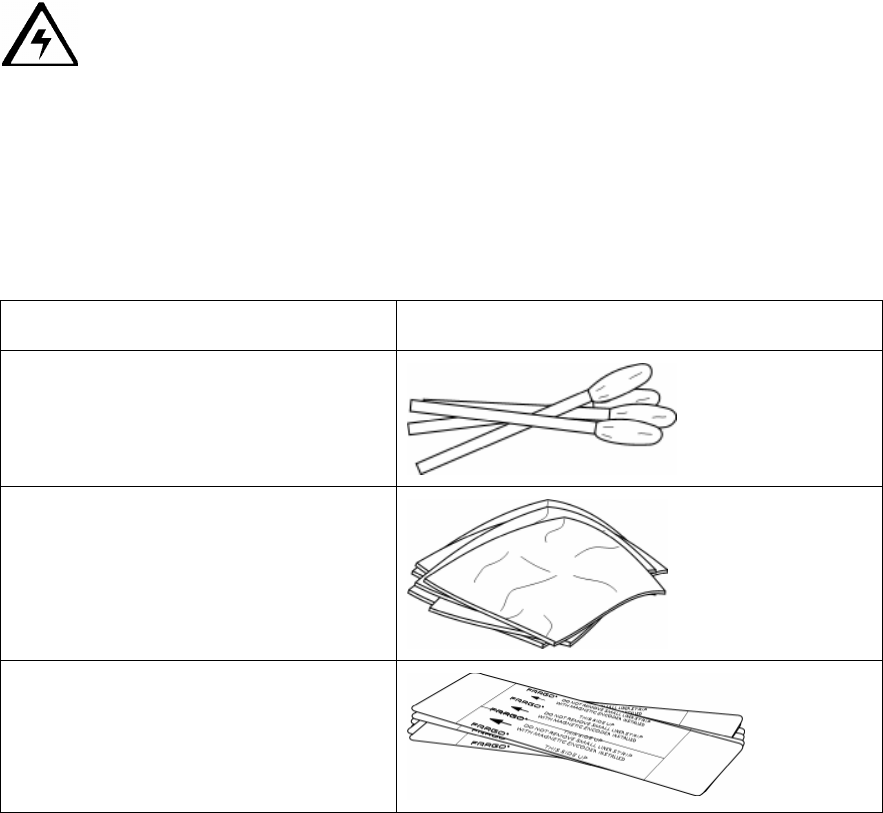
© 2010 HID Global Corporation All rights reserved
DTC4500 Card Printer/Encoder Cleaning Kit
Caution: As with any electronic device, internal components of the Printer, such as the
Printhead, may be damaged if exposed to static electrical discharges. To avoid potential damage, always
wear an appropriate personal grounding device, such as a wrist strap (with integral resistor) connected to
an ESD ground.
Supplies (included with the Cleaning Kit)
This Cleaning Kit provides you with the specialized cleaning supplies and the required cleaning
procedures for you to maintain your Fargo DTC4500 Card Printer/Encoder. The following cleaning
procedures will require less than ten minutes.
Description Supplies (pictured)
Four (4) Printhead Cleaning Swabs
are pre-moistened with 99.99%
isopropyl alcohol for cleaning your
Printer’s Printhead.
Ten (10) Gauze Pads are pre-
moistened with 99.99% isopropyl
alcohol for cleaning your Printer’s
interior and exterior.
Ten (10) Cleaning Cards are
provided with adhesive backing for
cleaning your Printer’s Platen and
Card Feed Rollers.
DTC4500 Card Printer/Encoder User Guide 95
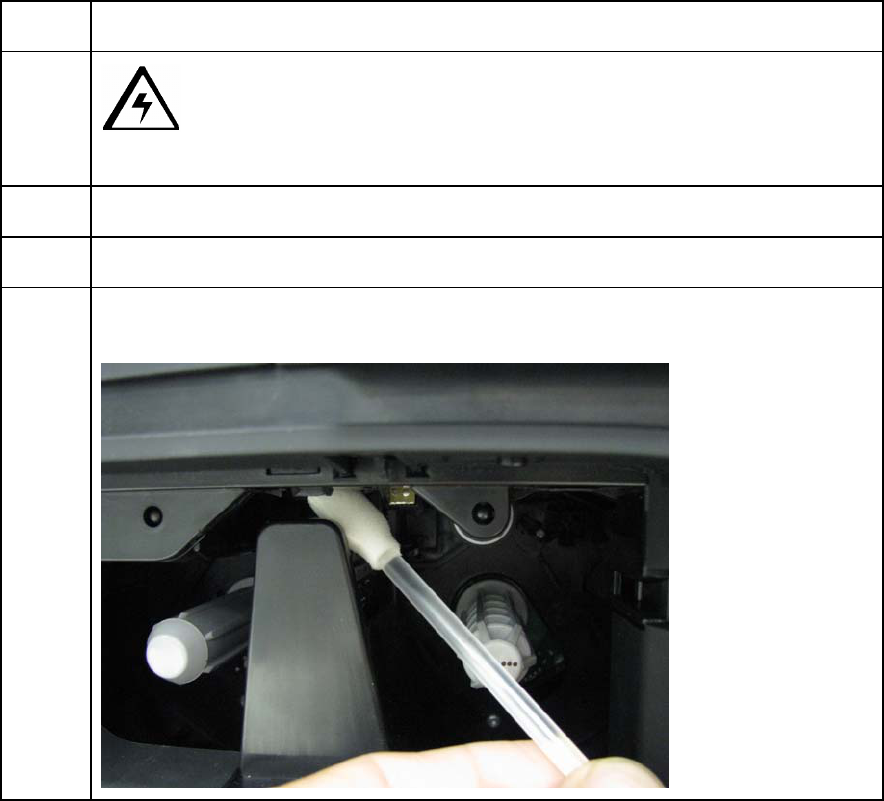
© 2010 HID Global Corporation All rights reserved
Printhead Cleaning
Step Procedure
1
Caution:
Turn Off the Printer and unplug the power cord from the Printer.
2 Remove the Ribbon Cartridge.
3 Open the Printhead Cleaning Swabs. Break it to moisten the tip.
4 Swab the tip back and forth across the top of the Printhead. Allow to dry
thoroughly before sending a print job.
DTC4500 Card Printer/Encoder User Guide 96
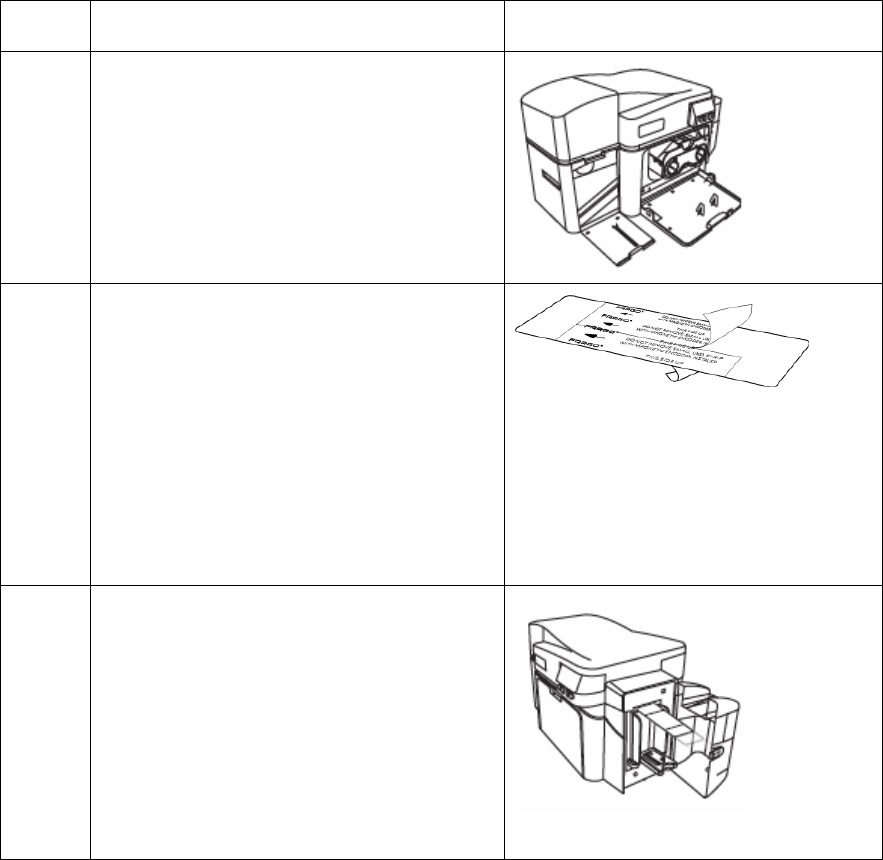
© 2010 HID Global Corporation All rights reserved
Cleaning the Platen and the Card Feed Rollers
Perform this procedure approximately every 1000 prints to maintain a consistent print quality. (Note:
The Card Feed Rollers move the card throughout the print process. Rollers should be kept clean to
prevent card jams and card contamination. This cleaning process will ultimately lead to better print
quality and extended Printhead life.)
Step Procedure Picture
1 a. Open the Printer’s Front Cover and
remove the Print Ribbon.
b. Remove all the cards from the
Printer’s Input Hopper.
2 Use the Cleaning Card from the
Printer’s and remove the adhesive
backing from both sides of the card.
If your Printer has a Magnetic Encoder
installed, be sure to leave the small
Liner Strip on top of the Cleaning Card
in place.
This small strip is needed to protect the
Magnetic Head from the adhesives on
the Cleaning Card.
3 Insert the Cleaning Card into the
Single Feed Card Slot until the card
stops.
If your Printer is equipped with a
Magnetic Encoder, you must insert the
Cleaning Card with the printed side up
and with the small Liner Strip towards
the front of the Printer.
DTC4500 Card Printer/Encoder User Guide 97
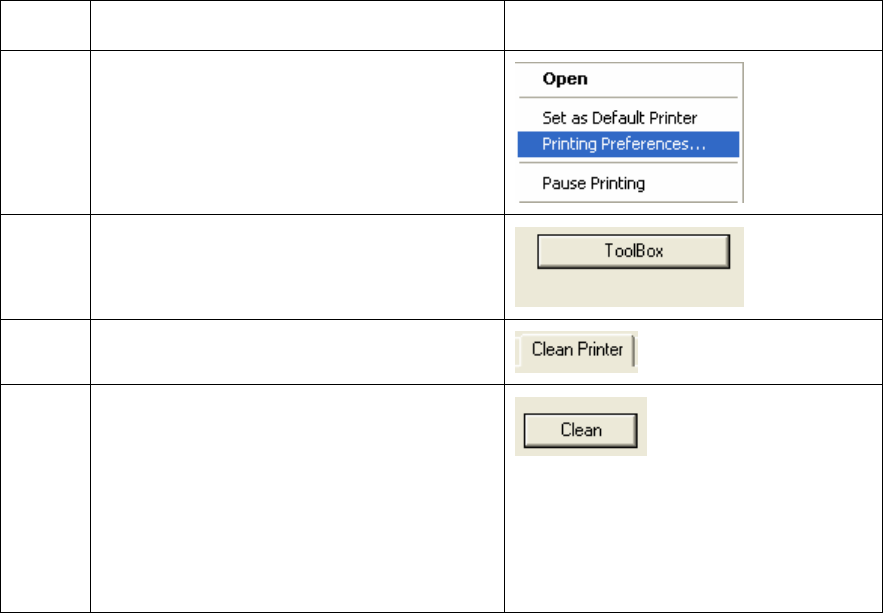
© 2010 HID Global Corporation All rights reserved
Cleaning the Platen and the Card Feed Rollers
Step Procedure Picture
4 From your computer, open the Printer
Driver and select Printing Preferences.
5 Open the Toolbox button.
6 Click on the Clean Printer button.
7 Click on the Clean button.
• The Printer will pull in the Cleaning
Card. The Printer will then perform
an automated cleaning procedure.
• This procedure is designed to
thoroughly clean the Platen and the
Card Feed Rollers inside the Printer.
DTC4500 Card Printer/Encoder User Guide 98
© 2010 HID Global Corporation All rights reserved
Cleaning the Printer’s Interior
Periodically, use a Cleaning Pad from the Printer’s Cleaning Kit to remove dust and other contaminants
from inside the Printer. (Note: Dust and other particles may accumulate inside the Printer with continued
usage. This can cause spots or specks to appear on the printed cards.)
Cleaning the Printer’s Exterior
Clean it only with a Cleaning Pad from the Printer’s Cleaning Kit. (Note: The Printer has a durable
casing that should retain its luster and appearance for many years.
DTC4500 Card Printer/Encoder User Guide 99
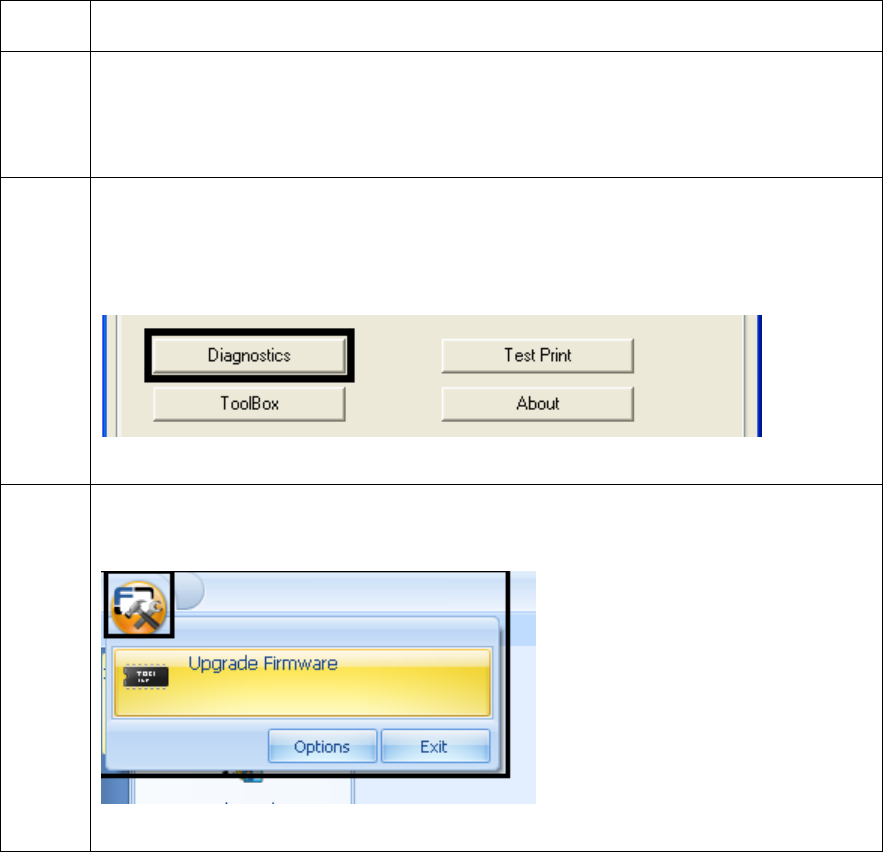
© 2010 HID Global Corporation All rights reserved
Section 9: Firmware Upgrades
Upgrade the Printer Firmware
Step Procedure
1 Requirements
• Internet Access
• Printer is powered up and connected to PC
2 Open the Fargo Workbench Printer Utility and use the Diagnostics button
from the Card Option Printing Preference page. (Note: The Workbench is also
available from the Fargo Folder in the Windows Program folder.)
3 From the Application Icon, select Upgrade Firmware.
DTC4500 Card Printer/Encoder User Guide 100
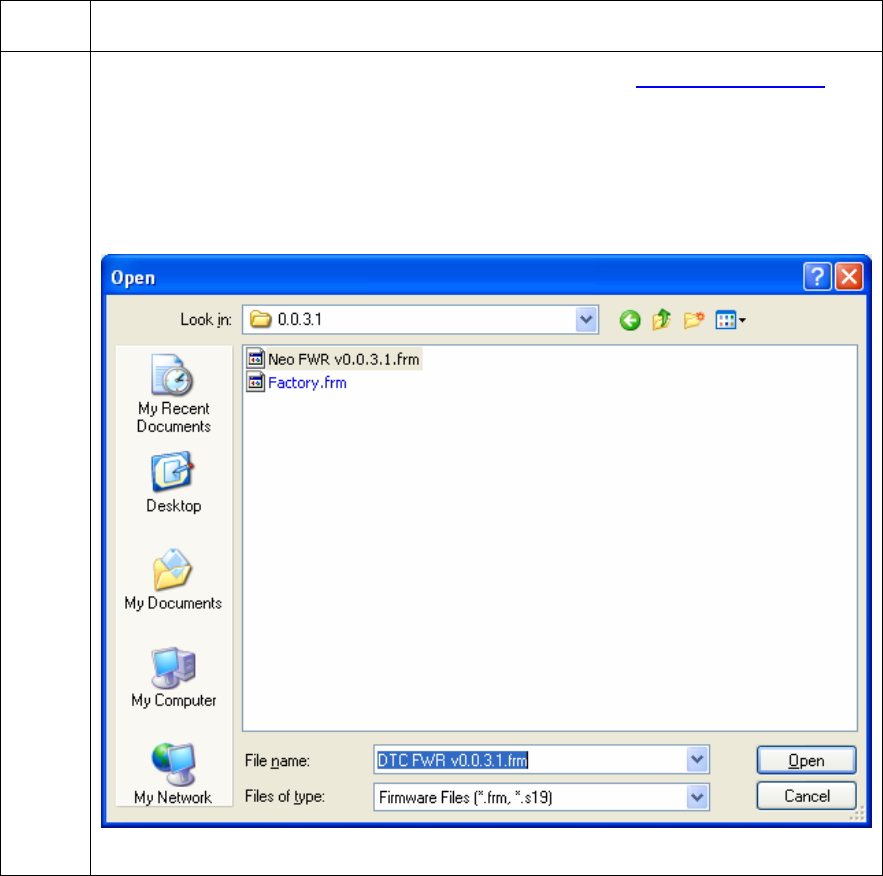
© 2010 HID Global Corporation All rights reserved
Upgrade the Printer Firmware
Step Procedure
4 Find the Firmware via Check for Firmware Updates at www.hidglobal.com
• Save the file to a folder.
• Use the Browse button to find the .frm file.
• Select the file. Click Open.
DTC4500 Card Printer/Encoder User Guide 101
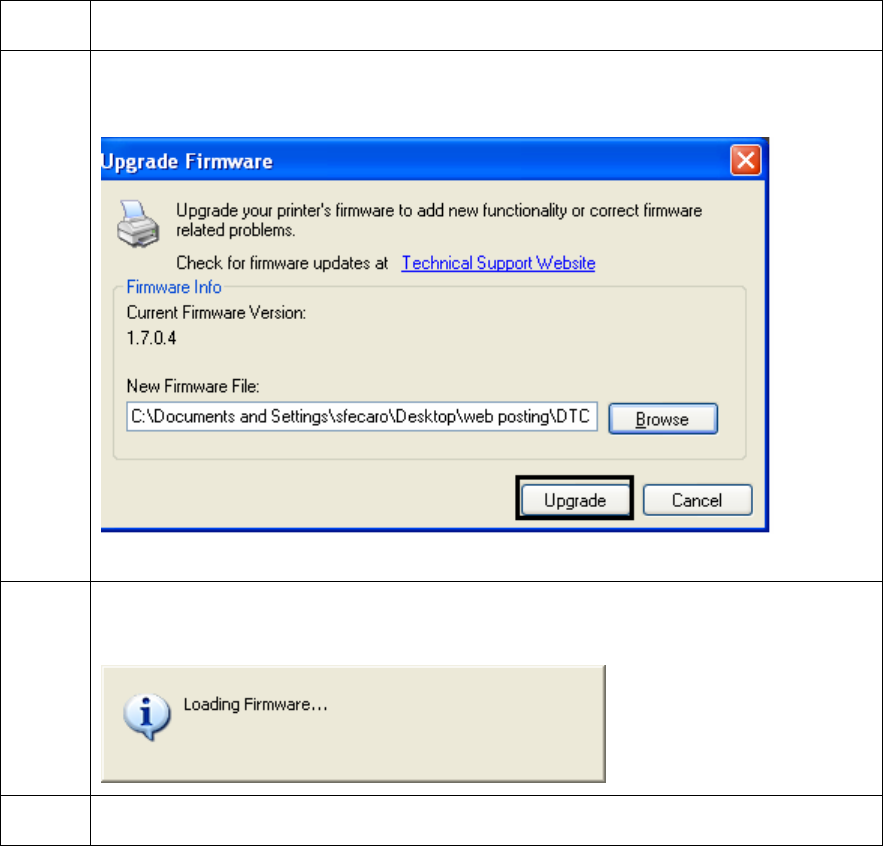
© 2010 HID Global Corporation All rights reserved
Upgrade the Printer Firmware
Step Procedure
5 Click on Upgrade to start the upgrade process.
6 This message will appear while Firmware is updating.
7 The Printer will reboot after this process is completed.
DTC4500 Card Printer/Encoder User Guide 102
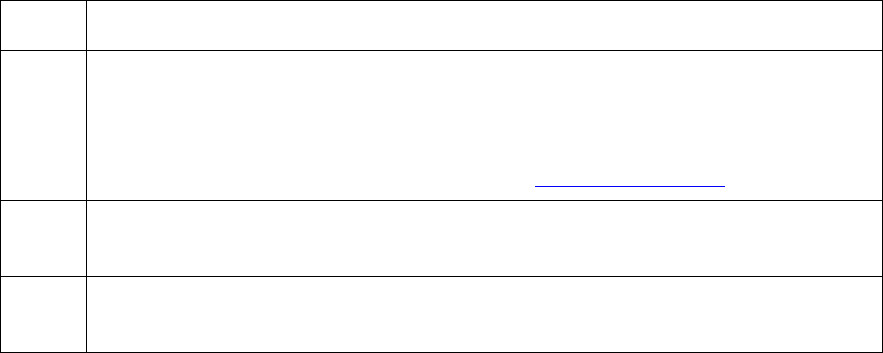
© 2010 HID Global Corporation All rights reserved
Section 10: HID Global Technical Support
The purpose of this section to provide you with an efficient, step-by-step procedure to be used when
contacting HID GLOBAL Technical Support as needed for this Card Printer.
Step Procedure
1 Contact the HIDGlobal Technical Support Group by phone at (866)607-7339
Ext #6 or by fax at (952) 946-8492 for additional technical assistance.
OR
Contact HID Technical Support via the Web: www.hidglobal.com
2 Position a phone near the Printer and Computer so the technician can help to
troubleshoot the Printer(s).
3 Please have a self-test and a sample card ready when calling HID Technical
Support.
DTC4500 Card Printer/Encoder User Guide 103
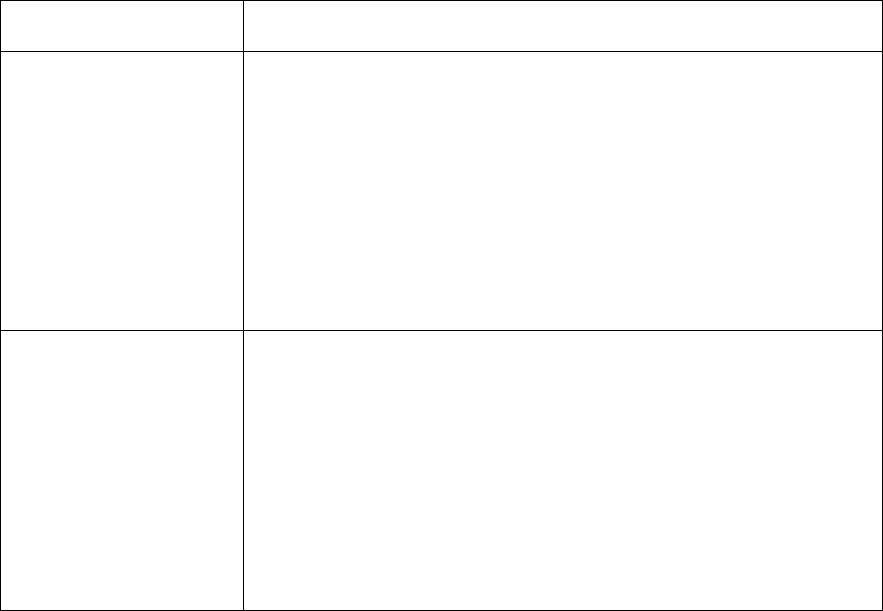
© 2010 HID Global Corporation All rights reserved
Reading the Serial Numbers on a Fargo Printer
You can determine when your card Printer was manufactured by reading directly from the serial number
(affixed to your card Printer).
Example Explanation
Reviewing Example
No. 1: Serial Number
A9050028 ( 2009)
• A9050028: The first two digits in the serial number indicate
the year the Printer was built (e.g., the digits A9 indicate the
year 2009).
• A9050028: The third and fourth digits in the serial number
indicate the week the Printer was built (e.g., the digits 05
indicate week 5th of that year).
• A9050028: The last four digits indicate the sequence
number for the numeric order in which the Printers were
built.
Reviewing Example
No. 2: Serial Number
B0050028 (2010)
• B0050028: The first two digits in the serial number indicate
the year the Printer was built (e.g., the digits B0 indicate the
year 2010).
• B0050028: The third and fourth digits in the serial number
indicate the week the Printer was built (e.g., the digits 05
indicate week 5th of that year).
• B0050028: The last four digits indicate the sequence
number for the numeric order in which the Printers were
built.
DTC4500 Card Printer/Encoder User Guide 104
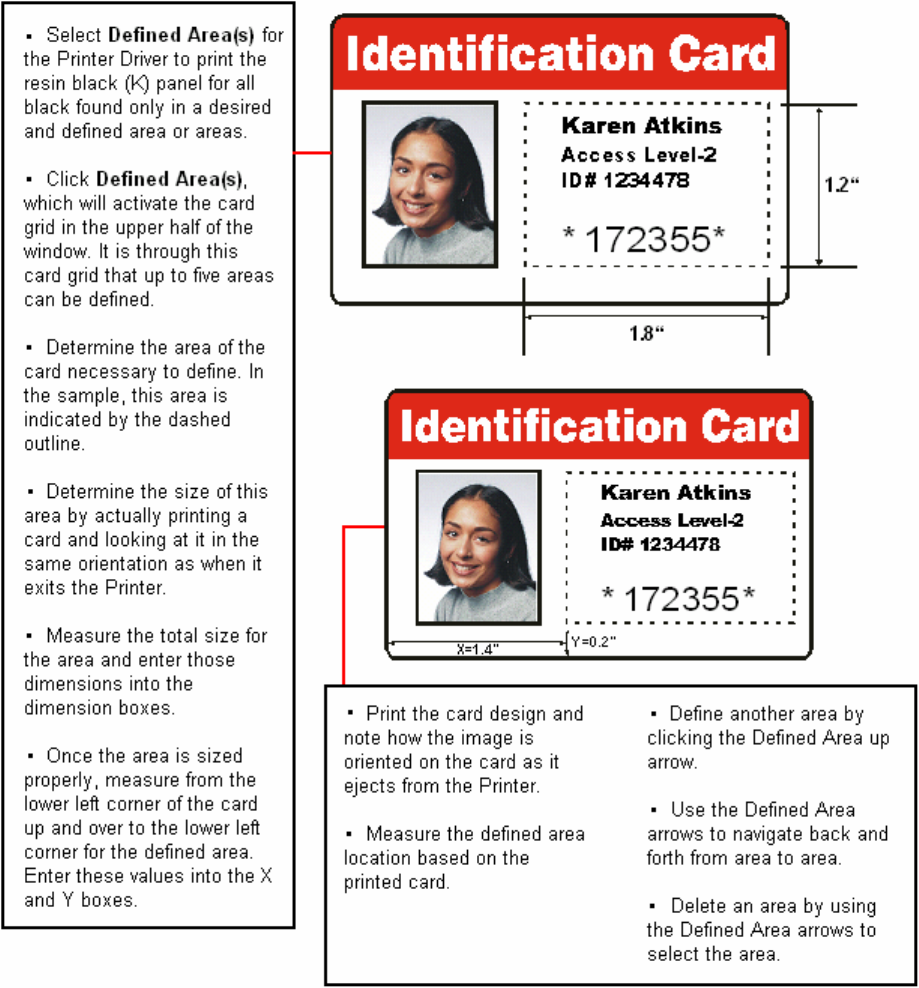
© 2010 HID Global Corporation All rights reserved
Appendix A
Using the Defined Area Option
This procedure can be used with the K Panel or the Overlay /Print Area procedure to define specific
areas. The K-Panel procedure is described below: The same process is used for the Overlay/Print Area
option.
DTC4500 Card Printer/Encoder User Guide 105
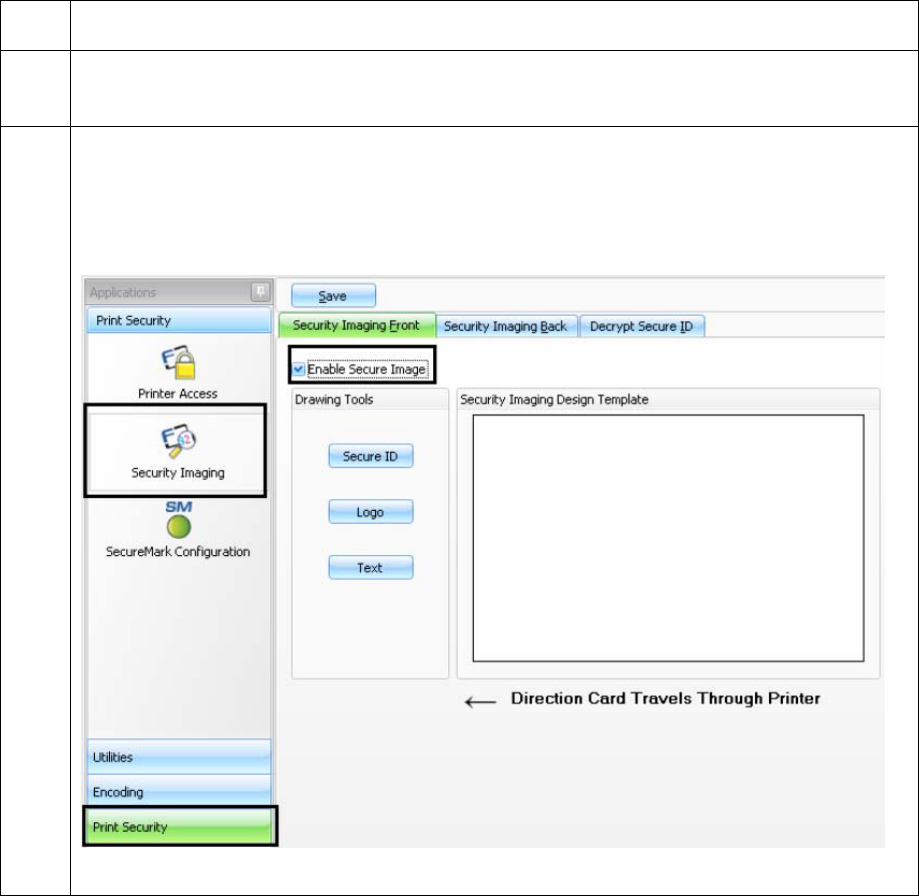
© 2010 HID Global Corporation All rights reserved
Configuring Fluorescent Data (F-Panel for YMCFKO
Ribbon) using the Workbench
Step Procedure
1 From the Driver Printing Preferences, click on Diagnostics to bring up the Fargo
Workbench Printer Utility.
2 a. Click the Print Security applet group and select the Security Imaging applet.
b. Check the Enable Secure Imaging checkbox. (Note: The option for both front
and back are set up the same way.)
DTC4500 Card Printer/Encoder User Guide 106
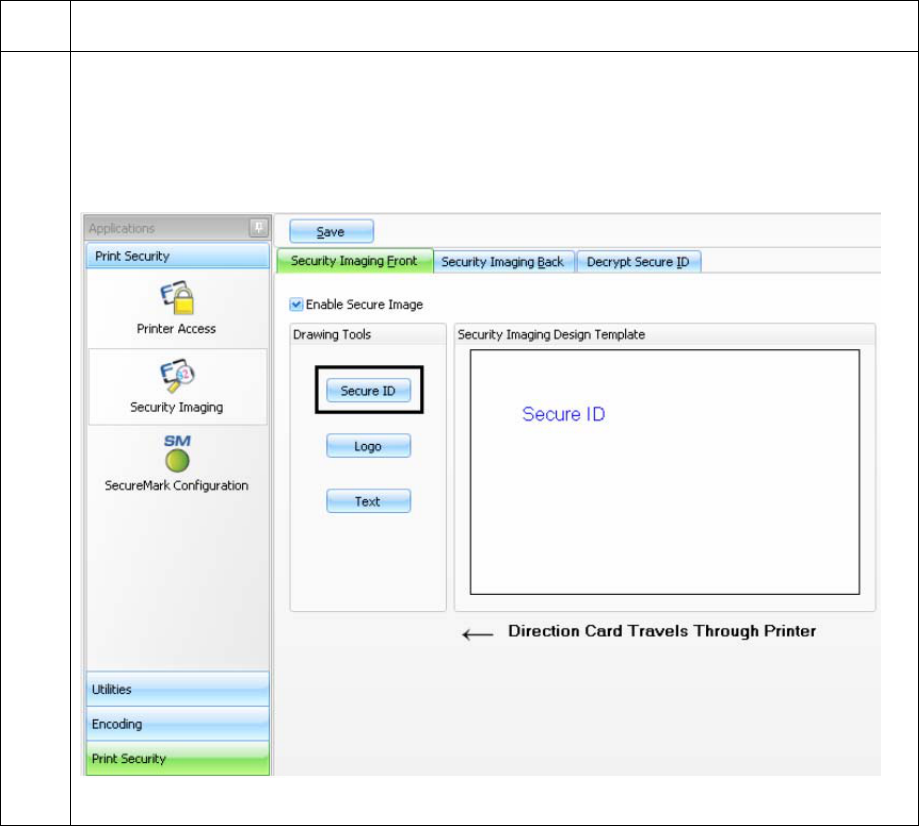
© 2010 HID Global Corporation All rights reserved
Configuring Fluorescent Data (F-Panel for YMCFKO Ribbon) using the Workbench
Step Procedure
3 a. Click on the Secure ID box on the left.
b. Click and drag a box onto the Template.
c. Move and size as needed.
DTC4500 Card Printer/Encoder User Guide 107
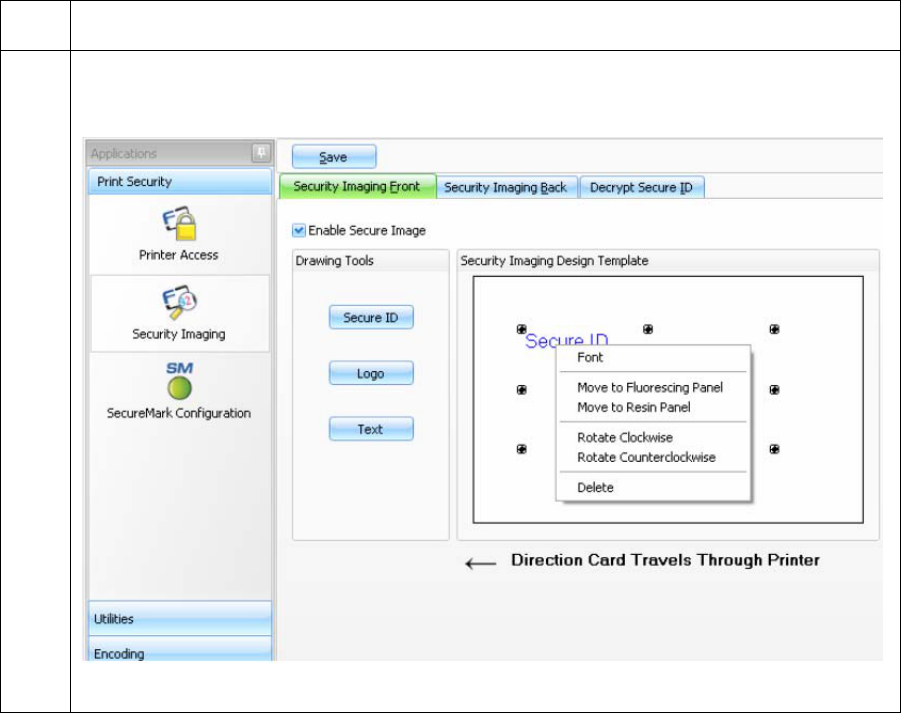
© 2010 HID Global Corporation All rights reserved
Configuring Fluorescent Data (F-Panel for YMCFKO Ribbon) using the Workbench
Step Procedure
4 On the Template, right click on the Secure ID box for the options.
DTC4500 Card Printer/Encoder User Guide 108
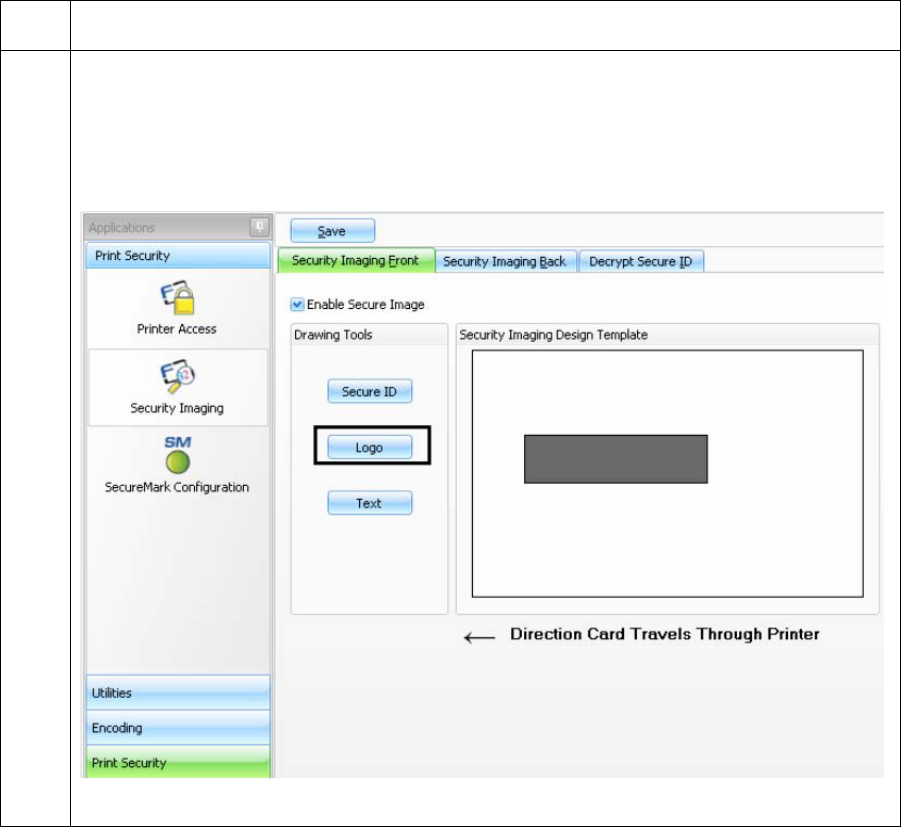
© 2010 HID Global Corporation All rights reserved
Configuring Fluorescent Data (F-Panel for YMCFKO Ribbon) using the Workbench
Step Procedure
5 a. Click on the Logo box on the left.
b. Click and drag a box onto the Template.
c. Move and size (as needed) by grabbing the corner of the box.
DTC4500 Card Printer/Encoder User Guide 109
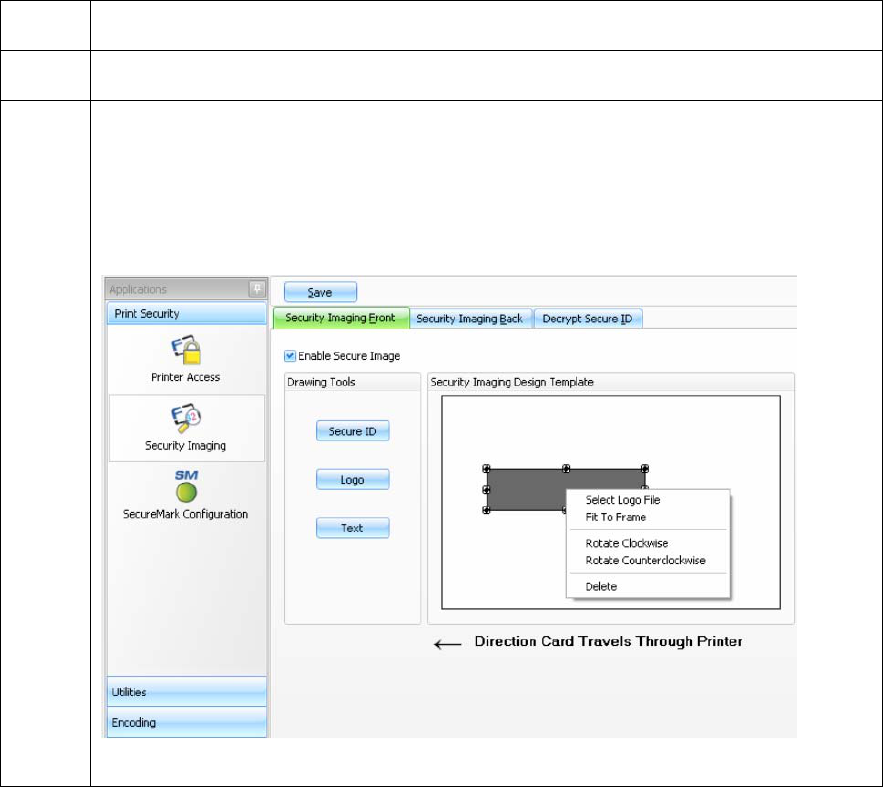
© 2010 HID Global Corporation All rights reserved
Configuring Fluorescent Data (F-Panel for YMCFKO Ribbon) using the Workbench
Step Procedure
6 On the Template right click on the Logo box for the options shown below.
7 Select the Logo File.
Find the source of the Logo to place on the card. (Note: Fit to Frame will size
the image to fit the box. Once this is set up, this logo will print from the
software program. This is set up in the background.)
DTC4500 Card Printer/Encoder User Guide 110
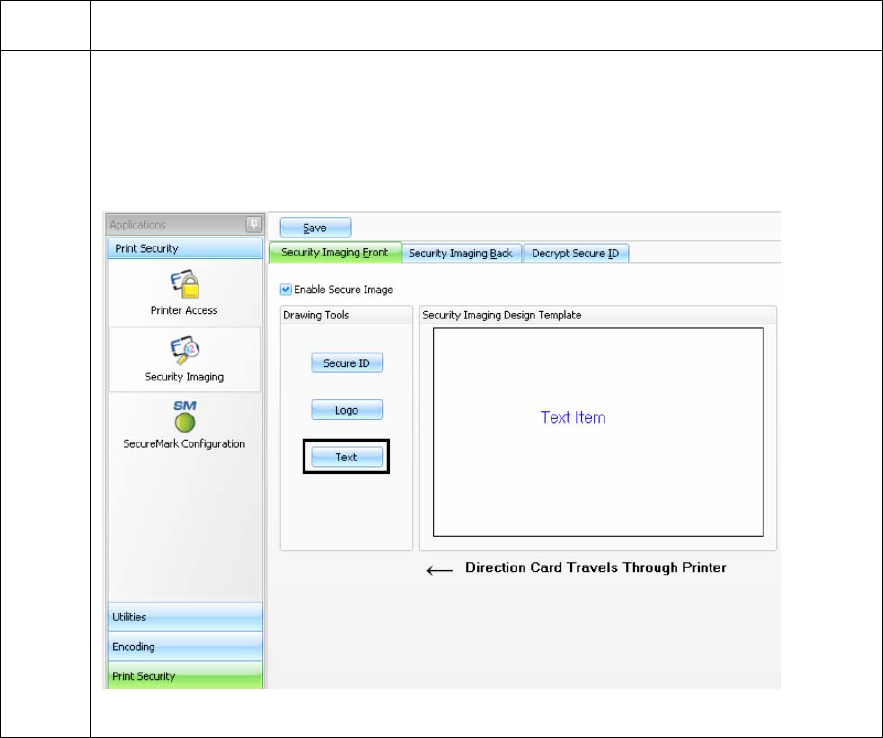
© 2010 HID Global Corporation All rights reserved
Configuring Fluorescent Data (F-Panel for YMCFKO Ribbon) using the Workbench
Step Procedure
8 a. Click on the Text box on the left.
b. Click and drag a box onto the Template.
c. Move and size as needed.
DTC4500 Card Printer/Encoder User Guide 111
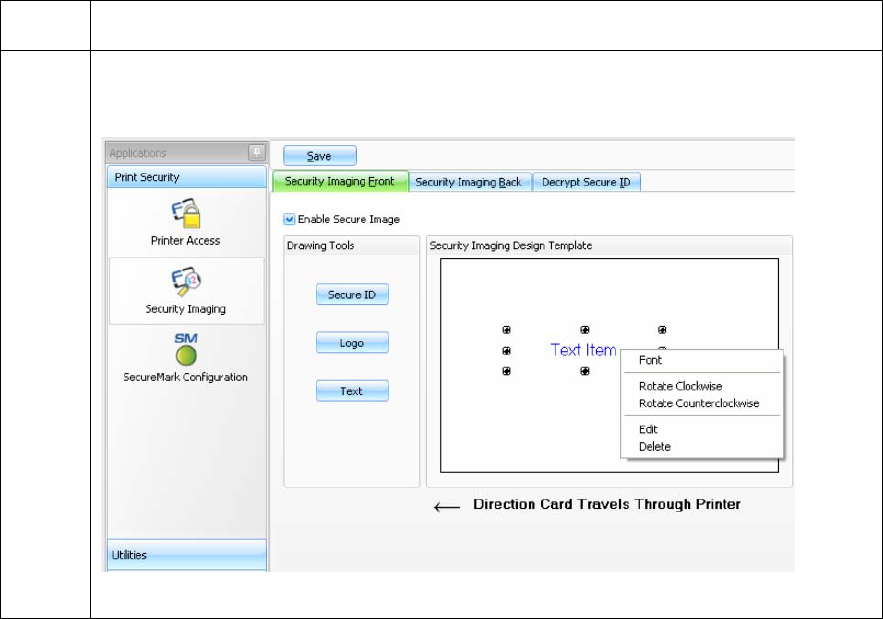
© 2010 HID Global Corporation All rights reserved
Configuring Fluorescent Data (F-Panel for YMCFKO Ribbon) using the Workbench
Step Procedure
9 On the Template, right click on the Text box for the options.
DTC4500 Card Printer/Encoder User Guide 112
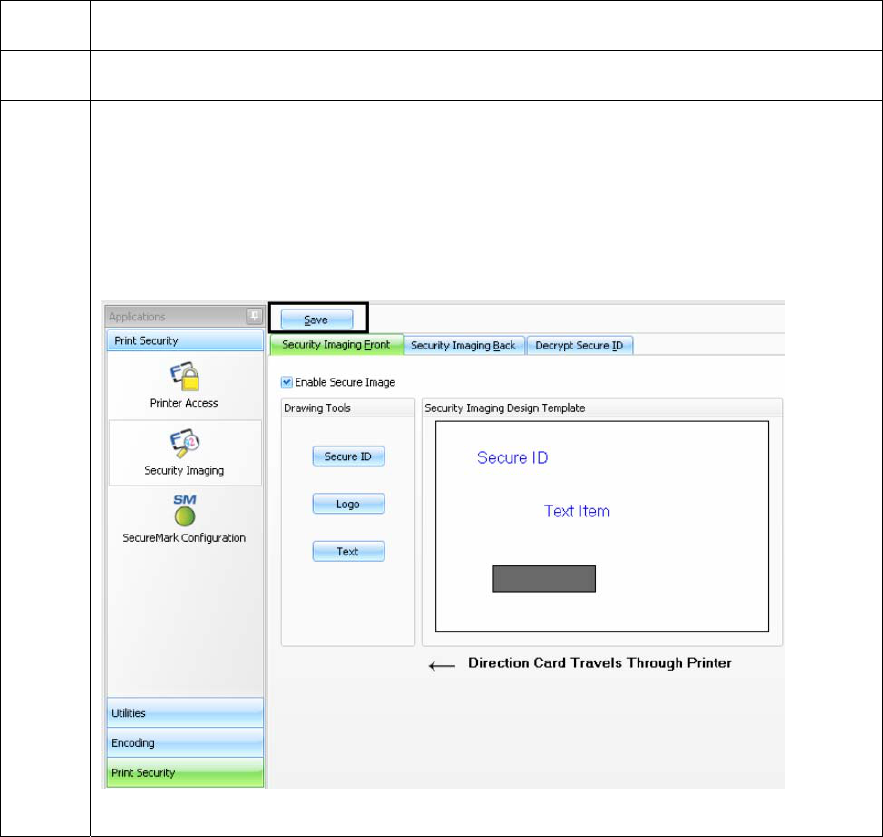
© 2010 HID Global Corporation All rights reserved
Configuring Fluorescent Data (F-Panel for YMCFKO Ribbon) using the Workbench
Step Procedure
10 Follow the same instruction as above for the back side of the card.
11 a. Save this template using the Save button
b. Close the Workbench. (Note: Any Software program file printed with the
YMCFKO Ribbon installed into the Printer will print this design with the F-
Panel of the Ribbon. It will print the same file each time unless you recreate
a new template.)
DTC4500 Card Printer/Encoder User Guide 113
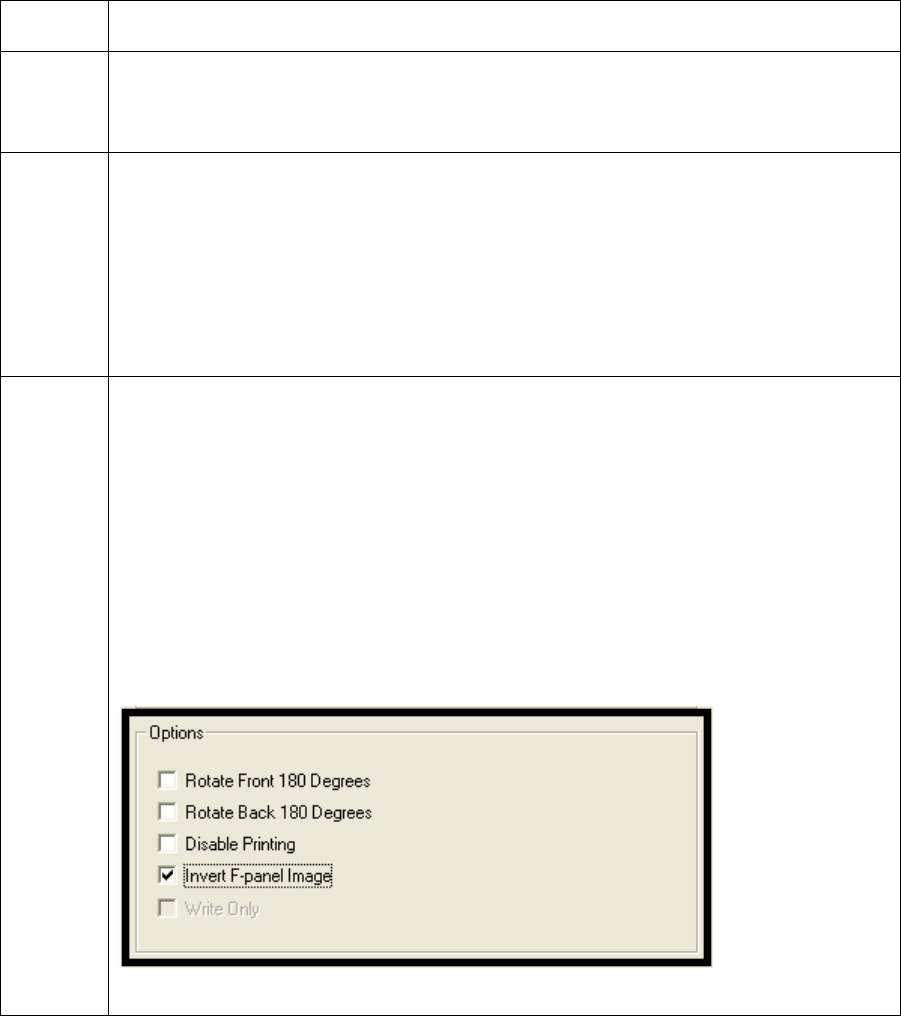
© 2010 HID Global Corporation All rights reserved
DTC4500 Card Printer/Encoder User Guide 114
Configuring Fluorescent Data (F-Panel for YMCFKO Ribbon) using the Workbench
Step Procedure
12 Set the Ribbon for YMCFKO in the Printing Preferences. (Note: The Detect
Supplies at Print Time button may also be used. The F-Panel Ribbon must be
installed for this process to work.)
13 Check Dual Pass if you would like to print the F-Panel on a separate panel of
HDP film from the YMC image.
You should use the default Dual Pass option:
If the fluorescent image is used in places where other dye is used.
OR
Any time the Invert F-Panel Image option is selected.
14 Check Invert F-Panel Image to create a negative of the fluorescent image.
• This refers to the ability to cause light or white areas of the image to
fluoresce and dark colors to remain dark on the printed card when exposed
to a UV light.
• This was requested because the fluorescent dye color is bright when black
light is applied to it.
• By default, the dark areas of the image will fluoresce on the card and the
lighter or white areas will have no dye applied. (Note: This may improve
the look of the person’s image if used for the Logo.)